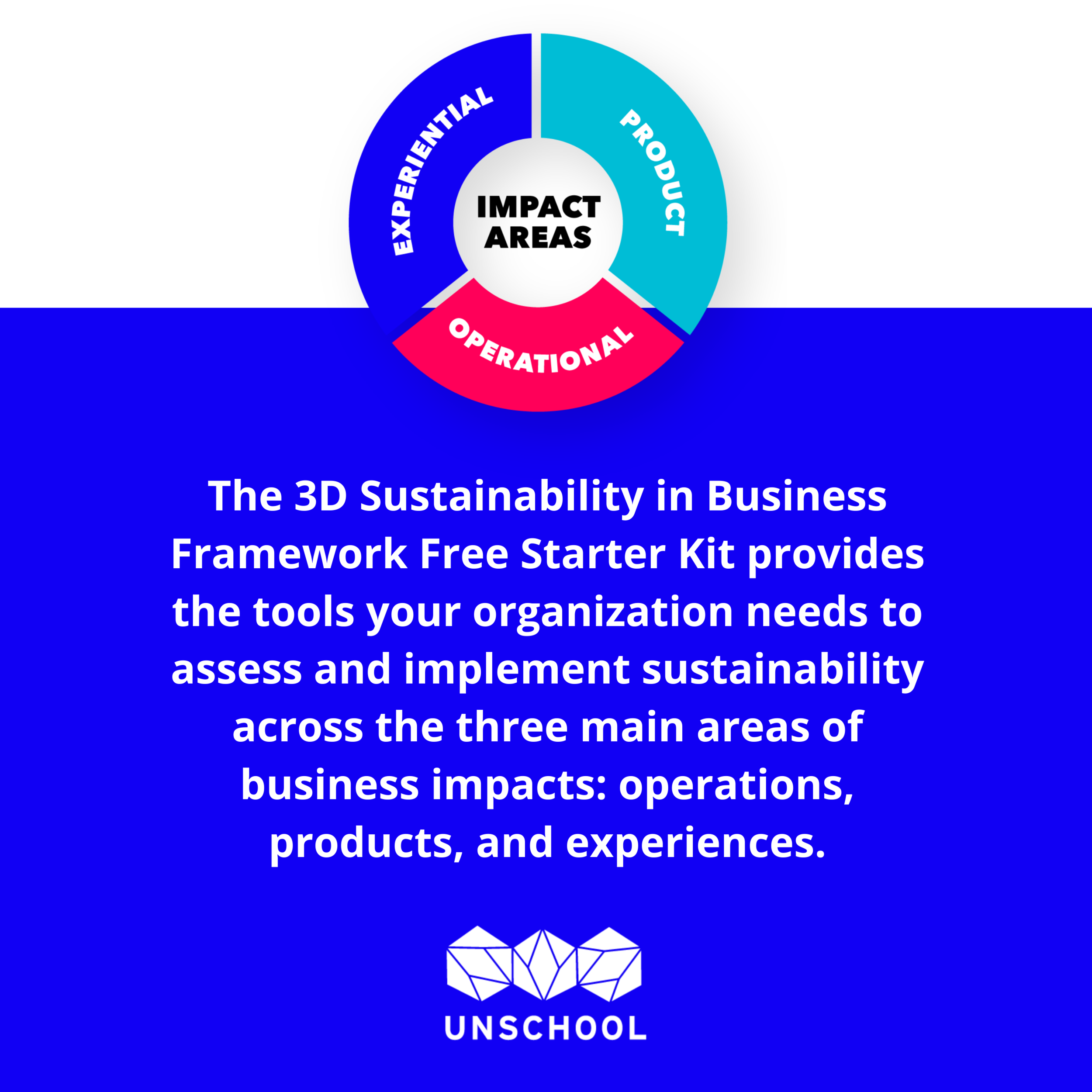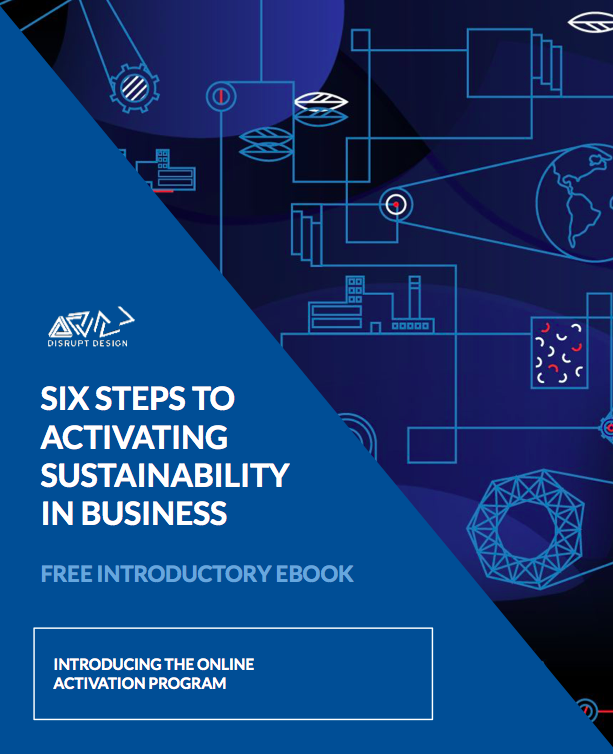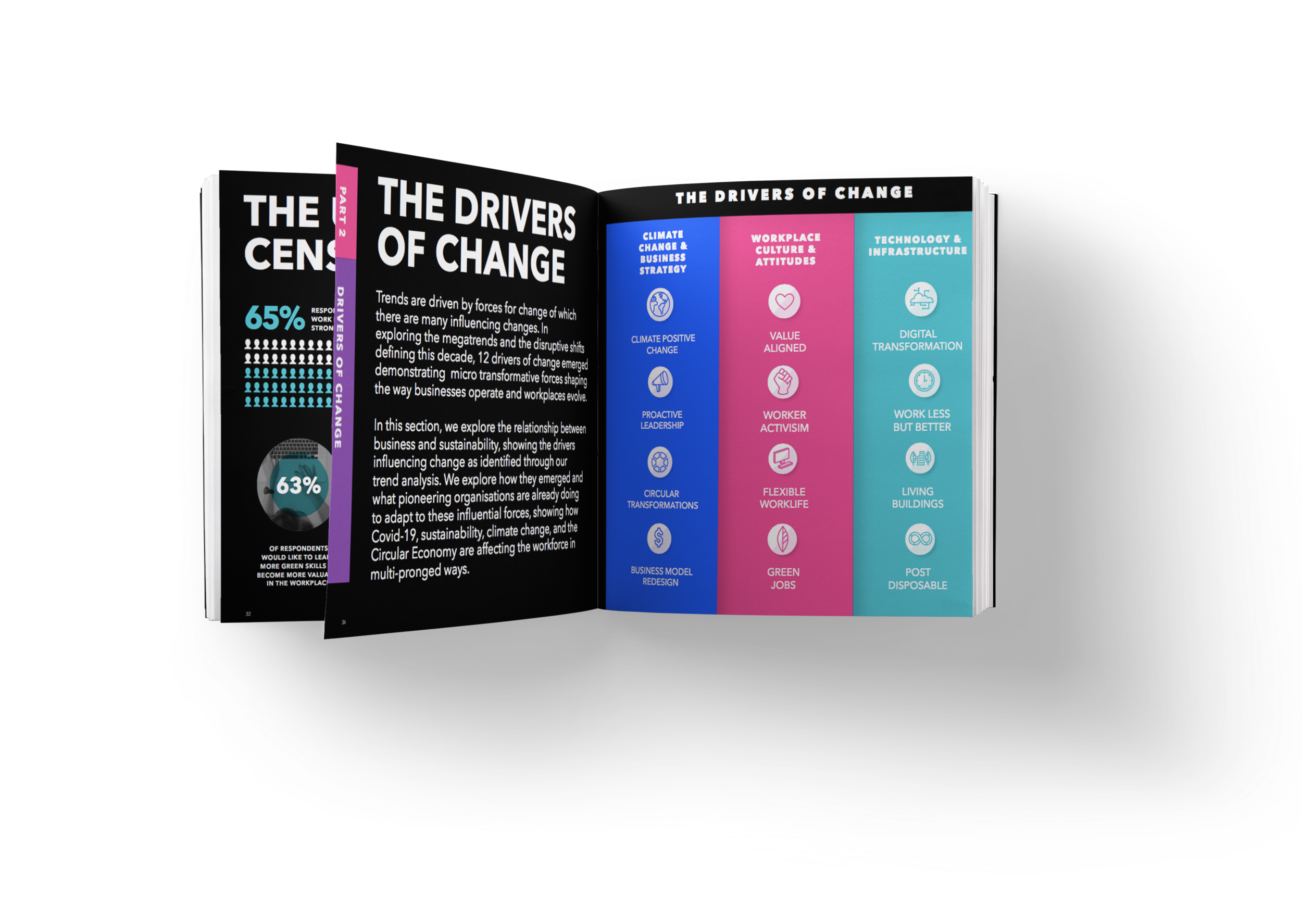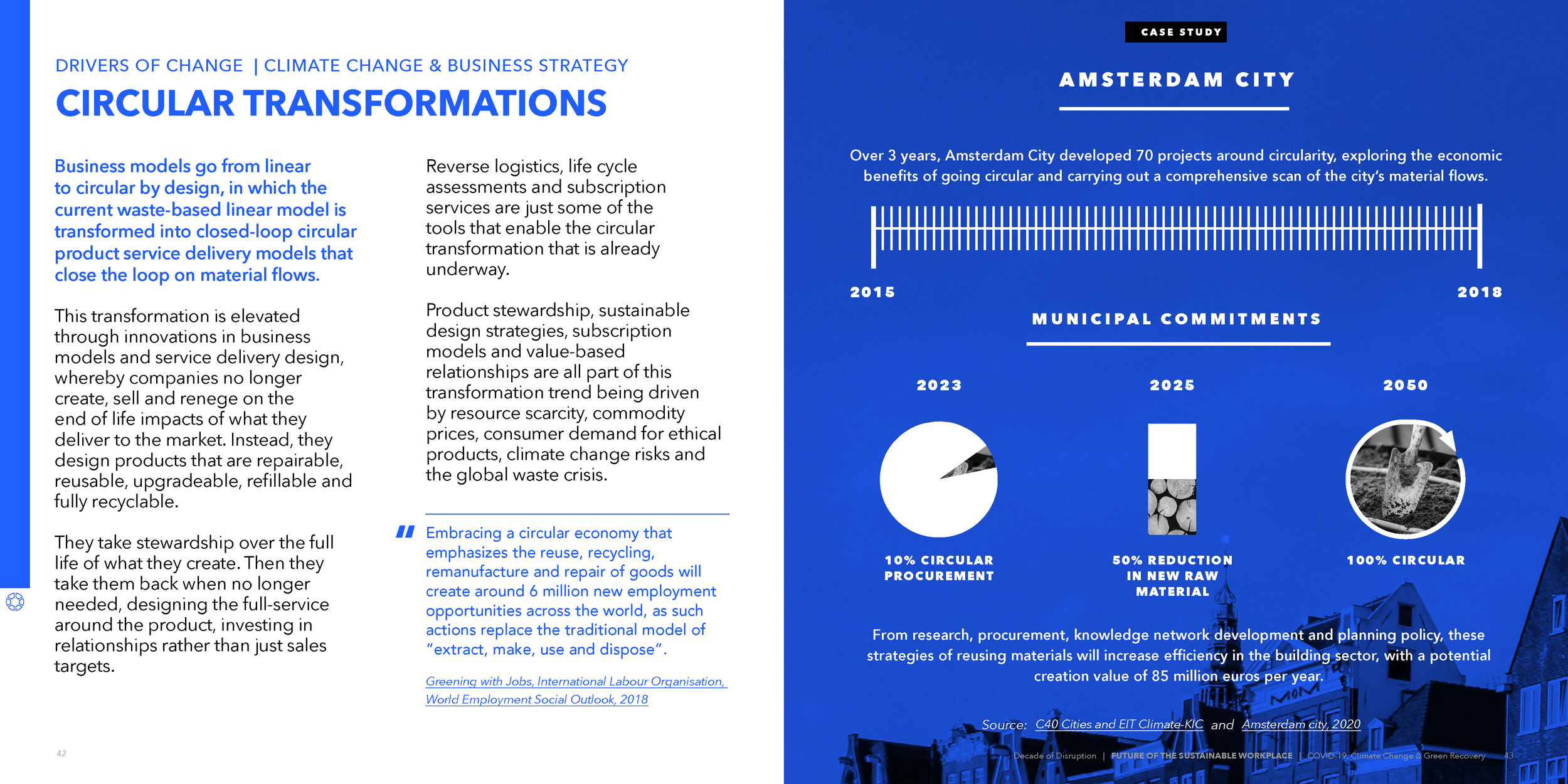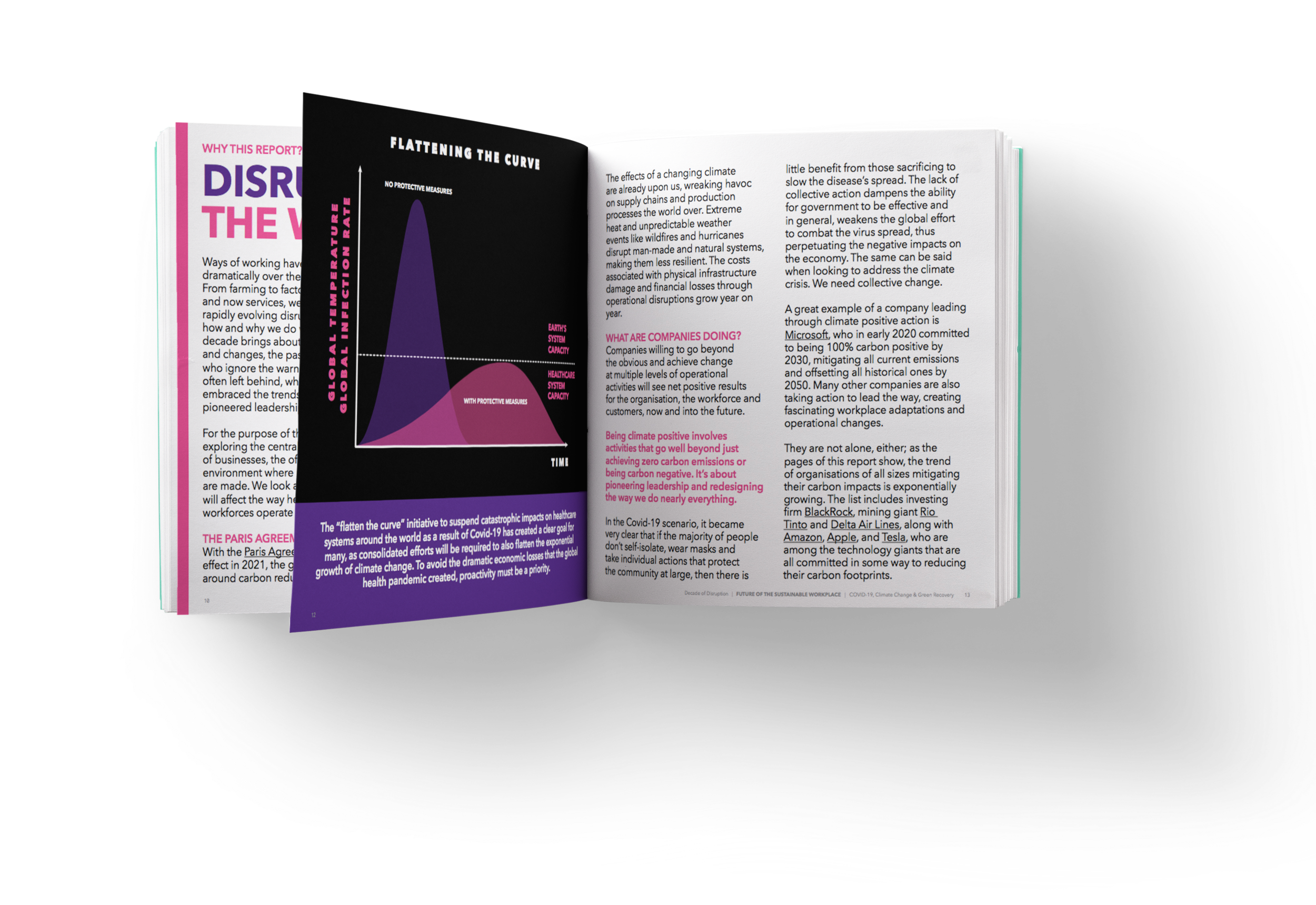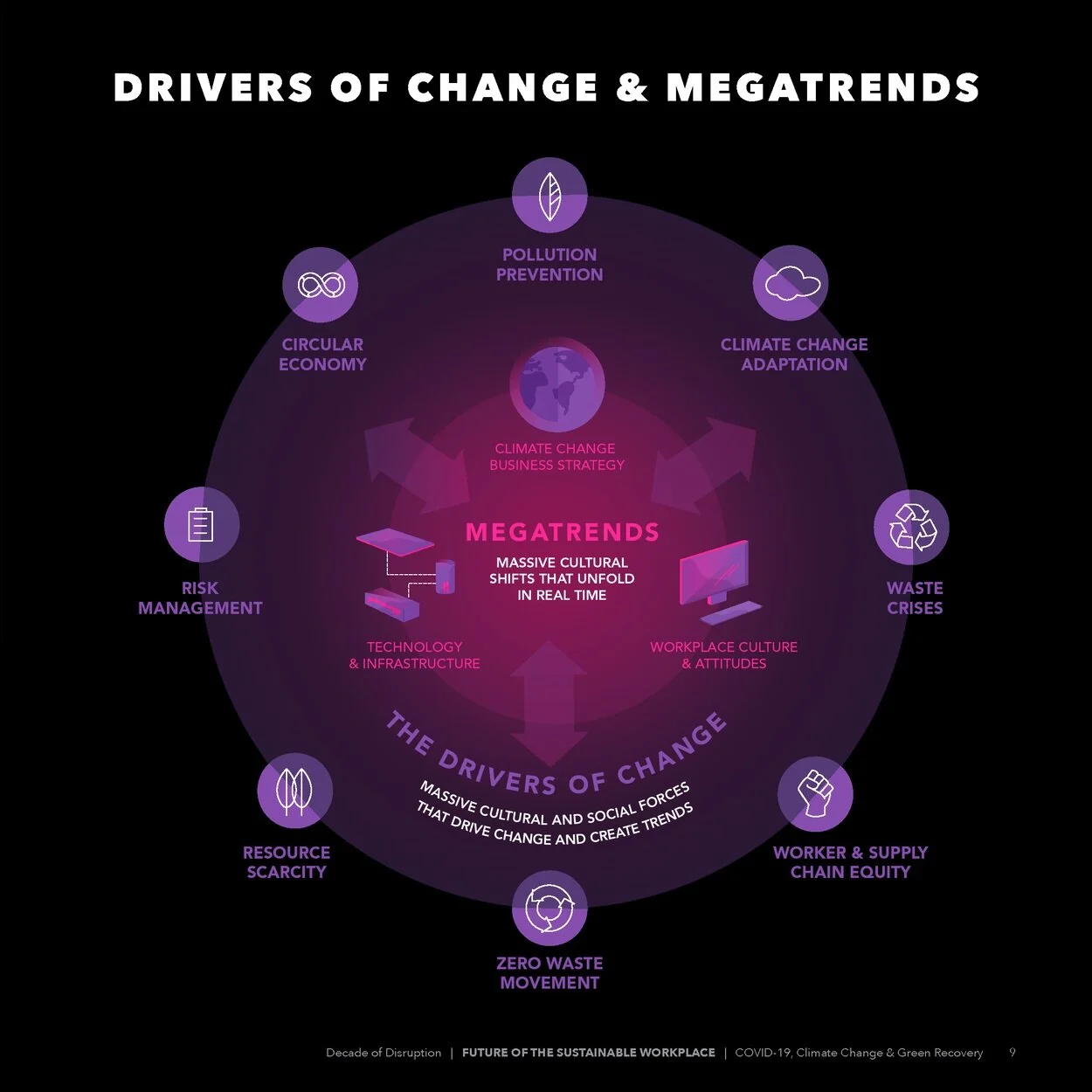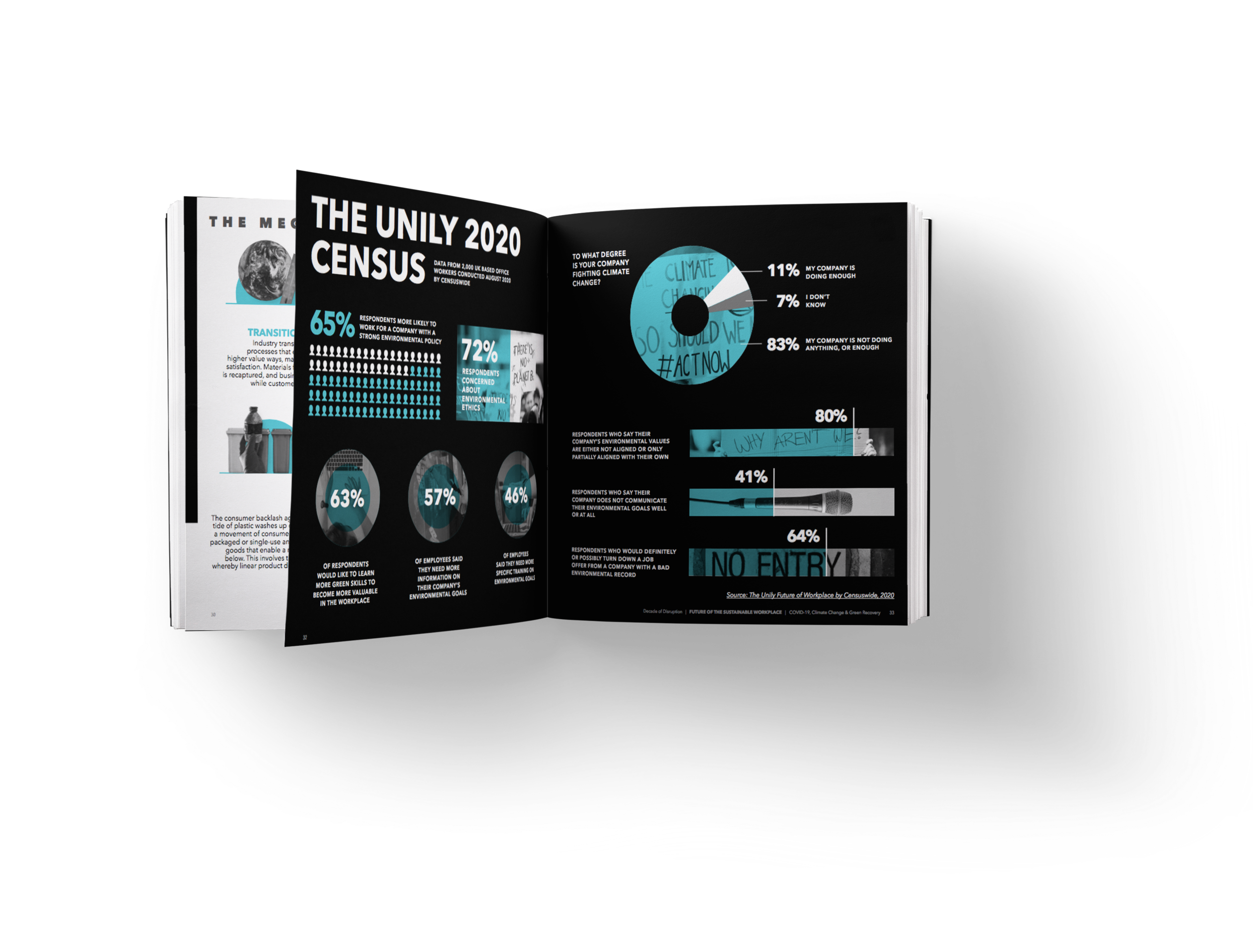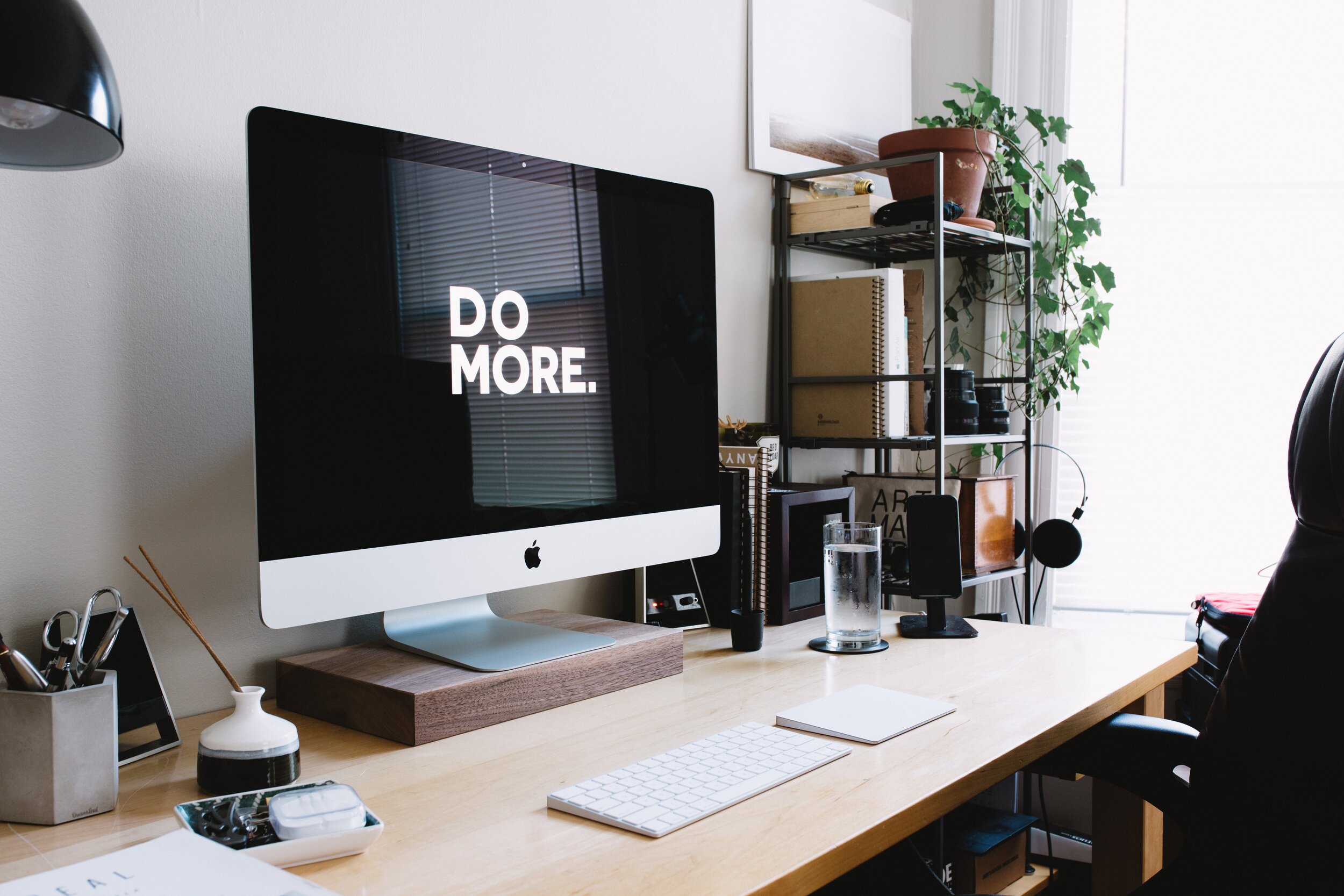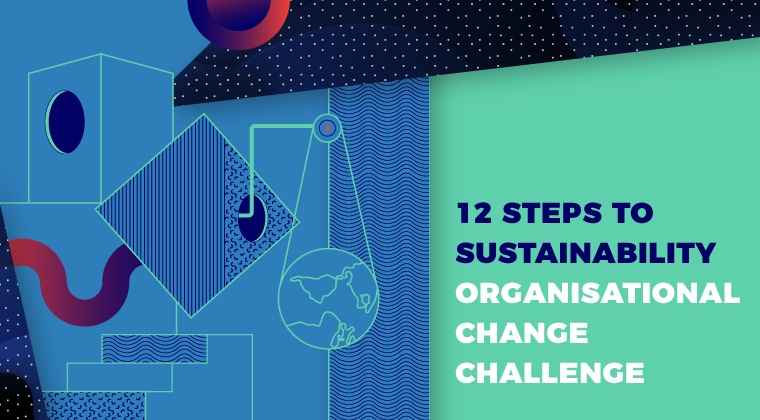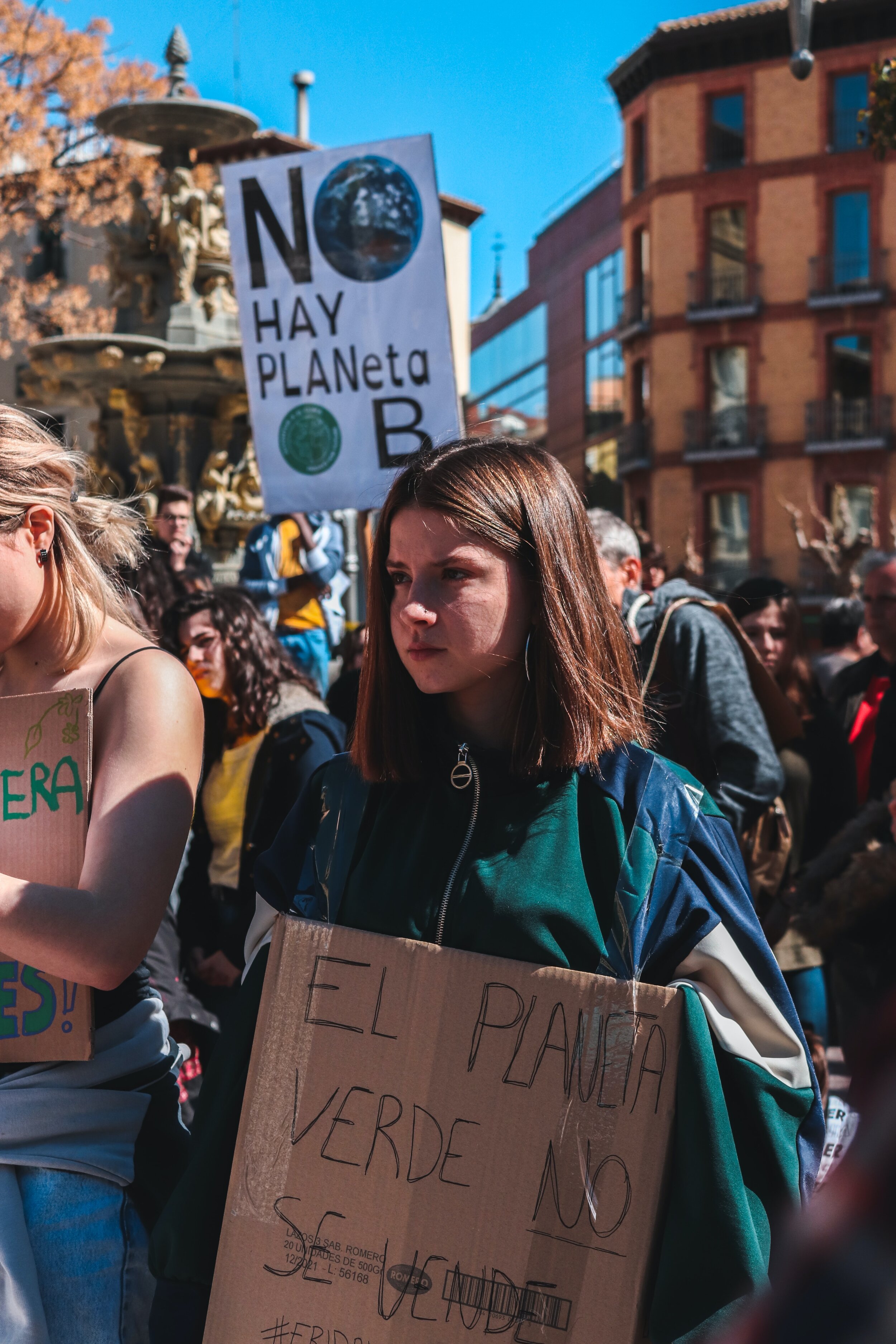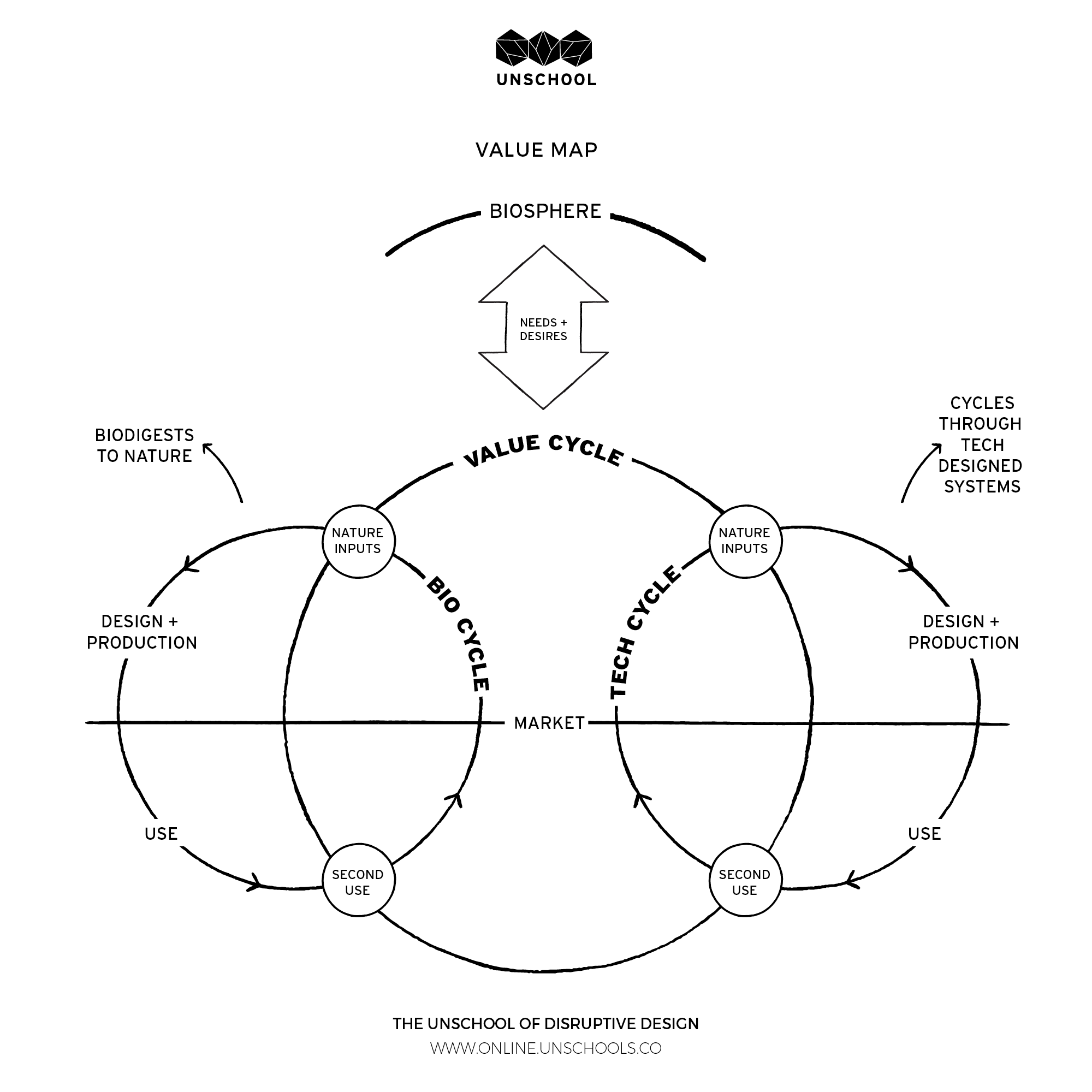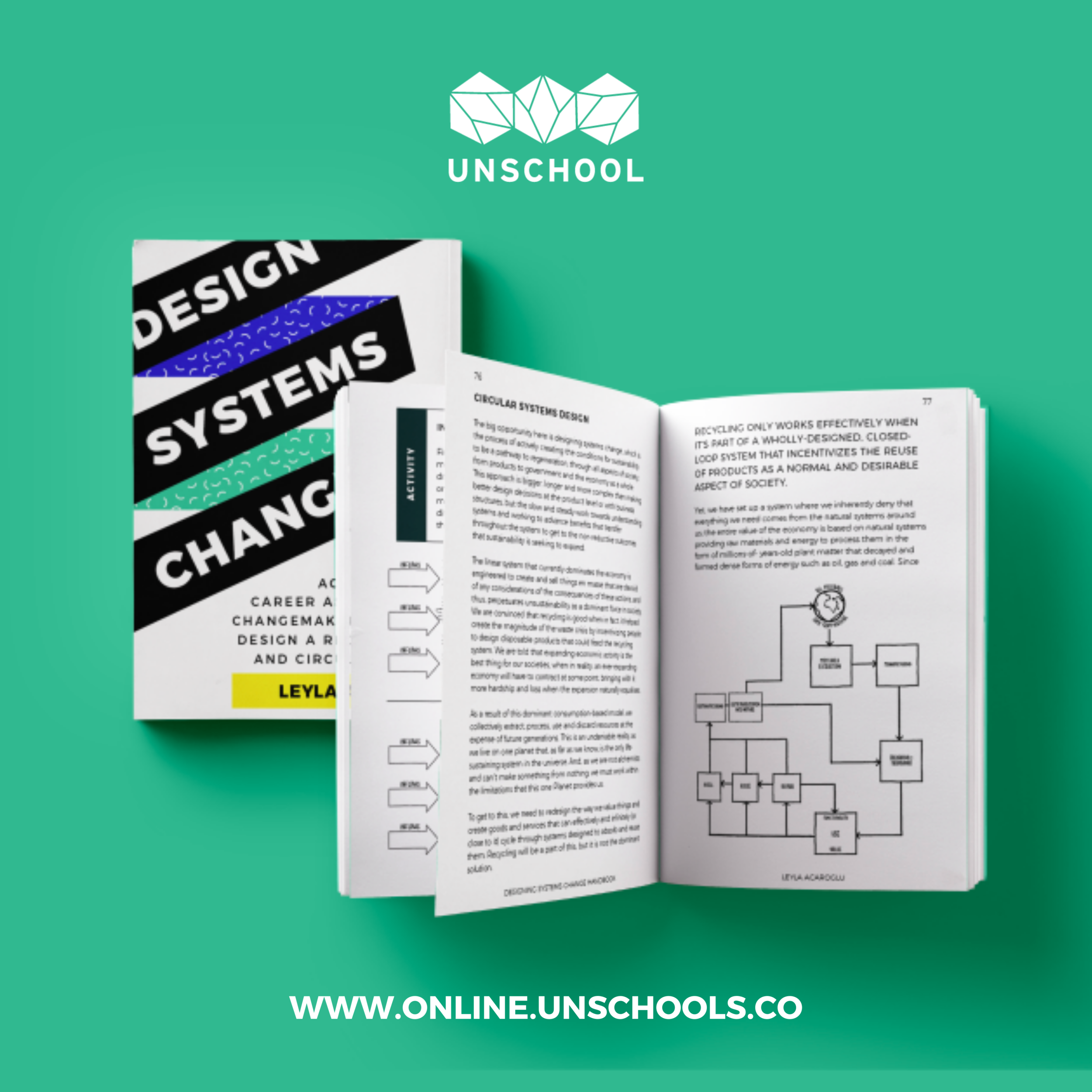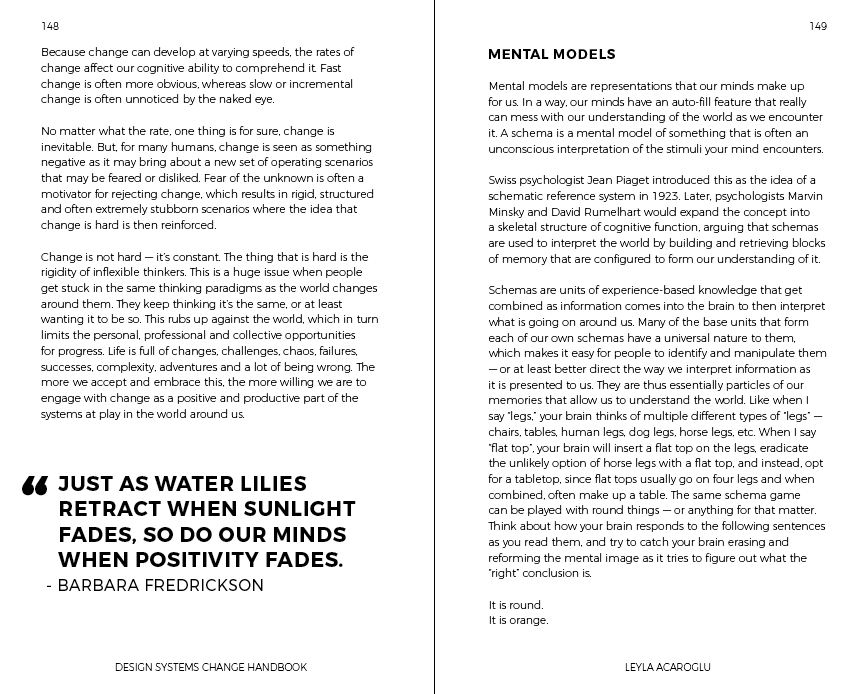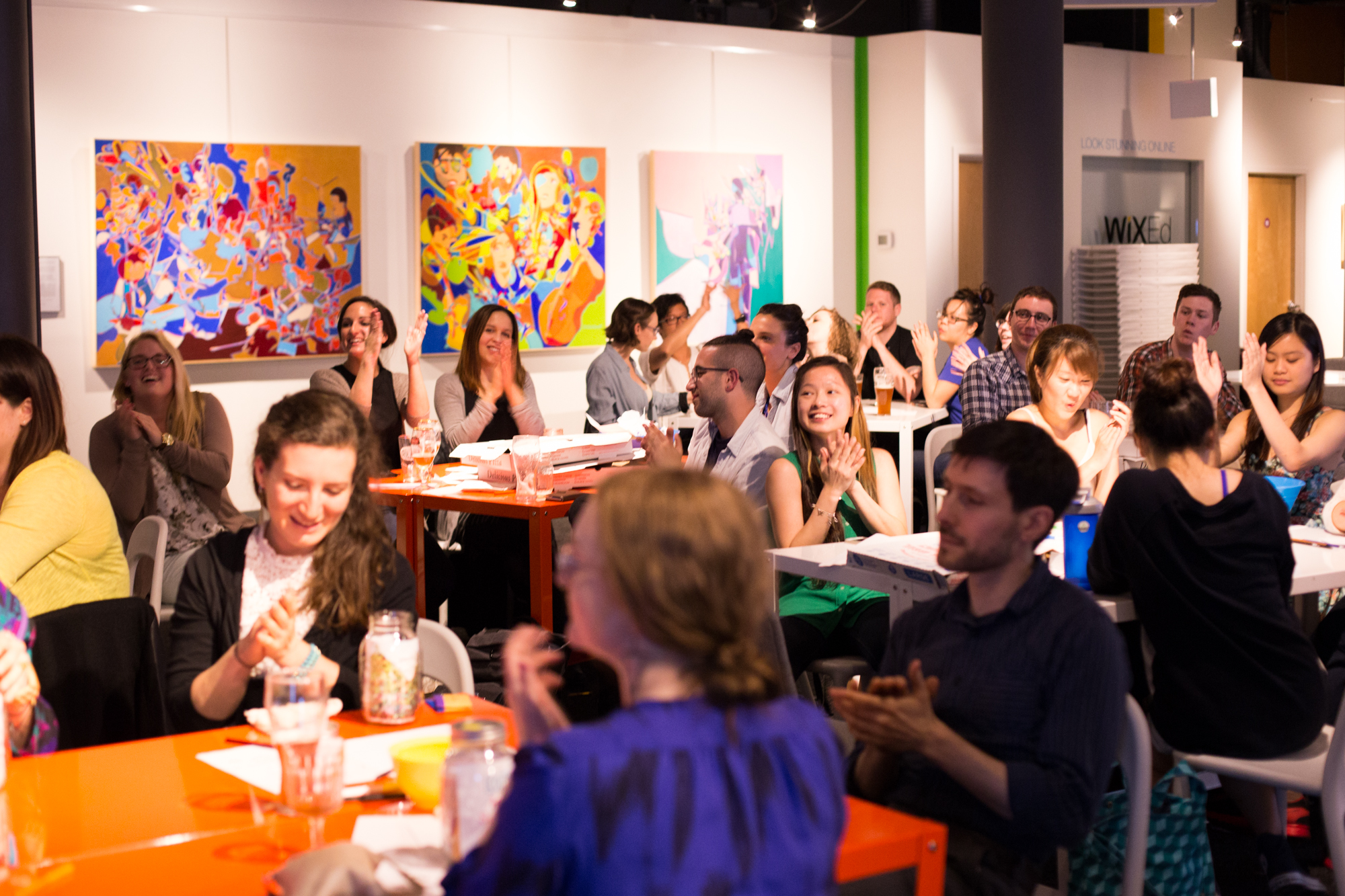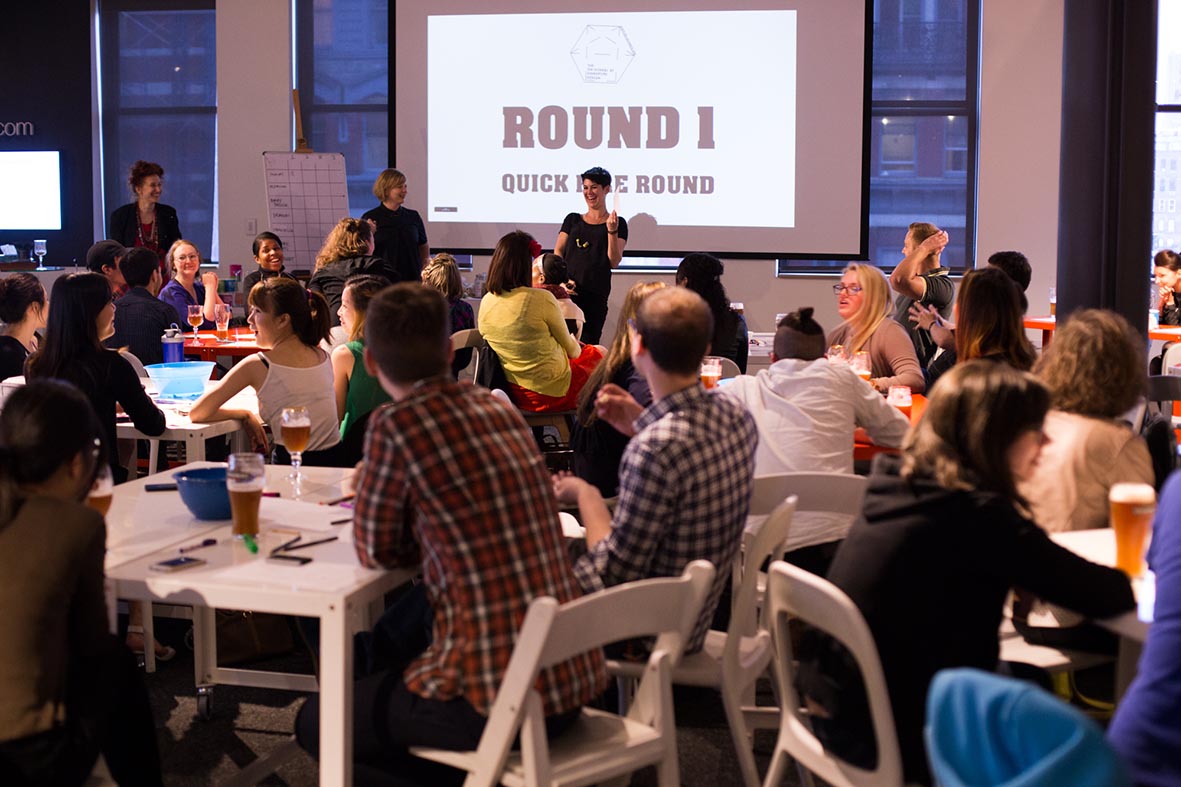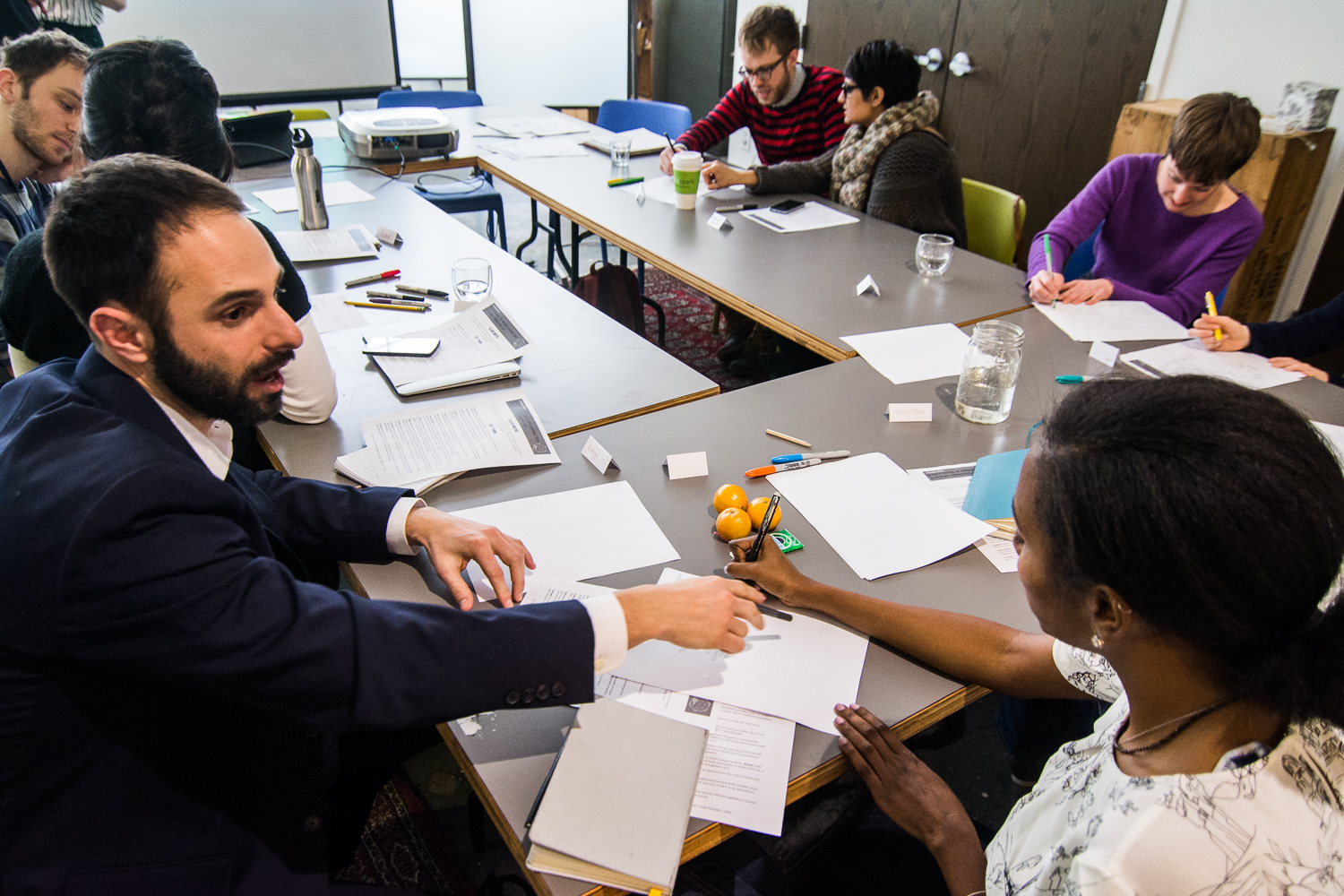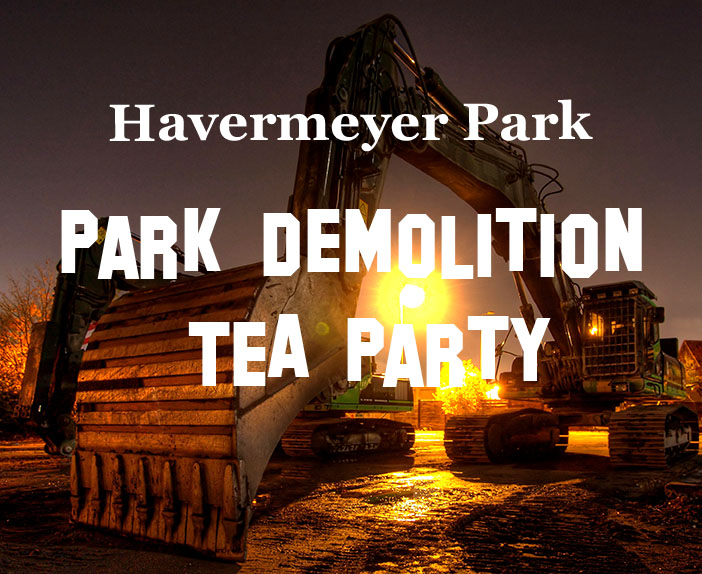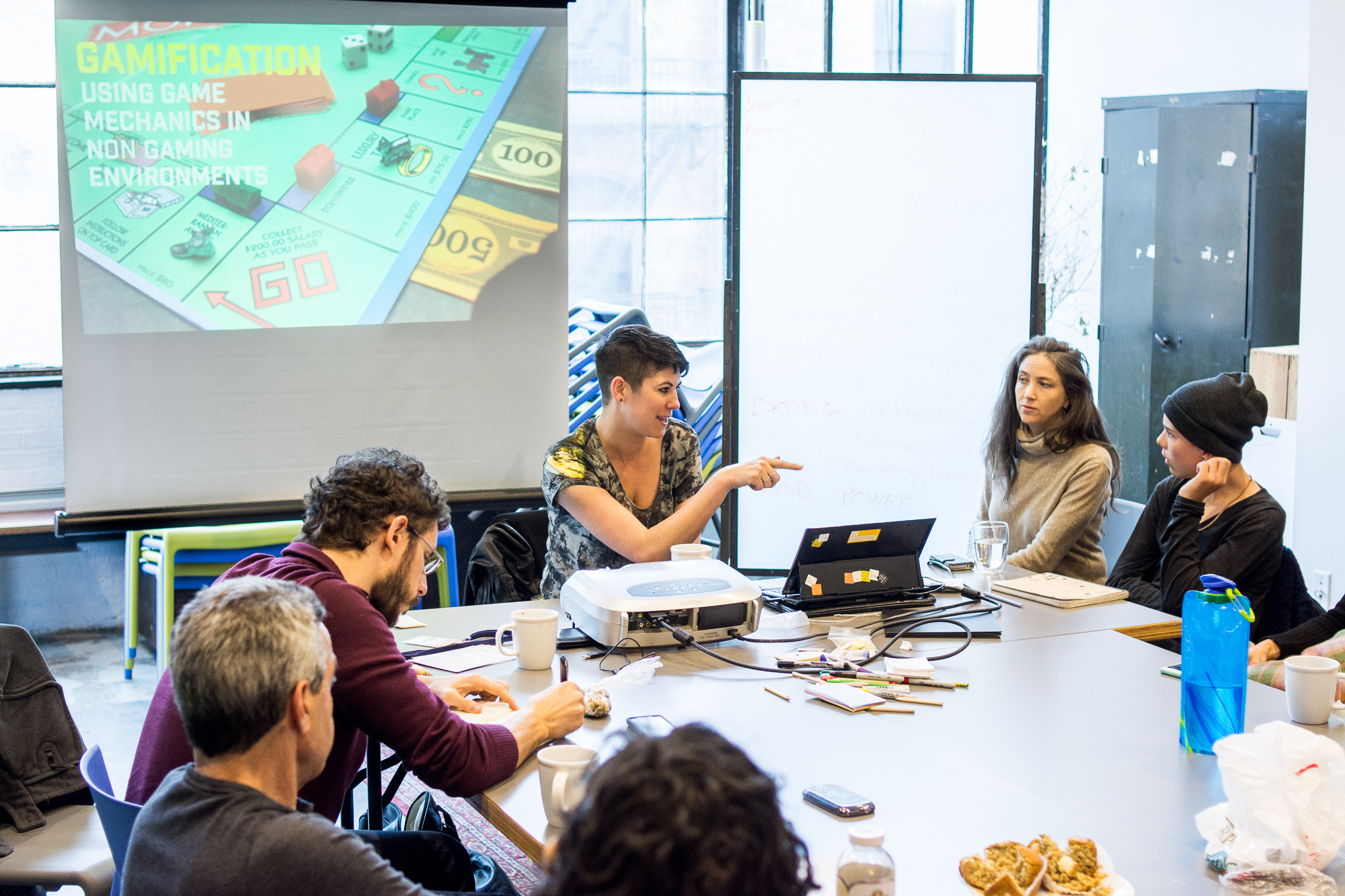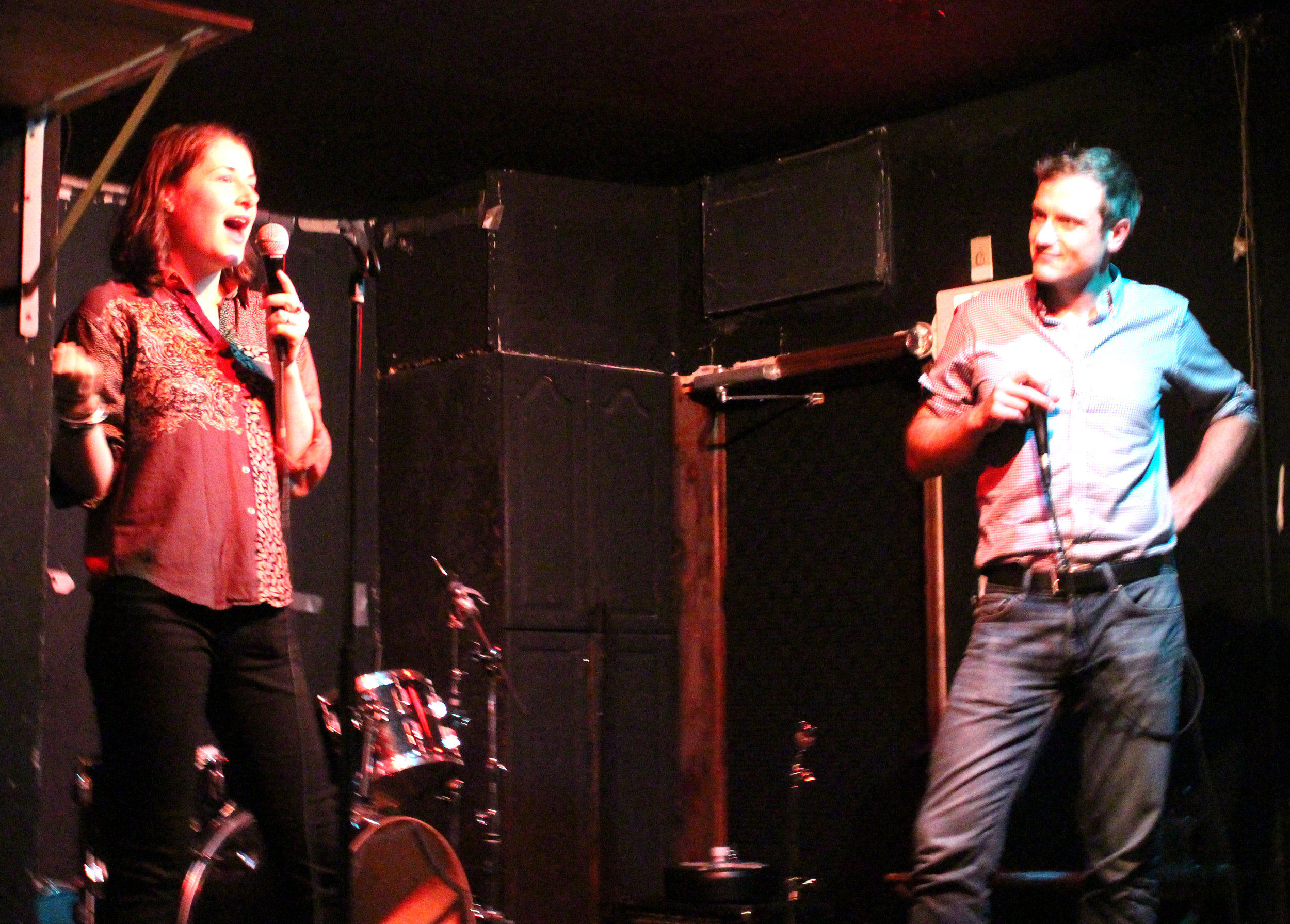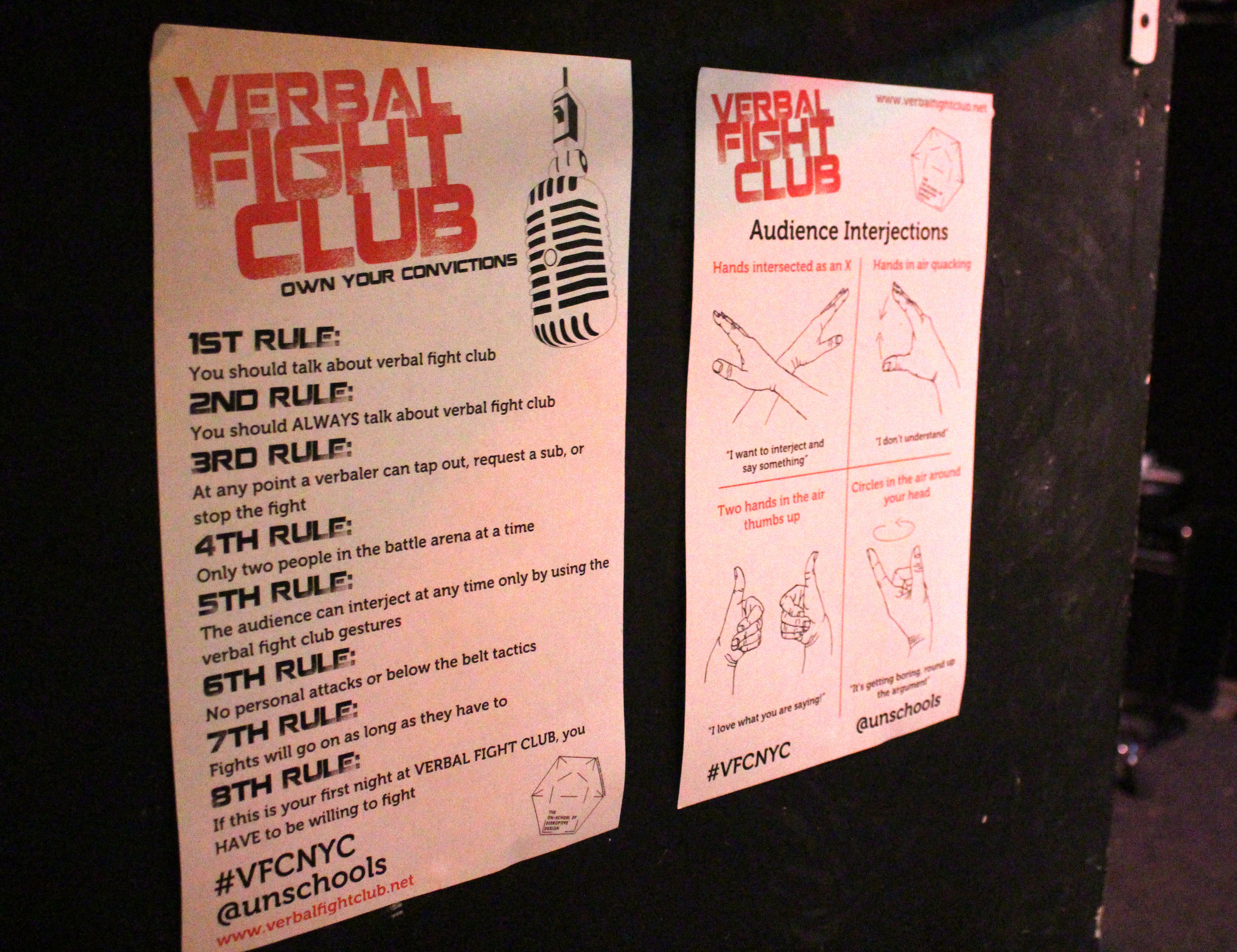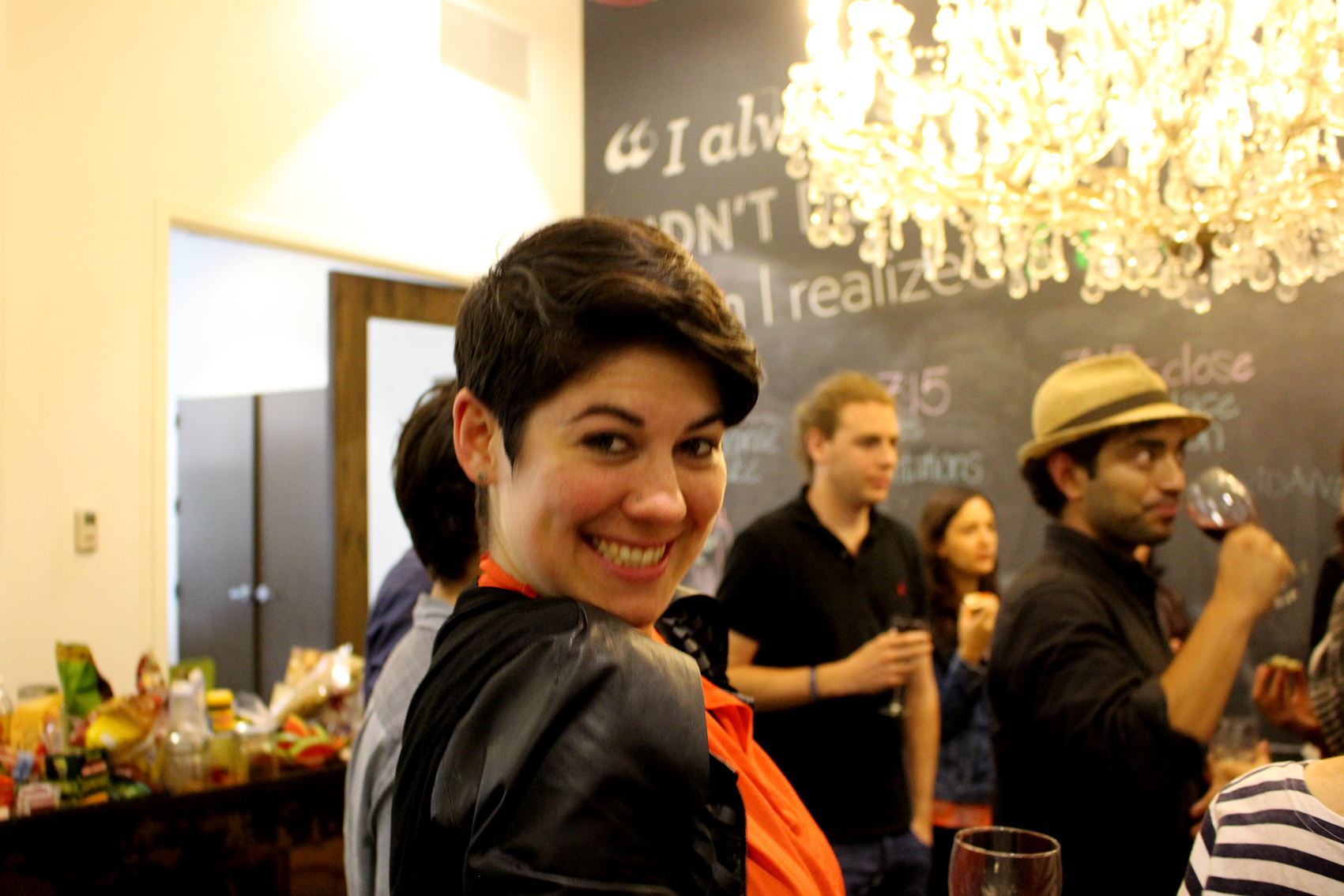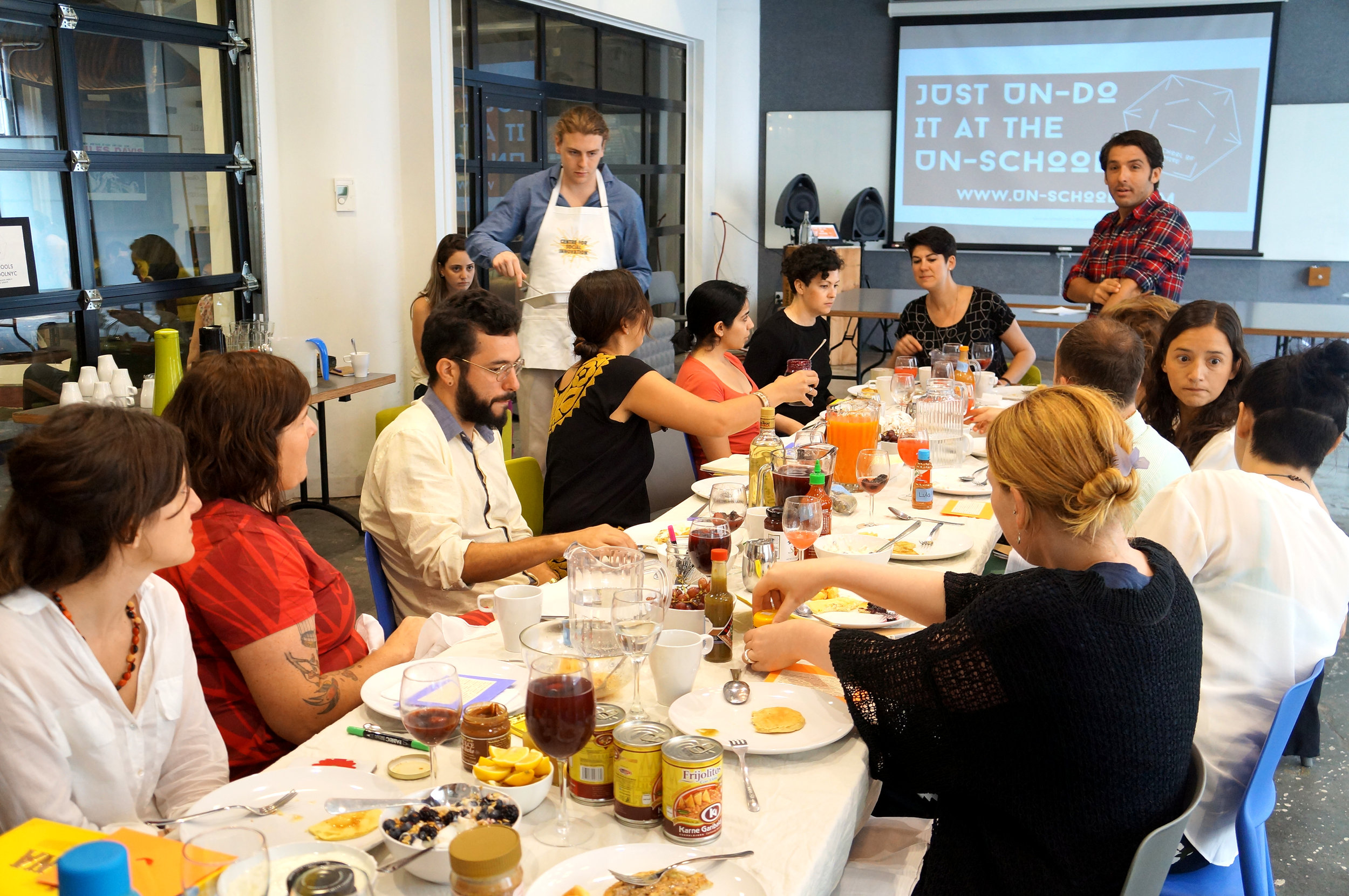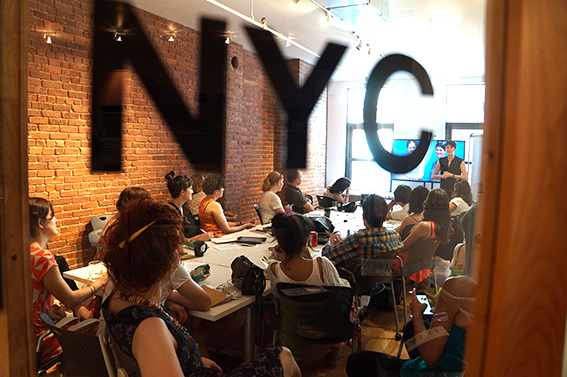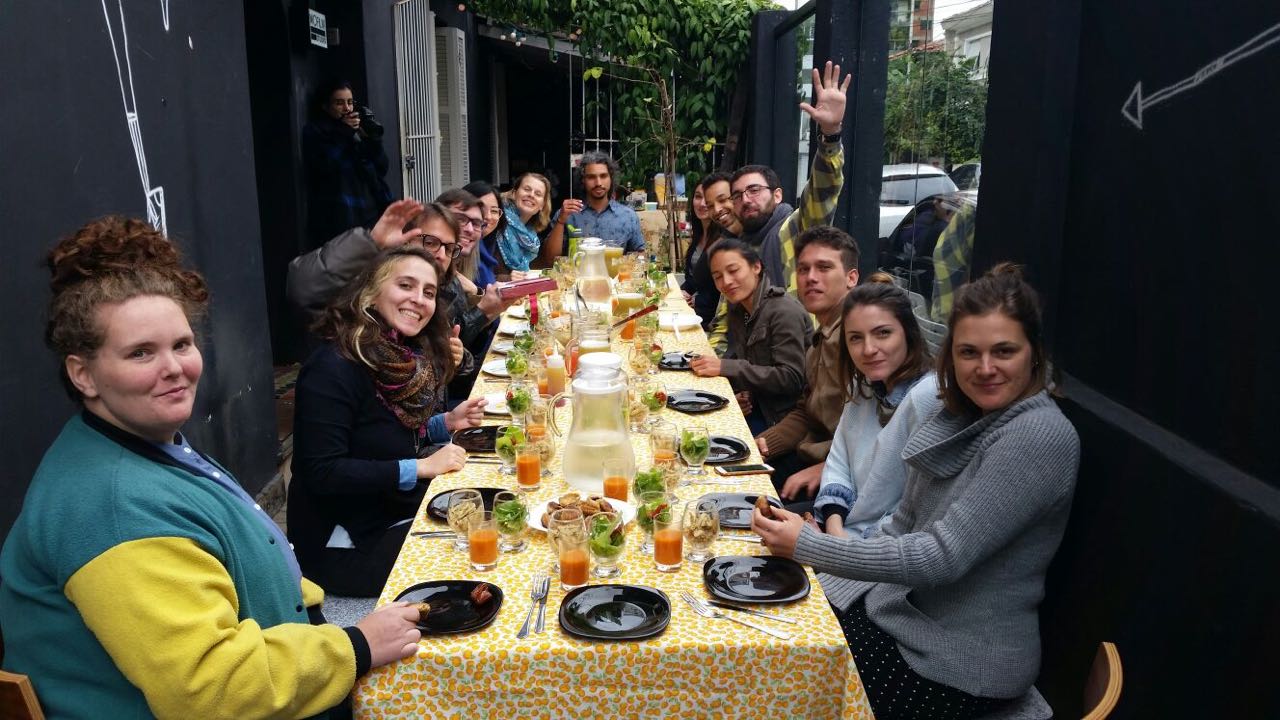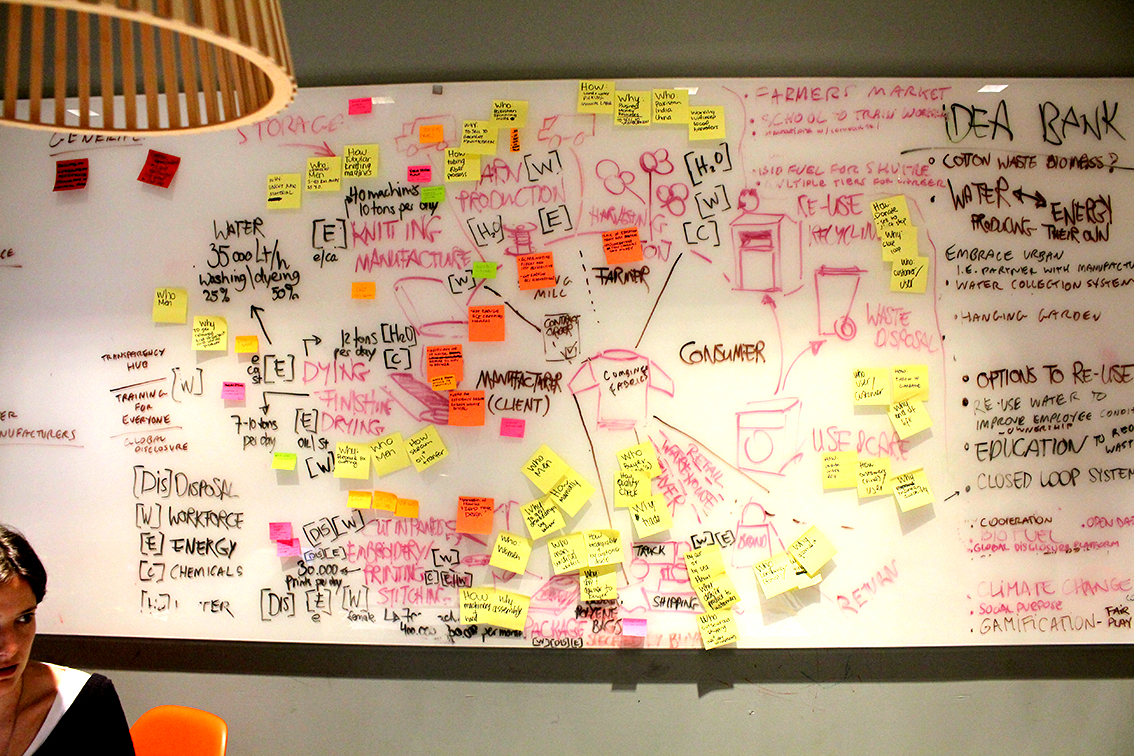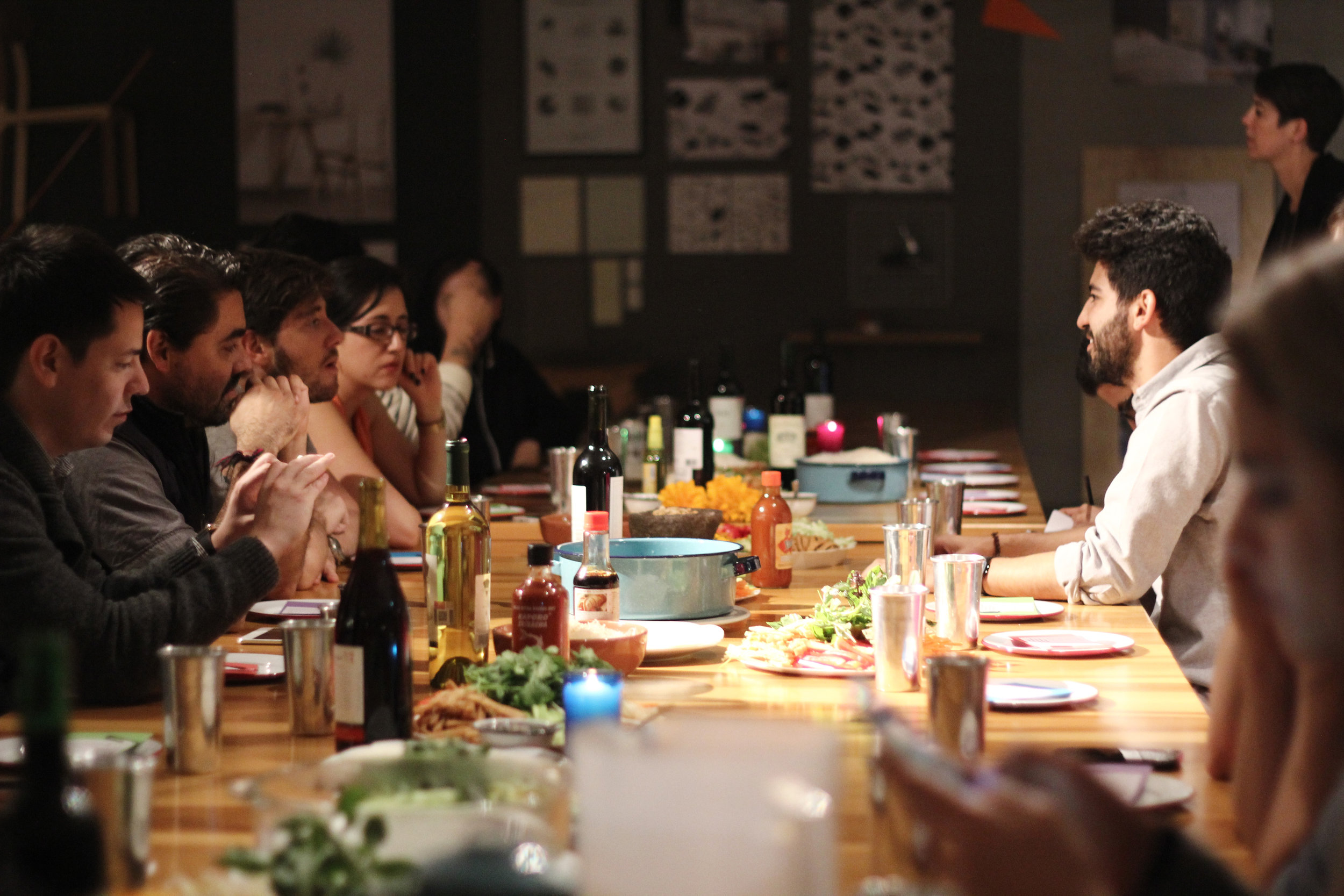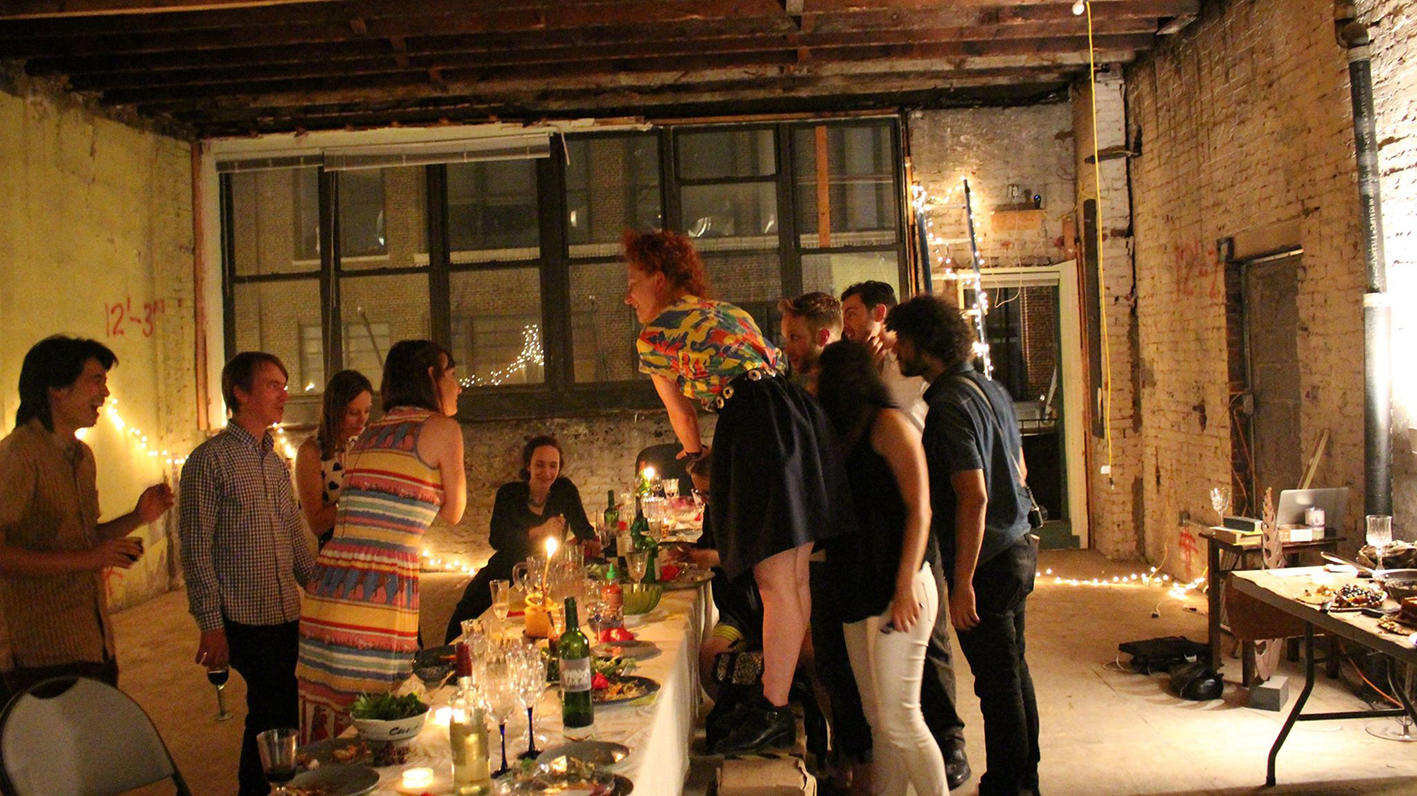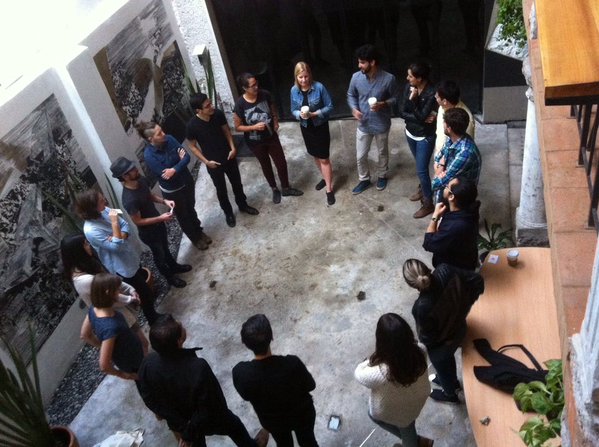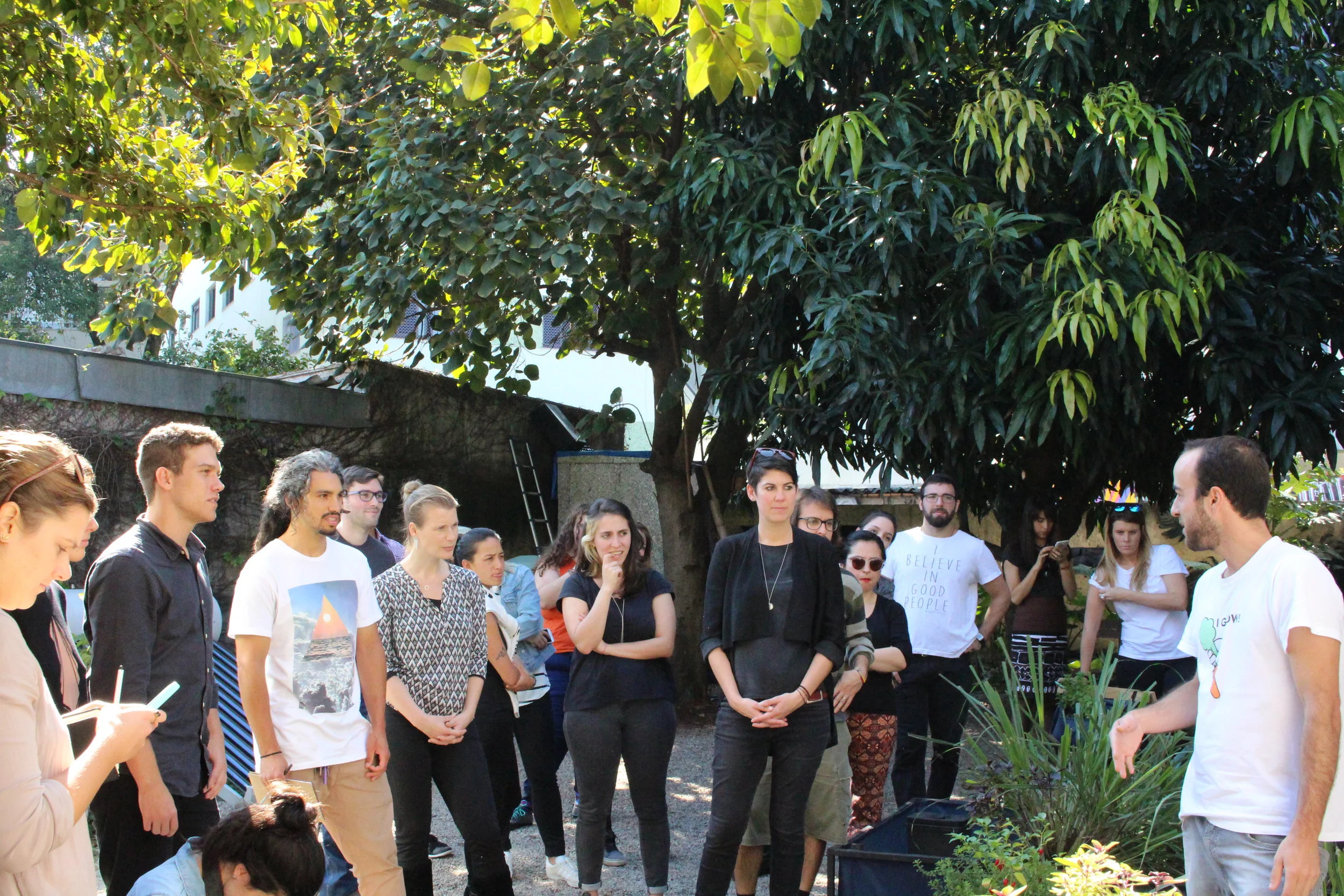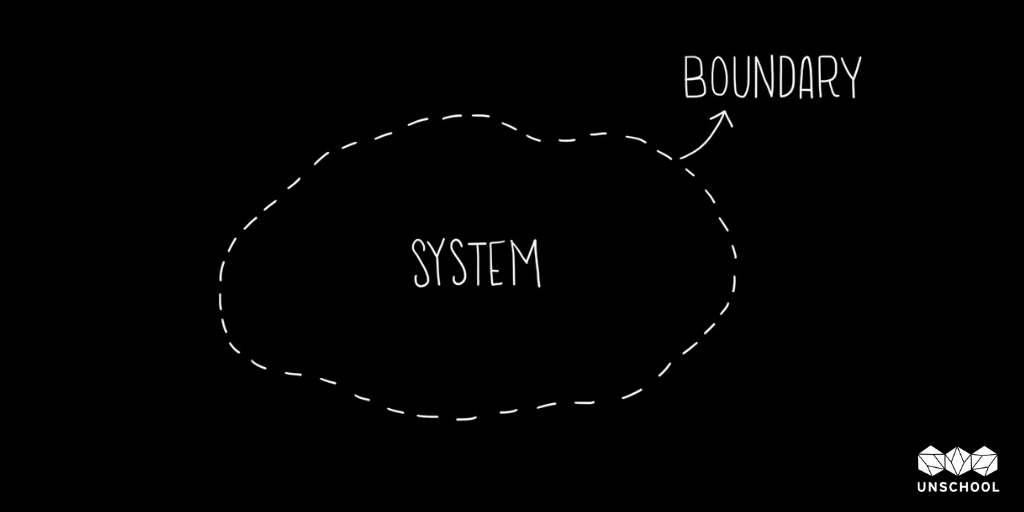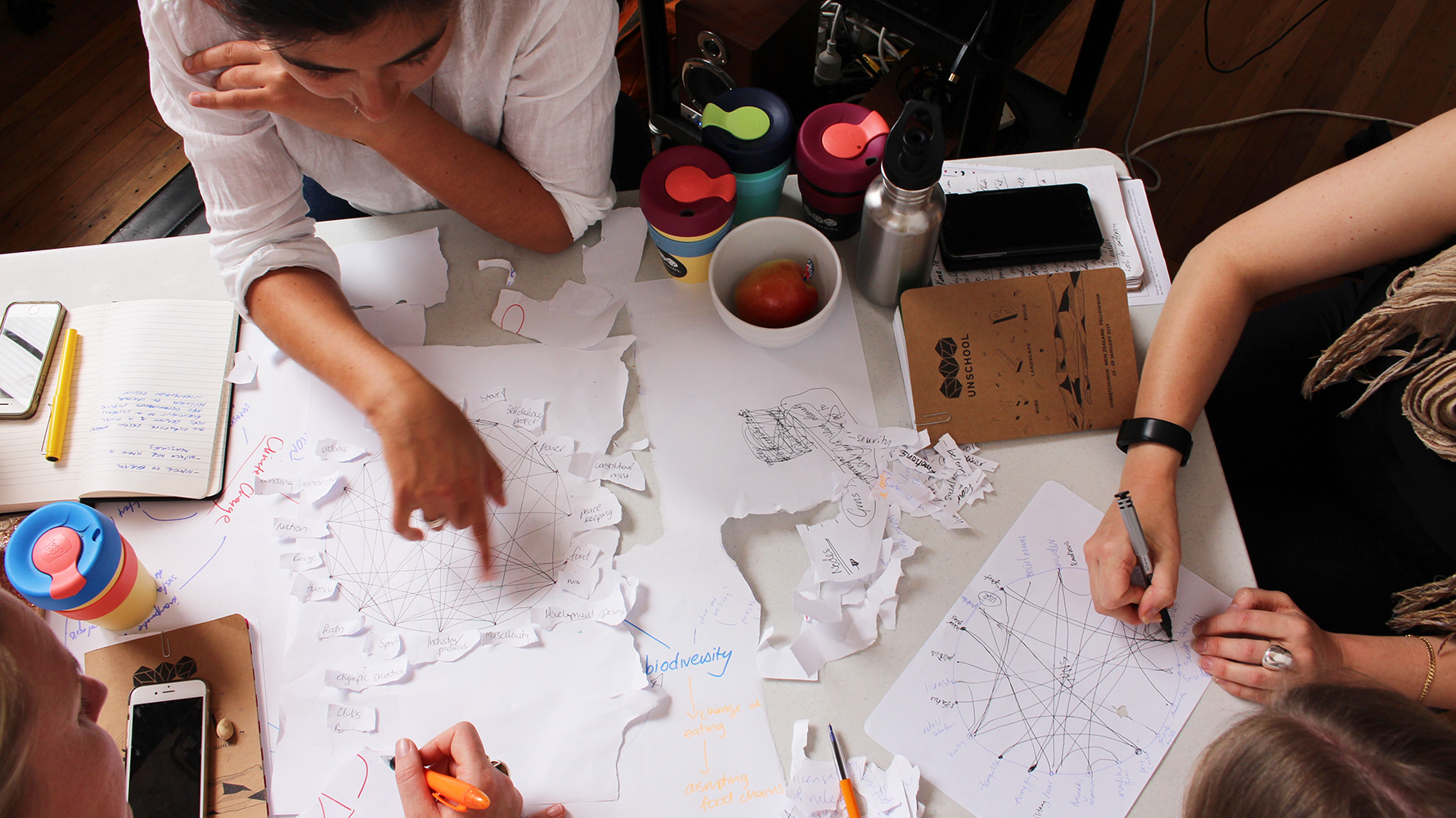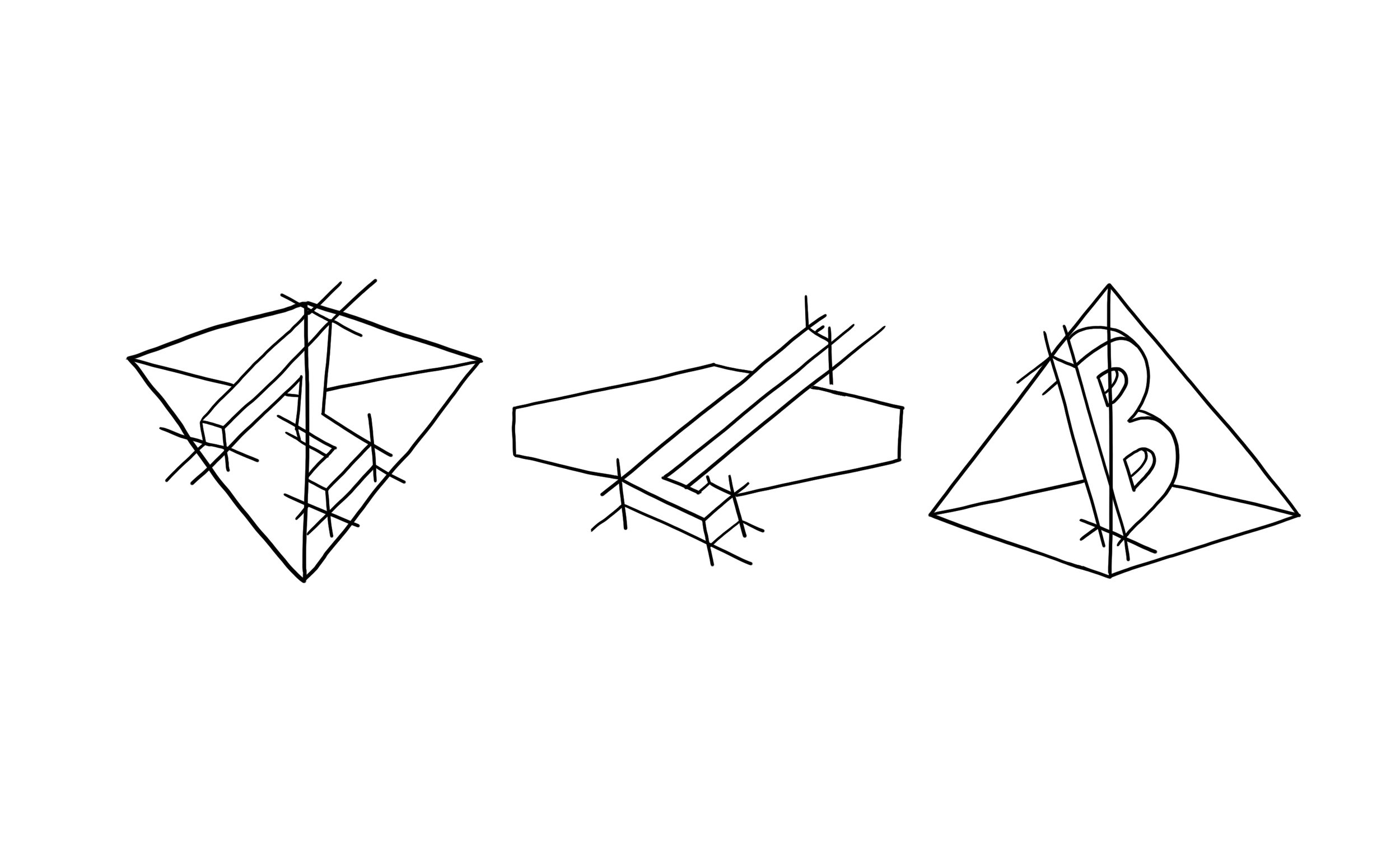The UnSchool of Disruptive Design turns 9 years old this week! What an immense pleasure it’s been to create and share this experimental knowledge lab with tens of thousands of people from around the world over the last 9 years.
New Free Toolkit! 3D Sustainability in Business Framework Starter Kit
Exciting news: we have an amazing new FREE, action-oriented toolkit to share with you to help any organization transform their business practices to be more sustainable and circular.
As part of our Sustainability in Business course series, this new 50-page Starter Kit includes an overview of our 3D framework for assessing, actioning and transforming the operational, product and experiential impacts of any business. Filled with useful content, clear graphics, and several sample worksheets, you can learn the framework and get started on your sustainability journey right away!
The 18 impact arenas explored in the 3D framework for business sustainability
Businesses need to recognize that they play a critical role in the global transformation toward a more sustainable future. The way that they operate the products that they produce and the experiences that they create for their workers and customers all interact with the natural world through supply chains and design choices. Our framework helps dissect these to understand impact areas and then provides the steps for taking action.
In the context of business, sustainability is about ensuring that workplaces, products, business structures and customer experiences are ethical, equitable and economically viable. However, we understand that sustainability is complex and often misunderstood, and it can feel like an overwhelming pursuit for business managers. So, in alignment with our equity mission to continuously release at least 20% of our content and knowledge for free, we are very excited to share our new toolkit that offers up a simple framework for assessment to action.
Behind this toolkit are thousands of hours of workshops, trainings, projects and professional expertise focused on the key impact areas of sustainability in business. You can expect to discover how to understand impacts, assess impacts, and take action right away after utilizing the framework within the starter kit. Then, you can dive deeper if you want by taking our 4-Week Training Sprint that provides more extensive details, actions and activities to advance your knowledge and capacity for activating sustainability in business.
The framework was developed by Dr. Leyla Acaroglu and draws on her years of experience in conducting environmental impact assessments and supporting businesses through their sustainability journey. The framework has three main components, providing a more holistic perspective of where impacts occur and how they can be addressed — all assembled into an easy-to-follow, 3-step framework.
STEP 1: UNDERSTAND IMPACTS
This section of the toolkit provides an overview of the impact areas; operations, products and experiences. There are 18 common domains for consideration from energy, waste and water to direction and engagement of your customers. At each of these business areas there are impacts occurring and opportunities to design more sustainability outcomes. Assessing them illuminates these impact areas and gives you a starting point for recognizing the opportunities you have to make change.
STEP 2: ASSESS IMPACTS
After you've started to understand and identify the impacts your organization has, you can move to a more detailed assessment phase in order to develop your first set of benchmarks to understand current impacts and have a baseline to measure future progress against. There are many ways of assessing impacts in detail, but our 3D framework offers three main tools for assessment: sustainable supply chains, environmental auditing and sustainable design strategies. The starter kit provides you with simple worksheets to get you started. Our online learning system also offers a more advanced toolkit included in the 4-week sprint.
STEP 3: TAKE ACTION
Post-assessment, the final section of the toolkit helps you set goals and clear pathways for change, as well as develop policies and create action plans that activate your reporting and promote continual improvement on your sustainability journey.
Remember, sustainability is a process of transformation, with many untapped opportunities just waiting for you to uncover them. In the final section of the toolkit, we offer up our self-assessment tool that provides you with a place to continually check your progress and encourage you toward your sustainability goals.
Whatever you are at now, just starting out or leading the way, your current position should not be the end of your actions — it’s the beginning. The journey to a better future is always ongoing.
Free E-book: Six Steps to Activating Sustainability in Business
To celebrate the launch of our new Sustainability in Business online learning series, we have created a free E-Book that offers six clear steps to activating sustainability in your business.
Designed to offer an engaging, inspiring and motivating snapshot of why and how to get started with Sustainability in Business, it covers how workplaces can adapt to climate change, transform toward the circular economy, and begin to invest in ESG (Environment, Social, Governance) as core motivators for starting this journey.
Once you have explored the drivers for making change, you will find three areas you can take action in:
OPERATIONS
This includes the energy, water, waste and procurement that the company consumes and produces in order to do business.
PRODUCTS
Whatever is produced by the company as part of their offering into the economy has significant supply chain and natural resource impacts that should be considered in relation to full life product stewardship.
EXPERIENCES / SERVICES
This entails the culture and services that the organization creates and fosters both with customers and with employees.
Download the free E-book today to find out more and get started on your Sustainability in Business transformation!
The Diagnostic Toolkit: Part 3 of Decade of Disruption: Future of the Sustainable Workplace in the Age of Covid-19 and Climate Change
When it comes to sustainable transformation, building knowledge is not enough. You need easy-to-use, impact-driven tools that can help you generate tangible outcomes within your organization.
If you’ve been following along with our journal in the past few weeks, you’ll already know about the trends and forces influencing the transition towards sustainability in the workplace, as well as the many micro transformative forces shaping the way business operate and workplaces evolve.
If you’re new here, you may want to start by downloading the full FREE report, Decade of Disruption: Future of the Sustainable Workplace in the Age of Covid-19 and Climate Change, from which all of these insights have emerged.
So, now that you have wrapped your head around the drivers for change in this decade of disruption, you can use this Diagnostic Toolkit in Part 3 of the report to assess your current sustainability and climate-positive journey.
Once you’ve established your baseline, you can then use this simple tool to help frame the strategy you can employ to embark on or enhance your sustainability journey.
HERE’S HOW THE TOOLKIT WORKS
Respond to 10 quick questions and calculate your score
Use your score to diagnose where you are at currently on your journey
Review your customized action pathway that walks you through what steps to take to generate real sustainable solutions in your workplace
NEXT STEPS
Congratulations! You’re on your way to forging workplace transformation that mitigates the risks of disruptors like Covid-19 and climate change and creates more equitable systems for the triple bottom line of people, profits, and planet.
So, what’s next for you and your organization? If you’re taking some time to digest all of this and want to network with other like-minded professionals — join us in doing so on LinkedIn >
TAKE A COURSE
Maybe you’re ready to take the next step and fully immerse your business in a sustainable transformation? Sign up for a course in our brand new Sustainability in Business series >
GET THE FREE EBOOK
If you’re somewhere in between and want more information, download our new FREE e-book, Six Steps to Activating Sustainability in Business >
The Drivers of Change: Part 2 of Decade of Disruption: Future of the Sustainable Workplace in the Age of Covid-19 and Climate Change
What exactly makes 2020-2030 “the decade of disruption”? How are climate change and Covid-19 impacting workplace transformation and forcing adaptability to a sustainable future? What do businesses need to do in order to stay ahead of the curve and mitigate risk among this time of great and immediate change?
These are some of the questions we set out to answer in our groundbreaking report, Decade of Disruption: Future of the Sustainable Workplace in the Age of Covid-19 and Climate Change, written by Leyla Acaroglu and commissioned by Unily, which you can download in full here — it’s totally free!
Trends are driven by forces for change. While Part 1 of the report explored the megatrends and the disruptive shifts that will define this decade, there are many micro transformative forces shaping the way businesses operate and workplaces evolve.
Here in Part 2, we show the 12 Drivers of Change identified across three categories: Climate Change and Business Strategy; Workplace Culture and Attitudes; and Technology and Infrastructure.
Based on our trend analysis, we explore how they emerged and what some pioneering organizations are already doing to adapt to these influential forces, showing how sustainability, climate change, and the circular economy are affecting the workforce in multi-pronged ways.
If you want to join the ranks of these pioneering organizations and start your workplace sustainability journey, then take one of our Sustainability in Business Programs or week-long intensive happening in December.
Climate Change and Business Strategy
The need to create goods and services that are designed to have a positive effect on the environment, redesign business models that promote sustainability, and set new standards for business operations is critical to the success of organizations in this decade.
All levels of society are now demanding that companies take care of their impacts in some way. These demands are coming from workers, customers and governments. Every industry is being called to act in different ways, but overwhelming businesses need to, and in many cases already are acting on their social and environmental obligations.
“At its essence, sustainability means ensuring prosperity and environmental protection without compromising the ability of future generations to meet their needs. A sustainable world is one where people can escape poverty and enjoy decent work without harming the earth’s essential ecosystems and resources; where people can stay healthy and get the food and water they need; where everyone can access clean energy that doesn’t contribute to climate change” - Former UN Secretary-General Ban-Ki Moon
All aspects of business activities draw on many complex systems that, in turn, result in multi-level pollution back into the atmosphere and environment. From production and transport emissions in producing goods and delivering them to market, to the daily waste generated in office buildings, these are all contributing factors when we look at “doing work” and the effects this has on the climate crises.
Climate Positive Change
Driven by the global societal need to decarbonize the economy, organizations will adopt a diverse array of daily practices through to entire business operational transformation to move from carbon negative to carbon positive companies.
Proactive Leadership
The leaders of the past might have been ok with avoiding or even denying that action on environmental and social issues are important, but the leaders of the present and future are pioneering change within their organizations and reaping the benefits of this action.
Circular Transformations
Business models go from linear to circular by design. The current linear model of ‘take, make and waste’ is transformed into closed-loop circular product service delivery models that design out waste and design closed-loop material flows.
Business Model Redesign
Pivots toward mitigating costs due to changing structural, financial and environmental impacts, combined with maximizing new revenue streams and reduced employee and infrastructure costs offer more adaptive, flexible ways of conducting business in the face of change.
Workplace Culture and Attitudes
Work is a crucial part of our personal and cultural identity, purpose and wellbeing. It is also the lubrication of the economy, but with 77% of greenhouse gas emissions being directly attributed to industrial activities, electricity and transportation in the US, the impact of work on the climate and the wider natural systems we all need to survive is significant and workers are realizing this which in turn is affecting the culture within organizations.
Office buildings globally alone account for 28% of energy-related greenhouse gas emissions from all the heating and cooling, ventilation, lights and equipment needed to go about business and accommodate working humans. So the places and ways we engage in work are shifting to respond to driving forces around physical infrastructure, modes of getting to work, health and safety concerns along with lifestyle desires of the younger workforce.
We are seeing challenges to the old hierarchical models where younger workers are demanding ethical frameworks and holding their own employers accountable for their actions. All of these forces are altering the culture within organizations. Workers look for companies that have purpose and that value their employees; similarly, customers seek out companies that are aligned with their values and see workers being treated correctly. Unless organizations are willing to respond to this shift and embrace sustainability in all its forms as a core part of their operational DNA, then they will lose quality staff and suffer customer cynicism.
Value Aligned
Workers and customers are shifting their values and seeking out organizations that are value-aligned and meet their purpose-filled expectations, greater work-life balance when choosing a job and likeliness to work for a company with a strong sense of purpose and mission.
Worker Activism
There are increased demands from within the workforce for organisations to be relevant, ethical and aligned with the real-world changes that are occurring, be it responding to Covid-19, social equity or climate change. Employees are setting the agenda rather than the organization, as culture is shifting toward values and ethics being an equal player in profit and innovation.
Flexible Worklife
The demand for more work-life balance and the coinciding rise of telecommunication technologies with Covid-19 has accelerated the shift to diverse work-life scenarios customized to meet the employees’ and employers’ needs.
Green Jobs
As the economy changes, so will the types of jobs offered and skills needed by organizations to be competitive. Roles that encompass the skills, knowledge and capabilities to develop and advance a sustainable and resource-efficient world are on the rise, with demand increasing as changes to the workplace and business operations unfold.
Technology and Infrastructure
There is no doubt that technology is impacting all aspects of society in rapid ways, but the workplace is one area where tech-enabled change is being accelerated. Many executives are planning on redesigning their organizations to make them fit and ready for tomorrow, with many anticipating that technological transformation will continue to be a primary business disruptor (Global Trends 2020) .
Whilst tech is enabling rapid feedback of data to facilitate real-time changes, such as reduced energy use and behavioral changes, there are still many gaps to fill and questions to be answered from the impacts of AI and the benefits or losses associated with automation. One thing is for sure though: technology is a great enabler of sustainability. The more integrated we make the systems, the more effective organizations can be at adopting the business and cultural changes needed to embrace sustainability.
Technology is also enabling organizations to literally reconfigure the way they work, being location independent, which in turn, is affecting the size and form of the physical environments that companies design and maintain for their workforce.
Digital Transformation
The workforce is becoming more mobile. Digital technology and innovation - the internet of things, automation, AI - all have the potential to radically increase efficiency and enable new business models across all sectors.
Work Less But Better
As technology and science advances, we rapidly uncover new ways of working that provide more productivity through efficiency, which in turn can empower a more effective work-life balance. By working better, but less, we can reduce the impact of many aspects of workplace activities, from the size of offices to worker transport and energy use.
Living Buildings
Office spaces are adapting in their design, size and infrastructure to incorporate nature and living elements so that work environments are cleaner, more effective and desirable for workers.
Changes to the office environments are being brought about by different forces, from the desire for more work-life balance through to talent retention, but one significant design trend is the health and well-being of the workers inside.
Bringing living things into our built world enables more human-centric spaces that save energy, respect materials and create better working environments that prioritize people and create multifunctional spaces appropriate for multiple uses, such as adapting to social distancing.
Post Disposable
Adopting circular design strategies and ensuring that the full life of products are created to be sustainable, climate positive and socially beneficial can be achieved through the aspiration of being post disposable. To do so, businesses must ensure that, in all aspects of business, materials are valued and systems are designed to capture and reuse the materials that can’t be maintained. Check out our free post-disposable activation toolkit.
While this journal offers a quick summary, the full report goes into way more detail about each of these microforces, as well as offers case studies that show how pioneering organizations are adapting to these drivers of change.
The Sustainability Status: Part 1 of Decade of Disruption: Future of the Sustainable Workplace in the Age of Covid-19 and Climate Change
Last week, we shared the exciting launch of our groundbreaking report, Decade of Disruption: Future of the Sustainable Workplace in the Age of Covid-19 and Climate Change, written by Leyla Acaroglu and commissioned by Unily.
Over the next few weeks, we’ll be sharing highlights from each of the three parts of the report, starting with Part 1, The Sustainability Status. If you’re keen to dive into the full report right now, go ahead and download it in full here — it’s totally free! And, if you are ignited to start your workplace sustainability journey, then take one of our Sustainability in Business Programs or week-long intensive.
This opening section of the report gives you a 360 degree perspective of the trends and forces influencing the transition towards sustainability in the workplace by exploring the opportunities and actions that are currently emerging as the defining forces shaping the transition to carbon positive and sustainable workplaces.
THE DECADE OF DISRUPTION: 2020-2030
The last two decades have seen a rise in “green” office strategies that range from assessing the energy, waste and water consumption through to sustainable procurement and behavioral change initiatives, but now we are seeing the elevation of change towards business model transformation for the circular economy.
This decade was already set up to be one of great change even before the crises of early 2020. Transformation of both the entire economy and social practices was accelerated by the global pandemic that swept around the world, wreaking havoc on markets, changing business operations, altering people's lives and challenging healthcare systems. The Covid-19 crisis is emerging entirely new ways of working, living and doing business. But even before this, the foundations for massive change were already being laid out for businesses. Here we explore some of the great disruptions unfolding this decade.
INDUSTRY 4.0
We are in the midst of a fourth industrial revolution. Industry 4.0 is fueled by digital transformation, Artificial Intelligence, robotics and networked communication systems. Exponential changes in technological development alters the way we manufacture, produce and consume goods and operate within the economy. The interconnection of devices and services so that technology communicates to enable the more efficient and seamless creation of goods, along with the rapid growth in connectivity, is creating entirely new ways of doing things. Offices, factories, cities and homes are getting ‘smarter,’ which when designed well, can lead to significant efficiency and productivity gains.
“This manufacturing revolution will increase productivity, shift economics, foster industrial growth, and modify the profile of the workforce”. - Industry 4.0, BCG
The Circular Economy
In response to the waste and pollution crisis, the Circular Economy calls for a total reconstruction in the way we design, deliver and engage with the goods and services that make up the economy. This involves moving from a linear production process - whereby waste and pollution are built into production systems - to a circular one that allows for new business models, design processes and supply chains that cycles resources through a well-designed closed loop system. Products become services and entire value-chains are redesigned and managed to eliminate losses and increase the value of materials extracted from nature.
“Adopting circular-economy principles could not only benefit Europe environmentally and socially but could also generate a net economic benefit of €1.8 trillion by 2030”. - EU Circular Economy Action Plan, Mckinsey and Company
Climate Change
Humans have long had an obsession with tracking the weather. For much of our history, the ability to predict the weather has helped us build, feed and navigate societal development. The current and predicted changes that will occur this decade if we do not curb global greenhouse gas emissions will make reading the weather have an entirely new meaning as we see more freak weather events, longer, hotter summers, increased frequency of catastrophes and rising sea levels impact coastal regions. The degree of impact will depend on the actions taken now, and with nearly all countries in the world ratifying the 2016 Paris Agreement, there is hope that the worst will be avoided and the best brought out in our global community.
“Ambitious climate action could generate US$26 trillion in economic benefits between now and 2030 and create 65 million jobs by 2030, while avoiding 700,000 premature deaths from air pollution” - New Climate Economy: Commission on the Economy and Climate
2030 Global Goals
The United Nations has marked the end of this decade as the goalpost year for achieving the Sustainable Development Goals (SDGs). The SDGs are a set of 17 global goals that, if achieved, will bring about a sustainable and equitable economy. Many companies are adopting the SDGs as operating guidelines for corporate activity, Despite there still being disconnects between rhetoric and action, there is a strong drive for this decade to be one where global action on sustainable development is made and successes achieved.
“Our analysis shows 72% of companies mentioned the SDGs in their reporting, but only 25% include them in their published business strategy. Furthermore, just 14% include specific SDG targets”. - Welcome to the 2020s: The 'make or break' era of sustainable development, PwC
Global Health Crises
The World Health Organization has long been calling for concern over the threat of global health pandemics, and the Covid-19 crisis has certainly changed the way we live and work. The long term impacts are unknown, as is the potential for an increase in pandemics in the future. The crisis has drawn many parallels to the needed action in combating climate change, as the response to the Covid-19 reminded many that action to abate the negative impacts of climate change also requires collective action. The connection between the destruction of nature and the increased risk of pandemics has been raised by leading biodiversity experts. There’s a likelihood that the coronavirus pandemic will be followed by even more destructive disease outbreaks if the cause behind the continuous destruction of natural capital does not come to a halt.
“Many of the root causes of climate change also increase the risk of pandemics. Deforestation, which occurs mostly for agricultural purposes, is the largest cause of habitat loss worldwide. Loss of habitat forces animals to migrate and potentially contact other animals or people and share germs” -Coronavirus and Climate Change, Harvard Medical School
The Green Recovery
The Covid19 fueled economic crises will be built on a green recovery plan, especially in Europe where the European Union is driving the campaign to build back better. The United Nations Secretary-General, António Guterres, proposed six climate-related actions to shape the recovery post Covid-19 in a call to action for governments to build more resilient, sustainable and inclusive societies. Aiming for carbon neutrality by 2050 and the protection of biodiversity, the green recovery plan outlines:
Monetary recovery packages that deliver new jobs and businesses through a clean and green transition.
When taxpayers’ money is being used to rescue businesses, it should be tied to achieving green jobs and sustainable growth.
The use of fiscal firepower to drive a shift from the current grey to a green economy, empowering societies and people to be more resilient.
Public funds should be used to invest in the future and flow to sustainable sectors and projects that help the environment and the climate by ending fossil fuel subsidies and encouraging polluters to pay for the impacts that they create.
Climate risks and opportunities are to be incorporated into the financial system at large, as well as all aspects of public policy making and infrastructure.
What else is in Part 1?
The rest of Part 1 dives into the megatrends impacting this decade of disruption. Megatrends are massive cultural shifts that unfold in real time, creating identifiable patterns that can be observed and interacted with as they emerge and evolve to affect society at large.
We identified 8 societal level megatrends that are affecting the ways we work and the types of business models that will be successful in the future, all of which are covered in detail in the full report. The future is changed by our actions today, so these trends are a manifestation of the behaviors, desires, aspirations and actions of those operating in the workforce and business world right now.
We also share the results of a survey of 2000 UK-based office workers, from graduate entry level jobs through to Senior Manager level, who were surveyed by Censuswide in August 2020. A range of questions relating to the impact of Covid, their perceptions of sustainability and work life changes were presented, and Part 1 captures fascinating insights from select data responses.
Launching Now! Decade of Disruption: Future of the Sustainable Workplace In the Age of Covid-19 and Climate Change — a Report for Unily, by Disrupt Design
By Leyla Acaroglu
When I was invited by Unily, an intranet development company, to research and write a report on the future of sustainability in the workplace, it was just before the global pandemic hit. Within weeks of starting the research, the world ground to a halt, and the positive and negative impacts of the Covid-19 crisis started to form, making for a fascinating time to be working on a futures report!
Today we launch the resulting report on the forces affecting this disruptive time we are living in: Decade of Disruption: Future of the Sustainable Workplace in the Age of Covid-19 and Climate Change. I explore the macro and micro trends driving change and the impacts of massive disruptions like Covid-19 and climate change on the workplace.
I am so proud of this work. My small team and I worked solidly for 8 months during the pandemic, exploring the megatrends and emerging micro forces that will define the divers for change this decade, looking at what is already underway in bringing about a sustainable future and how this affects the workplace. From today, you can download the report for free here.
I hope that all the creative changemakers out there who have been working tirelessly in the last 10+ years to sound the alarms on global environmental crises like climate change and plastic waste pollution can adapt the perspectives and insights explored through this report, written at such a unique time during the throws of the emerging Covid crisis — a time that has brought to the forefront of the world’s attention the need for urgent systems change in order to bring about a sustainable and regenerative future, now. And business is critical to this transformation. This is why alongside this we have the Sustainability in Business Program series designed to support organizations make the shift to operating in sustainable and circular ways.
The Report
Transformation of the entire economy and social practices, accelerated by the global pandemic that swept around the world, wreaked havoc on markets, rapidly changed business operations, altered people’s lives and challenged healthcare systems. As a result, the Covid-19 crisis is emerging entirely new ways of working, living and doing business. But before this, the foundations for massive disruption were already being laid out for businesses, with several forces of change playing out, this report explores these and how they will continue to drive change this decade.
Through the report, we highlight a number of case studies of leading organizations who are pioneering change, and we explore in detail 12 emerging drivers propelling a pathway towards sustainability within the workplace, starting with the cultural shifts in how and where we do business and expanding out to the operational foundations of the modern workplace. We explore how they emerged and what pioneering organizations are already doing to adapt to these influential forces, showing how Covid-19, sustainability, climate change, and the Circular Economy are affecting the workforce in multi-pronged ways.
The report is presented in three main sections: a highlight of the six relevant megatrends predicted and already emerging as a major influencer this decade; a detailed exposition of 12 micro forces driving these megatrends and how they relate to the workplace and shifts within business operations; and a diagnostic toolkit for business managers to assess where they are on their sustainability journey, with a detailed set of maps of where to go from here to stay ahead of the pack. Stay tuned for more information about each section, as we will be sharing highlights from each of the three parts over the next three weeks, here in our journal!
Through identifying trends unfurling in real-time, this trend report is designed to support business leaders in the process of adapting to this decade of disruption.
Covid-19 and climate change are just two of the most obvious forces impacting our way of life. What we will see unfold over this decade is a great amount of collective reliance in our ability to rapidly transform the way we do everything. The demand for change is great, from workers, to customers and business leaders - the trend towards sustainability being an integral part of the modern workplace is emerging from multiple directions.
This trend report is designed to support business leaders in the process of adapting to this decade of disruption.
Two highlights for me are the identification of the defining drivers which contribute to the megatrends and the micro transformations that will continue to drive change, and the sustainability in business self-assessment tool that helps any organization reflect and assess where they are at and helps lay a pathway for how they can leverage positive change and transform into a sustainable workplace.
As part of the exploration, 2000 UK based office workers, from graduate entry-level jobs through to Senior Manager level, were surveyed by Censuswide in August 2020. A range of questions relating to the impact of Covid, their perceptions of sustainability and work-life changes were presented and selected data responses are shown throughout the report. It was found that there is a rising concern among workers around the impact of the companies that they are working for with 72% of respondents being concerned about environmental ethics, 83% feel that their companies aren’t doing enough and 63% want more green skills to strengthen their workforce value.
Activate + Design the Future of Your Workplace Now
Sustainability is about ensuring that decisions made today don't impede the ability for future generations to have the same, if not better quality of life as we do today, and in the context of work, it's about ensuring that workers, workplaces and business structures are ethical, equitable and economically viable. Every organization will be at a different stage.
As the case studies throughout the report show, there are many ways to engage with sustainability and multiple opportunities to lead through these complex times. The most important thing is getting started, and this report will support you in gaining the insights and advantages of establishing a journey towards a sustainable workplace.
The Growing Demand for More Sustainability in Business
By Leyla Acaroglu
Most people are aware that individual actions have impacts on the planet — both potentially positive or negative — but what is less considered is the impacts that our actions in business have. Many of the global environmental and social issues we face are directly attributed to the economy, and all work, in all its forms, impacts the economy in some way. From producing goods and services through to purchasing products to conduct operations, these are all aspects of the complex global supply and demand cycles that drive up ecological damage or create new markets for more sustainable outcomes.
Sustainability in business is about integrating an approach to operating a business that meets the needs of your customers and workers without negatively impacting the planet at large into the DNA of your organization. This involves the harmonizing of these three key factors:
Considering the social, environmental and economic impacts so that the actions, the decisions and the outcomes of your operations do no harm;
Working toward offering back more than you take and contributing not just goods and services to a linear economy, but creating value that is wider than pure economic gains.
Understanding where in your operations and experiences (for customers and workers) you need to instigate technical and cultural change so that you continually improve working toward a carbon positive and sustainable business.
In order to achieve this transformation, all agents in the business ecosystem need to be aligned to the opportunity that sustainability offers. Leadership is crucial in this. Demands from workers are driving organizations to take action, but the most effective change happens when leaders lead the change with passion, knowledge and motivation. It's very hard to not align people to a common good when they are exposed to the facts in a way that connects to them and their lives. This is what we are seeing with climate change — people are demanding that their companies take action to show leadership.
We live in a time when the availability of information makes it hard to avoid the realities of our collective environmental and social ills; however, there are many forces of misinformation and anti-science that support a lack of action, or the intentional blocking of progressive change.
But when you get to the core of it, all humans need nature — we all want our kids to have a positive future. And when you look at it from this perspective, you would be hard-pressed to find someone who would eventually agree that the negative impacts of a rapidly changing climate, ocean plastic waste or air pollution are positive things that we should encourage. All companies impact these areas. They take in resources and pump out pollution in the process; unless a business has assessed and thus understand these impact areas, it will continue to have a negative impact by default.
Business Impact Areas
There are three main activity areas where organizations have impacts and thus present the main opportunity to make change within:
Operations — through the energy, water, waste and procurement that the company consumes and produces in order to do business.
Products — those that are produced by the company as part of their offering into the economy. These have significant supply chain and natural resources impacts and should be considered in relation to full life product stewardship.
Experiential — the services and culture that the organization creates and fosters both with customers and with employees.
Forces for Change
It’s not just common sense to introduce sustainability into any business; it’s also an increasing demand from key stakeholders, such asthe workforce. They see the issues at play and want to work for companies that align with their values.
The Purpose-Driven Workforce
The changing workforce is demanding meaning and purpose-filled work as we move from Baby Boomers being the biggest generation to Millennials. Studies done by Deloitte and McKinsey show that Gen Z and Millennials are deeply concerned about environmental issues such as climate change, and want to not only work for a company that speaks to these values but also to buy from them as well. Recent studies from Mercer 2018, WBCSD report “Complex disruptions to the Future of Work”, Harvard Business Review, and The Deloitte Global Millennial Survey 2019 all demonstrate these trends in play.
“Employers are responding to workers’—especially Millennials’—demands for better work/life balance with increased telecommuting, flextime and other accommodations. Since 1996, the percentage of organizations offering telecommuting has increased threefold (from 20 to 60 percent), and the percentage offering telecommuting on an ad hoc basis has increased from 45 percent in 2012 to 56 percent in 2016.“ (SHRM 2016)
The Stakeholder Demand
For many years, sustainability was driven by customers, regulators and sometimes internal leaders. These stakeholders helped early adopters and pioneering organizations be first out of the gate in ensuring that their business operations and profit-building activities don’t negatively affect the planet. So of the most successful examples of this in large companies are InterFace Floor, Patagonia, and Ikea.
But now the drivers for change are coming from less-likely stakeholders, with shareholder activists, corporate governance and CEOs themselves starting to demand higher sustainability performance from their teams, seeing not only the value in a responsible company but also the realistic necessity to take action to curb climate change and ensure that natural resources are protected for future generations.
In early 2020, many things coalesced to show this significant increase in the normalization of sustainability in business. One was Microsoft announcing that they will buy back all the carbon they have ever produced. Another was the CEO of the world’s biggest investment firm, BlackRock, announcing that they would no longer invest in companies that don’t take climate action, and then in mid-2020 came good on this by divesting from several fossil fuel companies.
Even more so, the COVID-19 course has opened up an unlikely opportunity to build back an economy connected to reliance and sustainability, with the European Union, the UK, Canada and many other leading nations committing to creating a green economic recovery plan. This has opened up massive opportunities for organizations to assess and disrupt their own old way of doing business and bring in new leaner, greener and healthier work practices.
Helping you get Sustainability into Business Decision Making
Sustainability can be complex and overwhelming at times. Understanding the difference between the terminology, methods, assessment tools and then deciding what works best for your industry and scenario are all considerations that managers and senior leaders face.
What is the circular economy and how do we participate in it? What are our operational impacts and how do we assess them? What about being carbon neutral — is that something we need to do now? These are all the kinds of questions that organizations are asking themselves, and google searching the answers isn’t cutting it.
That’s why we have an entire suite of Business Sustainability programs to support the active assessment and transition for any size company, whether you are just beginning to implement sustainability in business or you are working on becoming a carbon-positive organization.
A sample of some of the Business Sustainability online courses available at online.unschools.co
Led by Dr. Leyla Acaroglu, UNEP Champion of the Earth, Designer and Sociologist, her expertise in sustainability and tools for the circular economy allows for a rapid uptake and understanding of the core considerations that anyone working to affect change within an organization needs to know.
The core topics in our Business Sustainability knowledge category include:
Sustainability in context of what it is, is not and how to do it well. Included in this is an overview of all the aspects within, from climate change to recycling and the circular economy, as well as how this affects business and workplaces and the practical actions you can take to eliminate impacts and build a more sustainable business.
A clear overview of all the terms and concepts that apply to sustainability, carbon positive workplaces and the circular economy.
Life cycle thinking and understanding the supply chain, along with design and manufacturing of products you make and also consume. This supports base-case assessment, design changes, and also procurement choices.
Material impacts and decisions around business activities, such as waste and energy services. Discover how to use environmental impact assessment in ways that support better decision making and reduce costs.
The theories and approaches to making positive change within your organization.
Understanding the areas of impact that any business must consider and practical approaches to reducing these.
Business Ethics and leadership tools for engaging your people in effective, respectful and motivating ways, with action checklists and support in writing environmental policies and reporting.
How to create products and services for the circular economy.
JOIN AN INCREDIBLE LIVE ONLINE WORKSHOP IN ACTIVATING SUSTAINABILITY IN YOUR BUSINESS
Sustainability can be complex and overwhelming at times. Understanding the difference between the terminology, methods, assessment tools and then deciding what works best for your industry and scenario are all considerations that managers and senior leaders face.
This program lays out the core thinking and decision-making tools required to advance sustainability and the circular economy within the business environment, led by Dr. Leyla Acaroglu, UNEP Champion of the Earth, Designer and Sociologist.
Her expertise in sustainability and tools for the circular economy allows for a rapid uptake and understanding of the core considerations that anyone working to effect change within an organization needs to know.
Business Sustainability Activation October Training Program
MEET OUR NEW SUSTAINABILITY IN BUSINESS TRAINING PROGRAMS!
For many years we have been working with organizations of all sizes to help them identify and integrate sustainability into their processes, practices and organizational DNA, and now we are excited to share a diverse range of programs dedicated to helping advance and activate sustainability into business processes and structure!
Our new courses range from an introductory level course through to 101, 102 and 103 series of leveling up. They are designed to support organizational change and offer any sized business the tools needed to identify, design and reconfigure into a circular, sustainable and climate positive business. The series will be released over the next few months and to kick off, we have a 1-month live intensive with Dr. Leyla Acaroglu happening in October! This program is the perfect starting point for anyone who wishes to help transform their business at an operational level into one that has conscious and considered impacts. Find out more about the program, who its best suited for and our full series here in this week’s journal.
What IS the live program is all about?
This program is designed for professionals from a variety of backgrounds and industries who want to gain the full-spectrum understanding of sustainability in business operations.
This is an immersive knowledge-building program for managers, HR specialists and business development teams wanting to advance through sustainability.
This week-long immersive is divided up into 3 main live knowledge sessions and activations during the week, offering up a detailed introduction to sustainability in the workplace program.
We designed this workshop for anyone who is interested in understanding how to take action within a business context to introduce sustainable and carbon-positive actions.
The topics covered include:
Sustainability — what it is, is not and how to do it well. Included in this is an overview of all the aspects, from climate change to recycling and the circular economy to gain a clear overview of all the terms and concepts that apply to sustainability, carbon-positive workplaces and the circular economy
An overview of business sustainability concepts, current must-haves for engaging with this transformation and case studies of organizations taking action
Which forces are influencing sustainability in the workplace and the business risks associated with inaction
How sustainability affects business and workplaces, and the practical actions you can take to eliminate impacts and build a more sustainable business
The trend toward workers demanding sustainability from organizations, along with theories and approaches to making positive change within your organization
Life cycle thinking and understanding the supply chain; design and manufacturing of products you make and also consume, which supports base-case assessment, design changes, and also procurement choices
Material impacts and decisions around business activities, such as waste and energy services, as you discover how to use environmental impact assessment in ways that support better decision-making and reduce costs
How to write an environmental plan/policy, do a self-assessment, take action and create products and services for the circular economy
Business ethics and leadership tools for engaging your people in effective, respectful and motivating ways, with action checklists and support in writing environmental policies and reporting
If you are an executive, manager, decision-maker, and leader who is working within an organization and are keen to start your sustainability journey, this course will help you get your head around all the policies, procedures, decisions and pitfalls of taking action for a carbon-positive future.
“The Disruptive Design workshop far exceeded my expectations. The content has given me a practical way to delve into complex problems, exploring thinking far beyond my normal lines of inquiry, and to surface new areas for intervention and innovative ways of designing those interventions. Everyone who is tackling systems should learn this.”
Why SHOULD YOU take this workshop?
This is a knowledge-building skill development program for people wanting to integrate sustainability decision making into their workplace.
The content is designed to support the rapid uptake of core concepts, tools and approaches to integrating sustainability into decision making, facilitating the transition toward operating more sustainably, and providing the tools that enable this to happen within your organization.
This program is specifically focused on understanding the fundamentals of what sustainability is and how it applies to your business and the workplace, along with providing very practical action kits, details on how to write environmental policies and a regulation checker.
The goal is to provide the framework for you to get started within your organization, no matter what industry you are in or how far along your sustainability journey you already are. Its practical, actionable and easy to digest in a short period of time.
By the time you have taken this program, we will have launched our brand new Sustainability in Business Series, along with our 12 Steps to Sustainability Challenge, all of which which offer practical roadmaps to organizational change.
Sustainability can be complex and overwhelming at times; understanding the difference between the terminology, methods and assessment tools and then deciding what works best for your industry and scenario are all considerations that managers and senior leaders face.
The October workshop lays out the core concepts, tools and actions you can take to ensure you are activating a sustainable and ethical approach to doing business.
Led by Dr. Leyla Acaroglu, UNEP Champion of the Earth, Designer, Sociologist and UnSchool founder, her expertise in sustainability and tools for the circular economy allows for a rapid uptake and understanding of the core considerations that anyone working to affect change within an organization needs to know.
“Over 200 of the world’s largest firms estimated that climate change would cost them a combined total of nearly US$1 trillion in the case of nonaction. At the same time, there is broad recognition among these same firms that there are significant economic opportunities, provided the right strategies are put in place.”
A sneak peek at the rest of the series
The Business in Sustainability Program series encompasses many aspects of integrating and transforming organizations to be sustainable and circular. From general operational impacts through to system-wide transformation, each program has been curated to support a different level organizational shift.
Our introduction course helps you assess where you are and covers the basics to get yourself or team on the same page. We offer a self-assessment tool to see where you are at and identify the next steps, along with sharing inspirational case studies from a variety of industries and the growing trends around the world.
The 101 course focuses on the operational level, covering topics such as audits, inputs and outputs; 102 covers the financial aspects of sustainability in business to make the case for change and upskill in ways to do so; 103 covers the broader systems thinking for carbon and future positive workspaces, looking at the bigger pictures and establishing leadership paths forward. We will also be offering an executive-level course in the future to leverage and build leadership in the sustainability for a business context, as well as an engaging and motivational 12 Step Organizational Challenge.
INTRODUCTION PROGRAM
Basic Training
Kick off your transformation by uncovering the core concepts and approaches to sustainability in business, and be inspired by diverse industry case studies as well as map your action plan:
Part 1: Sustainability and Circular Economy Transformation in Business
Part 2: Case Studies of Sustainability Initiatives in Business
Part 3: Leadership and Activating Change
Sustainability in Business 101
Operational Training
The 101 program covers all the core aspects of operational impacts, exploring the energy, waste water and procurement aspects of general operations, as well as providing actions for upskilling in life cycle thinking and green supply chain development.
Part 1: Sustainability and Business Operational Impacts
Part 2: Assessing Operational Areas of Impact
Part 3: Supply Chains, Carbon Emissions and Life Cycle Thinking
Sustainability in Business 102
Financial Training
The 102 program dives deeper into the economic impacts of sustainability in business, such as the financial risks, opportunities, and strategies for taking on the challenges and leadership roles in this global movement. The world is changing - fast - and positioning yourself and your organization for employability and resilience will be critical for successful and sustainable growth in the years to come.
Part 1: Materials and Waste Streams
Part 2: Developing Policies and Procedures
Part 3: Corporate Governance and Financial Reporting
Sustainability in Business 103
Systems Training
The 103 program looks at the bigger picture and supports decision-making for systems level change within the workplace context. Level up with carbon and future positive initiatives, build leadership skills for internal and external momentum, understand sustainable design strategies and create products and services that fit into the circular economy.
Part 1: Transitioning to The Circular Economy
Part 2: Systems Thinking in Business Decision Making
Part 3: Business Ethics, Integrity and Theory of Change
Executive Training
The Executive Training Program is an advanced sustainability leadership track that includes deep knowledge on systems wide transformation, adaptation to circular principles and operational impact assessment. Set an example for your employees and your industry in a way that both builds your business, while also establishes the norms for a more positive, regenerative and resilient industry. Get ahead of the curve and be a leader in your space.
Team Challenges
Any individual can take on the challenge for themselves or implicate their colleagues into the challenge for a fun and interactive way to increase their impact and influence. This is a great initiative for HR managers and executives to invite their employees to take part in, incentivizing participation and encouraging everyone to come along for the ride as your organization scales up its efforts toward increasing and meeting sustainability goals.
Looking for custom content?
All our standard courses are fully customizable to your organizational needs. We offer bulk subscription discounts and can develop specific and customized content for your industry, as well as provide motivational live sessions with our lead educator Leyla Acaroglu, or executive coaching and advice services to ensure your company-wide success.
“This masterclass has definitely stretched my brain. My brain does hurt but it was absolutely worth it. My work will be less stressful now that I can sift through my messy brain. Thank you for saying it’s okay to procrastinate and that it helps, and thank you for reminding me that we need to be more compassionate because we need more people to adhere to sustainability in order to make the world better. We just can’t do it alone.”
Week 65: International Youth Day | Tools for Supporting Young Change Makers
12th August is the day the UN celebrates International Youth Day this year, and what a year to shine a spotlight on all the incredible action young people around the world are taking. This year’s theme is Youth Engagement for Global Action, and over the last year, we have seen so many amazing activations from young people, like the Fridays for Future school strikes led by the incredibly inspiring Greta Thurnberg, as well as the landmark court case Juliana v. United States, which asserted that the impacts of climate change were violating Americans’ federal rights.
So in this week’s journal, we celebrate the highlights of the last 12 months of youth action, and in celebration, we developed a youth activation kit that is on sale for half price for the rest of August!
Friday School Strikes
#FridaysForFuture started in August 2018, by then 15-year-old Greta Thunberg, when she and other young activists sat every school day for three weeks in front of the Swedish parliament protesting the lack of action on the global climate crisis. The now famous youth leader Greta posted what and why she was doing this on social media, and it soon become a viral phenomenon that has grown into a global youth movement.
By mid-2019, young people were striking on Fridays in more than 2,000 towns and cities in over 100 different countries with millions of students joining in. This year, September 25th will be a national day of action whereby hundreds of thousands of young people around the world will strike from school, demanding leaders take action on climate change (with Covid-19 precautions in place).
YOUNG PEOPLE SUE the US Government OVER CLIMATE CHANGE
Since 2015, a group of young Americans fought an inspiring battle against the US government, claiming that their constitutional rights were being neglected if the government did not take action on climate change. Sadly, in January this year, a U.S. federal appeals court threw the case out, causing a major setback to efforts to spur the U.S. government to address the issue.
The pioneering law suit was brought against the government by a group of 12-18 year olds, including Aji Piper, Levi Draheim, Journey Zephier, Jayden Foytlin, Miko Vergun, and Nathan Baring among a total of 21 plaintiffs, all whom were passionate about the planet and not willing to sit by and watch their government continue to ignore the science on climate change.
Judge Andrew D. Hurwitz, who presided over the case, said the following when providing his opinion on the ruling, saying that the young people “have made a compelling case that action is needed… Reluctantly, we conclude that such relief is beyond our constitutional power. Rather, the plaintiffs’ impressive case for redress must be presented to the political branches of government.”
All is not lost as this action has clearly inspired others. After the devastating fires that ravaged Australia in early 2020, a 23-year-old Australian student brought a class-action case against government over climate change. More and more young people are demanding action from their governments and taking action themselves to secure their future against catastrophic environmental issues.
Youth-led Action Networks
There are countless youth-led climate and environmental action networks, educational organisations, not-for-profits and campaigns set up all over the world. Here is a list of just some of the initiatives set up and run by young people:
Youth Leaders
Here are some of the youth leaders and their twitter handles all using their voices to forge a pathway towards a sustainable future for all of us:
Nadia Nazar, 17 from USA @nadiabaltimore
Holly Gillibrand, 13 from Scotland @HollyWildChild
Vic Barrett from the USA @vict_barrett
Isra Hirsi, 16 from the USA @israhirsi
Xiuhtezcatl Martinez, 19 from the USA @xiuhtezcatl
Jerome Foster II, 16 from the USA @jeromefosterii
Luisa Neubauer, 23 from Germany @Luisamneubauer
John Paul Jose, 22 from India @johnpauljos
David Wicker, 14 from Italy @davidwicker_hf
Lilly Platt, 9 from the Netherlands @lillyspickup
Leah Namugerwa, 14 from Uganda @NamugerwaLeah
Saoi O’Connor, 16 from Ireland @saoi4climate
Timoci Naulusala, 12 from Fiji #timoci
Shalvi Shakshi, 10, from Fiji
Nakabuye Hilda from Uganda @NakabuyeHildaF
India Logan-Riley from Aotearoa / New Zealand @IndiMiro
Brianna Fruean, 20 from Samoa @Brianna_Fruean
Ridhima Pandey, 12 from India @ridhimapandey7
Marinel Ubaldo from The Philippines @YnelUbaldo
Winnie Asiti from Kenya @Asiti
Ayakha Melithafa, 17 from South Africa @ayakhamelithafa
Xiye Bastida, 17 from Mexico @xiyebastida
Autumn Peltier. 16 from Wiikwemkoong First Nation @StephaniePelti3
Amariyanna Copeny, 13 from the USA @LittleMissFlint
Take Action: our 4-Week Youth Activation Challenge
We have designed a 4-week learning challenge for any young person who wants to take action. With loads of UnSchool content from systems thinking to agency development and creativity, we have packed this program full of exciting and motivating content perfect to get any young mind activated and engaged.
To celebrate International Youth Day, the Program is half price for the rest of this month. Just use the code IYD2020 when signing up
Quick Guide to Circular Economy Business Strategies
By Leyla Acaroglu, Originally published on Medium
The Circular Economy is all about the transformation of the way we do business, create goods and services, organize society and ultimately respect and cherish the world around us. Moving from a linear to a circular economy requires a reconfiguration of nearly all business structures, which is where circular business strategies come into play.
In my quick guide series, I am providing an overview of the different decision making support tools that enable the transformation to a circular and sustainable society. We are all consumers in the current linear economy, but as we transition to one that massively reduces waste and instead promotes a variety of reuse approaches, we will each become shareholders in the delivery and cycling of goods and services throughout the economy. This requires a redesign of nearly everything, and the sustainable design decisions I outlined already cross over with these sustainable business strategies as they interlock to provide a pathway form linear to circular. Like any strategy, there is no one size fits all solution and there are new ideas and approaches being designed and tested in more detail as we see the advancement of this transformation.
As individuals, as governments and as organizations, we already encourage or discourage industries, services and products based on what we invest in and thus support, in our time, energy and money. If you are someone who works for a company and makes decisions, then you definitely need to understand how the economy is currently transforming and what the new types of business models are evolving to service the in-demand need for a resource-efficient, equitable, sustainable and circular world.
As we enter into this new green recovery stage, there are many businesses in need of reconfiguration, pivots and performance changes, where the standard business models, policies, products, and services just don't fit any longer. In order to meet the growing demand for sustainable and circular products and the political shifts towards equitable industries, companies need to come to terms with these new approaches to making money whilst also making good.
“Circular business models modify the pattern of product and material flows through the economy.” — OECD Business Model for Circular Economy Report
Within a circular economy, goods cycle through two main types of metabolism flows. One is the technical system, which includes all the human-made, technically-altered goods, and these must be designed to be recaptured, reused, repaired, remanufactured and where appropriate recycled, in order to ensure material values are maximized and technical products don't escape into the natural environment — which leads us to the other main metabolism, the biological one. This encompasses all the goods and materials that are biologically based and can easily and benignly be metabolized back into nature. All food products, for example, are biological, while all food packaging that has any technical additions like plastic is in the technical stream.
Many of the ecological impacts, the externalities that we see in the economy, have come about as a result of supply chain relationships — not just the end-of- life destination where things end up. Yet, much of our investment and activation for change thus far has been around waste management, rather than on designing out waste from the system right from the start. In part, the circular economy is trying to address this by providing pathways for full systems redesign, rather than just end-of-life tweaks.
The global economy is designed around the consumption of goods and services, so much so that the measurement tool we use to determine the success of nations, the Gross Domestic Product (GDP), only measures the things produced and sold in a country. It ignores the losses from the systems that it takes from, such as nature, ignores any activities that have no economic aspect to them and ultimately creates a very narrow view of value and wealth. GDP is a massive system failure as it externalizes all ecological impacts. This way of measuring the economy is only 70 years old, and it has helped to create many of the environmental issues that plague us today.
GDP is one of the driving forces that created the global linear economy, whereby every day millions of tons of raw materials are extracted from nature (through mining, harvesting, cropping, etc.); these are mechanically processed into usable goods in factories, shipped around the world, and then purchased, used up, and thrown out. When things are discarded, they often end up in landfills, incinerators or dumps, or worse they escape back into nature in harmful ways because they were only ever designed to maximize the benefits to the producers and not to consider the full life cycle impacts that they may have. Waste in all its forms is a byproduct of this linear system, whereas in nature, there is no such thing as waste; our species has created pollution of all sorts. This has created a huge strain on the waste and recycling systems, of which are currently broken, resulting in many ecological, equity and health implications, and created the demand for transforming the way we do business, meet human needs and structure the entire economy.
As we progress to the normalization and integration of the circular approaches, pioneering leadership is required from governments and CEOs, as well as the creative thinkers who can help shift the status quo through designing new things that make the old polluting, degrading, inequitable systems obsolete. We are starting to see this, with many of the world's biggest companies committing to adopting circularity, carbon reduction, and sustainable design strategies.
We can speed up the needed change by incentivizing producers to approach product and business design differently — to use sustainable design approaches and life cycle assessment to help green supply chains and find unique ways of shifting the status quo on hyper-consumerism through the implementation of closed-loop product delivery models.
“Circular business models are special in the sense that they look for value creation in places usually of little interest to companies that operate in the traditional linear production paradigm”. — Guldmann, Best Practice Examples of Circular Business Models
The future is circular, not just in the wider economy, but also in our daily lives. As we become more aware of the impact of our actions, we are more incentivized and agentized to make informed and effective decisions. We can no longer avoid the reality that our planet is in need of better care. The linear economy has helped us advance to this incredible point in time, but the advancement has come at major costs to the ecological systems that sustain life on Earth, which in turn affects our health and quality of life as we battle climate change, air pollution, global pandemics and loss of biodiversity. These issues are all interconnected, and until we change the way we do things, we will continue to be the victims of our own poor decisions.
The circular economy is seeking to remedy this through shifts in the way we arrange society, the way we produce goods and services, and the way we all consume, in order to ultimately design the kind of future we want to live in. One that is equitable, sustainable and regenerative by design.
Before we dive into the business models that are part of this transformation, let’s quickly cover some of the key concepts that are central to the circular shift.
Circular Economy Core Concepts
It's important to know that the movement for the transformation to a closed-loop circular economy has been well underway for several decades. Work at multiple levels of research, industry and government has been ongoing to advance the idea of product stewardship, cleaner production and extended producer responsibility. Here are the main overarching concepts that fit within the circular economy:
Product Stewardship: The parent company of the design, production and sales takes full responsibility for reducing the environmental impact of the product they create throughout the entire life cycle of the product, ensuring that there are appropriate end-of-life options and that these are managed by the parent company.
Extended Producer Responsibility: A policy approach whereby all of the full life-cycle environmental costs associated with a product are added to the final sale price, and this extra revenue is used to manage the product stewardship of the product.
Eco Design: Approaches to designing products so that they last longer and have a limited impact on the environment across their full life cycle. This is also called sustainable design, and I have a quick guide to this here too.
Cleaner Producer: A preventative measure by companies to reduce the waste and pollution associated with the production of goods.
Industrial Ecology: Ways of remodelling industrial systems to perform more like ecological ones and maximize value exchange.
Industrial Symbiosis: Part of industrial ecology, a network of diverse organizations collaborate to ensure that resources are used efficiently and value is cycled between them.
Waste Equals Food: An approach where all ‘waste’ becomes a nutrient to something else in the system.
Non-Fossil Energy: Energy derived from renewable resources.
True-Cost Accounting: A type of accounting that takes into consideration the full externalities and costs associated with delving a service, doing business, or creating a product.
Cradle to cradle: A concept of ensuring that the full life of a product is managed in a sustainable way that was made popular in a book of the same name and has a certification system for products.
Biomimicry: An approach to creating products and services that mimic the way nature works by studying and replicating the solutions found in the natural world.
Regenerative Design: A whole systems approach to creating solutions that offer back more than is taken in their creation by exploring the way natural systems solve problems and creating things that are interconnected with natural systems.
Post Disposable: A movement to make waste obsolete by designing solutions that move beyond waste as a socially acceptable concept.
Life Cycle Thinking: A framework that takes into consideration the whole of life environmental impacts of a product or service by looking at the impacts that actions in the economy have on natural systems by looking from the cradle to grave. I have a guide to this here.
Disruptive Design: Disruptive Design is a way for creatives and non-creatives alike to develop the mental tools to activate positive change by mining through problems, employing a divergent array of research approaches, moving through systems thinking, and then ideating opportunities for systems interventions that amplify positive impact.
Systems Thinking: Systems thinking is a holistic approach to understanding the way parts fit together in dynamic relationships to make up a whole system. It’s the opposite of reductive or linear thinking and involves a series of practical approaches and mental models that enable a more complex view of the world, focusing on relationships and synthesis.
Closing the loop: This Is a concept promoted by some businesses as a solution to waste generation and in support of the circular economy. By closing the loop on the end-of-life impacts of a product from the design stage, the business can be redesigned to support end- to-end integrated systems.
Technical nutrients: Materials or stocks that are manipulated by humans and cannot be easily re-integrated into nature (for example, plastics).
Biological nutrients: Materials or stocks that can be easily absorbed or digested by natural systems in a benign way (unbleached paper or food).
Metabolism rate: The ability for things to be reabsorbed or integrated into a system — food waste, for example, can be easily metabolized in a compost bin or biodigester, whereas it does not get effectively metabolized in a landfill.
Zero waste: This is a strategy and movement to go beyond waste reduction and remove all disposable products from a place, company or lifestyle by embracing a set of strategies that eliminate waste completely. The goal is to avoid sending any waste to a landfill or incinerator.
(There are many more! I have a class that covers all of this in way more detail coming out soon, and we also have a gamified toolkit that asks these questions and helps you get to a sustainable outcome — see here)
Circular Economy Business Models
The types of business model transformations that are underway and will become more prevalent in the near future include different approaches to closing the loop so that end-to-end material flows are managed by the producers. The burden of waste is not transferred to the end-user, but instead, the company has stewardship over their products for its full life cycle and designs products to be recaptured to ensure that the values of the materials and embodied impacts are maximized.
Every industry and product category will need a different combination of business and design approaches, as some materials are easily re-metabolized and some aren't, some product categories are much simpler than others, etc. The fundamental shift here is how we design goods to flow through the economy and the responsibility that producers take of their goods, enabling customers to return, reuse, or repair to ensure that value is continually increased.
REPAIR
Designing products to have extended life spans by providing repair services and maximizing likelihood of repair during use and end of life phases.
REMANUFACTURE
Creating within a closed-loop system where products are intentionally intended to be taken back, reconditioned or fed back into the production cycle to create new high value products.
RESELL
The resale or buyback of products are encouraged, supporting the continuation of the functionality and increasing the usable life span.
SHARING PLATFORMS
The creation of service provisions within a product context to maximize the reuse and shareability of the goods.
WASTE AS A RESOURCE
Products are designed to intentionally use others’ byproducts or to ensure that their own byproducts are absorbed into a new system.
PRODUCT AS SERVICE MODEL
Products are reimagined into service delivery models, and long-term relationships are built with the customers. Products are always owned by the producer and leased to the customer thus they can be made of higher value and managed across their entire life.
CIRCULAR SUPPLIES
Products are part of the supply model, and consumers collaborate to share resources and ensure that circular products are available on the market.
RESOURCE RECOVERY
Mining landfills or extracting materials back from the economy to ensure that they are circulated back into the system. This could be a third party provided system.
PRODUCT LIFE EXTENSION
Challenging the traditional model of lots of customers buying individual units by offering higher value longer-term products and ensuring they are utilized. Perhaps with a pay per use model of another way of ensuring that materials stay in the economy longer.
But wait, there are more strategies!
There are actually many more considerations and opportunities that apply to different stages, product categories and the level of change you are at. I have created a free toolkit for circular redesign to walk you through a quick creative process.
If you want to learn more about this, we have an introductory class on the circular economy, many resources and several handbooks on Circular Systems Design that dive into this in more detail. I also host a group on LinkedIn for people working in systems change. Additionally, we are launching an extensive set of programs and services for businesses interested in advancing their skills in this arena as part of a new set of programs and masterclasses designed for business transformation.
A year of Activating Change
It’s Week 52, which means we have officially spent an entire year writing and sharing new insights and ideas about how to make a positive impact on the world around us! What a year it has been — from hosting a Fellowship in Malaysia, to collaborating with the UNEP in creating our Anatomy of Action campaign, through to this moment in time, in which we’re hunkering down and figuring out new ways to support and activate positive change in the midst of a global pandemic. So this week we decided to put together a list of highlights of all the cool, creative changemaking things that we’ve talked about and experienced in the last year to get us all motivated for another 52 weeks of making positive world-changing change!
Week 1: One Person Can’t Save the World, But Everyone Can Change It
Global Climate Strike 09-20-2019 (photo by Markus Spiske via Unsplash.com)
In this inaugural article that launched the UnSchool Journal, our founder Leyla Acaroglu lays the groundwork for how we can start seeing the world’s problems as opportunities to activate our agency and make positive change — because intentionally or not, all of our actions already are changing the world around us: The power to make change lies in our personal ability to see our own agency and opportunity for for creative leadership and to then make intentional choices about how we will activate the influence we organically have on the world around us, while working on enhancing this to a point where we can actively make more positive systems change. Read on >
Week 11: Yes, Recycling Is Broken
Photo: Vivianne Lemay via Unsplash.com
With plastic pollution totally out of control and systems in chaos following China’s decision to stop processing a large portion of the world’s recycling, we unmasked the harsh reality that recycling is a placebo that justifies and perpetuates waste: Recycling is a lovely idea when it works; in fact it's a fundamental part of the circular economy, after, of course, sharing services, remanufacturing and repair. But like any system that displaces the responsibility somewhere out of sight, the externalities come back around to bite us all in the ass eventually. Ocean plastic waste is just one of the massive unintended consequences of relying on a quick fix, which then, in turn, reinforces the problem you are trying to solve. Systems thinking 101: the easy way out often leads back in, and there are often no quick fixes to complex problems. Recycling as a solution has reinforced the problem, and now we are dealing with a ‘frankenproblem’. Read it >
Week 14: Systems Thinking 101
Creative problems solving requires a systems mindset, and that’s why systems thinking is one of the core pillars of the UnSchool’s core pillars. In this article, we dive into the foundations of systems thinking and share practical knowledge to help level up your systems mindset: A concept stuck in theory does little for the greater good. Understanding that everything is interconnected and being able to apply this knowledge as a tool for effecting change are two different things, and what’s most important is the practical experience plus the applied tools to turn theories into action. To move from ideas in the brain to practice in the real world, it helps to be equipped with the distilled and applicable knowledge about which tools can be used and how to apply these in ways that achieve the desired outcome — which in our case is always positive social & environmental change. Read it >
Week 18: Introducing our UNEP Collaboration: The Anatomy of Action
We were honored to collaborate with the United Nations Environmental Programme to create a project with the intention of activating sustainable living and lifestyles by exploring what types of actions individuals can take that will actually have an impact, if replicated and normalized, as part of people's everyday lifestyle actions. We launched the Anatomy of Action at UNESCO in Paris. We wanted to not only design something that supports lifestyle changes for sustainable living, but also base it on a deeper understanding of what is working, along with why and how to amplify it so that we get new types of behavior norms that encourage positive shifts within the economy: The action set presented in the Anatomy of Action shows everyday lifestyle swaps that fit easily into daily lifestyle choices. I drew heavily on behavioral and cognitive sciences to gain an insight into how to frame these actions as opportunities rather than losses, as the reality with sustainability is that it is a massive opportunity! Read it >
Week 28: The UnSchool Kuching Fellowship Recap
UnSchool Fellowships are nothing short of amazing, as we take a small group of creative changemakers on a weeklong, immersive adventure into activating positive change via systems thinking, sustainability, and design…as well as feast on exquisite local vegetarian cuisine, dive deep into our personal potential, and make lifelong friends. The Kuching Fellowship was the 10th (!) UnSchool Fellowship; it took place on the island of Borneo (Malaysia) in November, 2019. The Kuching cohort included seventeen fellows from nine different countries, and our Fellowship blog shares a day-by-day look at the adventures. Read it >
Week 41: Sneak Peek at the NEW Design Systems Change Handbook by Leyla
Leyla released her fifth handbook in her series on making change! Titled Design Systems Change, it’s packed with new insights and ideas on how to expand your sphere of influence and contribute to the transition to a circular, regenerative future. It’s also a workbook, complete with interactive reflections and actions to help expand your capacity to make change. This article includes a sneak peek at the introduction and first section on design: Just as it can accidentally make a mess, design can also be a catalyst for positive and significant change. This is because, at its core, design is about creative problem solving and forming something new that works better than the past version. Read it >
Week 47: #StayPositive Brain-Boosting 30-Day Challenge
On April 1st, 2020, smack in the middle of COVID-19’s world takeover, we started our 30-Day Brain-Boosting Challenge to help get people motivated to stay positive, make change and develop their agency to get cool shit done for a positive, regenerative and sustainable future. And good news: you can still sign up! This article shares more details on how this challenge unfolds and helps you level up your changemaking abilities: Read it >
(BONUS COVID-related content: in Week 45, we took a look at how social distancing is doing some good for the planet!)
Week 49: Get More Vegetables in Your Life with our NEW Hero Veg Cookbook!
Join us in celebrating the hidden heroes of our lives, vegetables (yep!), in this fun journal article that announces the release of Leyla Acaroglu + Emma Segal’s co-authored plant-based cookbook. Hand illustrated by Emma and filled with recipes from their childhood and current cooking adventures, along with things Leyla has learnt on the CO Project Farm and collaborations from the kitchen, this cookbook guides you in the art of intuitive cooking based on a veg-centric philosophy. And hey, there’s even some recipes for you to try in a special preview of the book ;) Read it >
Thanks for taking a trip down memory lane with us in this year in review! We also had loads of amazing inspiring alumni profile spotlights; a 5-year birthday celebration and thoughts on 5 more years; thought-provoking reflections on greenwashing, plastic bans, and other changemaking topics; an exploration of our digital footprint that includes a full audit report; zero waste party hacks and lots, lots more!
What should we write about this year?
Leave us a comment and let us know what kind of content you’d like to see next!
Activating Change for the Circular Economy
By Leyla Acaroglu
ACTIVATING THE CIRCULAR ECONOMY
Every time we purchase something, we are essentially voting for the kinds of things we want in the world. It’s through our purchase preferences, as individuals, as governments and as organizations, that we can encourage or discourage industries, services and products based on what we want to see continue. This is where there is great opportunity for change, as many of the products and services that fill our economy today have huge impacts on the planet, offer up many inequities along the supply chain and are designed to break.
We already have so much of the knowledge on what needs to be done to change this status quo. Scientists in the fields of life cycle assessment, environmental impact assessment, systems dynamics and consequential impact assessment have been knowledge building for years, contributing to the rising shift toward a circular economy movement. A change in the way we design and deliver everything.
Thanks to all this work, we now have a much stronger understanding of the potential negative outcomes of our actions before we even take them, and we can avoid unintended consequences if we approach problem solving through systems and life cycle thinking.
Gaining this foresight allows us to integrate sustainability into design products and across business models, policies and services. What we need right now is the normalization and integration of these approaches into the things that make up our economy. We have an incredible opportunity right now to catalyze this change, and this requires pioneering leadership from governments and CEOs, as well as the creative thinkers who can help shift the status quo.
We can speed up the change by offering up new ideas, incentivizing producers to approach product design differently and encouraging policymakers to change the dominant linear system. We can amplify sustainable design approaches and life cycle assessment in order to help green supply chains and find unique ways of shifting the status quo on hyper-consumerism through the implementation of product service system models.
Small choices, replicated many times, contribute to big impacts. This applies to all of our choices. Our world is made up of individuals operating as a collective whole. Through systems thinking, we understand the macro and the micro, the parts and the wholes. This thinking helps us gain a deeper understanding of our impacts and the power of influence that we all possess.
Many of the ecological impacts, the externalities that we see in the economy, have come about as a result of supply chain relationships — not just the end of life destination where things end up. Yet, much of our investment and activation is around waste management, rather than on designing out waste from the start.
Recently I released a new handbook called Design Systems Change where I lay out the opportunities for activating our own agency to effect positive change. In the past I have written Circular Systems Design and the Disruptive Design Method Handbooks, all designed to support people in the transition to a circular, regenerative and sustainable economy by design. In thinking deeply about these issues for many years, I have come up with a new proposition, one where the interaction of new value propositions is prioritized in the decision making process.
Integrating value into the circular economy From the Design Systems Change Handbook
Designing Change
We should (and can) be designing products, services and systems that embed the avoidance of waste through their design, instead of designing things with no regard for their consequences and then trying to design services to deal with the waste and impacts they’ll cause.
We need to move rapidly to a post disposable society. The circular economy is helping to make this happen, influencing shifts in the finance sector and in the design of products and services we all rely on. Big players in industry and government are pioneering product-system services that will help to move us away from single-use products and systems to closed loop ones.
I hope and predict that within 5 years, the pioneering companies at the forefront of this shift will have transitioned away from single-use products toward more integrated closed-loop systems that maintain and increase value throughout the system and are designed to dramatically reduce the environmental and social burden that disposability results in.
Not only is this good for the planet, but also it makes good business sense. In an increasingly resource-constrained environment, we have to find ways of reducing supply chain costs, and there are many creative ways to do this while benefiting the planet.
The opportunities are on the horizon — we just need more activated minds willing to pioneer capturing them. In order to support people in pioneering this transition, I developed the Disruptive Design Method as a scaffolding support tool that guides decision makers through the process of understanding a complex problem, exploring the systems dynamics and then building creative interventions to design positive change.
Embracing Change
Think for a moment of all the ways change occurs in our day-to-day lives. We change our addresses, our music tastes, locations, underwear, ideas, partners, schools, nationalities, cars, governments, jobs, clothes, perspectives, money, the subject... and our minds. We change and reinvent ourselves constantly. We change the world around us and ultimately, we change the planet through the things that we choose to do, and perhaps more importantly, the things that we choose not to do.
Many of these changes are brought about somewhat organically, even unconsciously, with life events and individual circumstances dictating many of the changes that we make. This approach is no longer enough.
Conscious observers everywhere are noticing that an individualistic approach to change has dangerous consequences. We see the evidence of this culminating in the major issues at the forefront of global conversations: climate change, renewable energy, refugee crises, to name just a few.
So how do you go about it when you want to intentionally, proactively affect change? How does that differ from our natural evolution… and where do you even begin in a change making practice?
Change is everywhere - and always has been
In 500 BC, the Greek philosopher Heraclitus proposed that “the only constant in life is change,” that “stability is an illusion,” and, in his opinion, “there is a constant universal flux.” If, as Heraclitus says, change is constant, then it is also chaotic – “an inescapable paradox, yet a beautiful necessity, critical to all life.”
We are all changing constantly, and the world is changing around, and with, us. The word change means to ‘make’ or to ‘become different,’ no matter if we’re talking about objects, people, or the natural world. Change encompasses all these, although they develop at varying speeds, be it constant, progressive, static, fast or slow.
Failure Happens… and It’s a Good Thing!
At the UnSchool, we approach making change as a state of being. We believe that being change-centric is a way of defining an agenda, the objective, and outcome to effect positive social change in and through the things that we do.
This change-centric approach is a cultivated one, in which you have to work at wanting to make change. It’s not always easy; making change can definitely hurt sometimes and often requires some measure of failure along the way. How would we have evolved as a species, had we not experienced millions of years of failure and accidents?
Failing hard and fast early on creates better, stronger results later. In saying this, it should also be noted that change is also one of the easiest things to make happen... if you have the right tools and resources, which you will receive when you engage in our classes, programs and content.
Systems at Play in Change Making
Everything is interconnected, so if we want to make change, we have to know how to understand those dynamics as a whole system and as parts of a whole system. When we look at the world through a change-centric lens, we first need to figure out if it’s structural or individual – is it personal or social forces that influence change?
Social practice theory suggests that our agency for change lies in the influencers of social conditions. Anthony Giddens, one of the most prominent modern sociologists, proposed the theory of structuration. This theory explores the duality of structure where we continually make, and remake, ‘normal society’ through our routine actions and practices.
Giddens suggests that social constructs influence the individual to a degree that choice is empowered by the practice, rather than the individual. Basically, we are influenced by social forces as well as personal choice-making. Behaviors are habits perpetuated through routine, which are either decided on consciously, or are subtly influenced by society at large.
It boils down to this: in order to make change, one needs to consider the personal, social, and political systems at play and seek to intervene at different points.
JOIN MY MONTH LONG MASTERCLASS
JUNE 1ST-30TH, 2020
THIS PROGRAM IS LIVE, ONLINE, TWICE A WEEK FOR A FULL MONTH, AND INCLUDES 1 POST-PROGRAM MENTORSHIP MEETING WITH LEYLA
Now Published! Design Systems Change Handbook + Excerpt: Speed of Change
Today’s the big day! We have been working extra hard to get it ready to release (Covid-19 and all!). The new handbook by Leyla Acaroglu, Design Systems Change is ready to transfer creative provocations, reflective activities and fascinating knowledge on design, systems and change directly from its digital pages to your brain!
Accidentally released just in time for a unprecedented change in our entire world, Discover how to activate change plus build the knowledge and resilience needed in these constantly-changing times by downloading the e-book here.
Over the last three weeks, we have been sharing fascinating excerpts from the new handbook that you can read here, here and here. In this week’s journal, we wrap up our series of sneak peeks by sharing another brain-activating excerpt from the final section on Change, all about the cognitive impacts that the speed of change has, taking a hyper-focus on climate change.
The world has changed rapidly over the last week, and many people around the world are now dealing with this extremely fast state of change. With this week’s excerpt being all about the way that the speed of change affects us, hopefully it will offer some food for thought during these reflective and challenging times.
Excerpt from Design Systems Change, By Leyla Acaroglu
SPEED OF CHANGE
Things that accumulate slowly over time make it hard to tell what is happening until there is a really obvious tipping point, like when you leave something in your fridge for too long and mold slowly grows — first you can hardly see the tiny blue spores colonizing last Sunday’s dinner, but then suddenly it’s a full-on mold infestation, and it almost always seems to have appeared out of nowhere.
The rate of change affects our ability to see and comprehend it.
Slow-moving change is a beautiful thing in nature. Leaves turn golden and fall to the ground, we grow old somewhat slowly, hair graying overtime, skin wrinkling at a much slower rate than a dehydrating zucchini in your fridge. But the incremental changes in our atmosphere, the daily contributions of carbon and other gasses like methane back into the open space between the soil and the sun, for example, this slow seemingly invisible version of change is a significant challenge for us to comprehend, as it makes it very hard for people to accept the impending reality that the planet is warming as a result of our actions.
Incremental changes, over time, have significant accumulated impacts, unless there is a mitigating factor that alleviates the increase (a balancing feedback loop). When you are boiling water on the stove with the lid on, it starts off all calm and then suddenly the heat generated turns into steam-filled bubbles which want to escape, and as they get pushed to the surface steam accumulates inside the small space between the water the lid, and suddenly, all that trapped steam energy escapes in the form of a rattling lid and spurting hot water. The cumulative outcome of slow change is hard to see until the pot is actually spitting the water all over the place as you attempt to calm the storm inside it.
Most of us are oblivious to the way the planet regulates temperatures through complex interconnected systems, from the ocean currents, carbon cycle to the seasons and wind systems. The relationship between these is where the perfect living conditions for life have come into being, we have lived in a relatively stable climatic period of 10,000 years called the Holocene.
Yet subtle shifts in the natural systems that regulate the temperature over time has starting to jeopardize the fragile space between the Earth and the Atmosphere. We feel like we live on a stable planet, one in which days tick by and not much changes, except for the leaves during autumn and the politicians in government every few years. But actually, we live in complete chaos. The systems around us are constantly changing, many of them through the interaction with our human-created interventions, we just don’t have the time-perception to see it in real time.
We are living in the equivalent of that pot of water right before the moment of boiling, and the person responsible for watching it has walked away. The climate crisis is a result of millions of micro actions by industry, individuals and governments, a multi pronged attack of sorts as greenhouse gas emissions are not just from the burning of fossil fuels (although this is quite a lot) but also from gasses such as methane and hydrofluorocarbons which are released as a result of many different activities embedded in the economy and all aspects of our daily lives.
In some situations, it’s easier to see how actions lead to reactions. For example, we have a fight with a loved one and the emotional fallout is usually immediate. We can see how small things, like regularly spending too much money, or ignoring an illness for too long, or trash building up in the kitchen bin, quickly accumulate into larger problems that require us to take action to alleviate the issues. You need to say sorry, go to the doctor or take the trash out. Unless something is done to change the accumulating situation, then you will find yourself in a sad, sick or smelly mess. Yet many of the accumulated impacts of our actions when it comes to contributing to climate change, for example, are well beyond the scope of our immediate perception. We don’t see any of the released gasses accumulating, this is the danger of hard to see change.
If you say, chipped away at your savings bit-by-bit, it may not look that bad day by day, but soon you will have nothing left. Every action has an impact by either adding to or taking away from something else. In a closed system like Planet Earth, this means all our incremental changes accumulate and eventually create a tipping point of change. That change can be ‘good’ or ‘bad’; this just depends on what your perspective on things are and what the consequential outcomes will be. For example, when your government has elections, depending on who is elected and what they stand for, some people are elated by the change in government whereas others are in despair. This one change generates polar opposite emotional states. But no matter what political position you take, accumulated gases in the atmosphere are being trapped and generating a locked-in effect that prevents heat from escaping the Earth’s atmosphere, and unless we dramatically reverse the release of these gases, by changing the way our societies and economy is designed, the resulting heat will continue to push back against the system that regulates the weather and thus create flow on effects that none of us want to have to deal with.
It can’t be a toss up between the economy and the planet. There is no economic activity without natural resources, and there is no human life (or any other life, for that matter) unless we have complex interconnected systems working to create the base materials that enable life to flourish, like water, oxygen and food. There is an old saying that I am reminded off regularly; it’s a bit hippy but remains true: “There are no jobs on a dead planet.”
The economy is still largely run on oil, but not just through the stuff that’s burnt to keep the lights on or the transport sector moving. The design of our houses and cities operate as concrete heat traps, this creates an increased reliance on energy intensive products like Air Conditioners. Around 10% of global energy use is currently dedicated to keeping interior space temperature controlled. In Japan, after the tsunami hit and took out the Fukushima Nuclear reactor, the power supply to Tokyo, the second most populated city in the world, was sketchy. As life started to resume there needed to be drastic energy saving measures, so workplaces implemented dress code changes (even Hawaiian shirt days) to encourage casual dress as a way of decreasing the amount of AC needed to keep workers comfortable and productive. The culture in Japan is to wear full suits, even in smelting summer temperatures, thus requiring higher amounts of AC to be used in offices. The International Energy Agency predicts that by 2050 over 5.6 billion AC’s will be in use, that’s up from the 1.6 billion used in 2018. Currently, Japan, the US and Korea are the most AC obsessed nations in the world, but the predictions are that China and India, with a combined population of 2.8 billion people, will contribute to a global spike in energy needs for powering AC units. Of course, one of the main drivers for the need to increase AC use is climate change.
This is a dynamic relationship between what we do and what then happens to us. Hurricanes get their energy from warmer sea temperatures. They grow stronger with all the extra moisture in the air, and then they wreak havoc on the humans who unwittingly helped create the conditions for them to grow by pumping CO2 into the atmosphere via constantly running air conditioning units to stay comfortable in poorly designed houses. It’s a vicious feedback loop whereby the things that we design to cure one problem create the conditions for a bigger problem to occur.
House design plays a big part in the need for AC. Insulation, eaves over windows and location-specific construction materials and techniques can dramatically reduce the need for AC, but instead, all over the world, we now have these shoddy pre-designed fabricated, un-insulated, eave-less heat-boxes being built alongside giant glass and metal skyscrapers, all of which attract and store heat. It’s called the “urban heat island effect”, when so much concrete and heat-absorbing surfaces, like black paved roads, suck in and store heat during the day and then pump it back out at night, increasing the temperature by several degrees. In Los Angeles, where the city is designed around cars and thus has a huge amount of land dedicated to black roads, in a creative attempt to address this, roads have been painted white as a way of reducing this effect.
Sadly, as more tragic weather related events, triggered by a changing climate, such as hurricanes and Tsunamis, when they hit a city they increase the gross domestic product (GDP) of the nation it affects as all the damaged goods need to be replaced, increasing consumption. New air conditioners purchased, new cars and TVs, clothes, sofas, mattresses and kitchen utensils, people will go out and buy all the everyday things they need to live their lives. Emergency services will truck in bottled water and bulk amounts of food. People will go into debt to get their basic needs met. All of the recovery actions from tragedy will look good on the balance sheets of the nations affected, reinforcing just how broken our systems of economic measurement and incentives are.
Added to this all is that the inefficiencies of our current energy production systems is staggeringly bad. The old-school way of getting power to customers has been to burn energy-dense things found under the ground like coal, natural gas or crude oil. They are burned to heat water to make steam to drive turbines, which then creates energy that has to be transported to the end-user along wires. Thanks to the laws of thermodynamics, about two thirds of the energy embedded in the raw materials make it into the grid system in the form of electricity, and then another 5% of that is lost in the transmission down the line. Then there’s waste energy at the home, and the impact of power lines falling and creating fires, of which many towns in rural California now have regular intentional blackouts to decrease the risk of wildfires starting, forcing a move to small-scale, decentralized solar grids. One of my favorite facts about the inefficiencies of current energy generation is that old power stations cant be turned off or slowed down; they have to keep running no matter what the demand is. And since we have peak energy demand points, like when the office day starts, or everyone gets home and turns on their TV’s at the same time, energy companies have to run their systems at a high rate to accommodate this peak demand. Which means overnight when less energy is used, in some cases partnerships are set up with other types of energy providers to make better use of this wasted energy — like a coal power plant selling cheap energy to a hydroelectric plant so that it uses the night energy to pump water back up to the top of the dam so it can be released during the day.
Herein lies the issue with incremental and invisible changes: they are often so hard to make visible that denying them is easier than acknowledging their reality and they happen so slowly that we all become habituated to them. Just like any cycle of addiction, noticing and then admitting you have a problem is often the hardest part.
Slow changes just end up becoming normal.
Like how each year the summers get hotter and drier, or the hurricanes come more frequently or with more intensity. First they are isolated incidents, with enough time in between them to forget about the last one when the new catastrophic event happens. This slow normalization process conditions us to accept the new operating environment, so by the time the events are more frequent, they are now a normal part of life, dulling us from the urgency that is needed to pull back the domino effect of a changing climate.
It is now even more normal that we hear how each year was is the hottest and driest on record, weirder winters with less rain or much more than normal, earlier springs, freakier storms, more intense and regular wildfires. This is change in action. Sure there are many factors contributing to these changes, but the climate is one thing we have been measuring long enough to know categorically that the system is messed up somehow and that we should get our global act together to stop our shared house from burning down, flooding or being blown away.
One of the main issues embedded in these changes is that often, extreme weather events don’t offer a clear and direct correlation between cause and effect. There is a big delay in the system from turning on your AC to a freak wildfire. Change is often not related in time, so the ability to connect the dots become more removed. The reality is that these big events are often a chaotic manifestation of a million different types of human interventions to natural systems that culminate in an array of impacts that have significant consequences for human livability.
Thus, proving that the changes in climate are singularly linked to XYZ actions is difficult — like the increasing impact of server use on energy demand as a result of all the new data hungry “internet of things” gadgets in so many peoples homes. Or the collective impact of meat consumption of an industry that moved from pasture-fed to grain-fed, factory-farmed livestock.
The consequential impacts from all our actions are resulting in the impacts that slowly add up to the mess we are in. And now, the rate of change is being accelerated, so the system is reinforcing itself.
Summer at the UnSchool! 2020 Programs FOR Creative Changemaking
We are excited to announce the face-to-face, capacity-building workshops and programs that we will be running in 2020!
We have four great programs planned for a European summer, with each program located at our beautiful Brain Spa campus in sunny Portugal. But for our flagship Fellowship program, we are heading out to Bolivia in late 2020!
All of our 2020 programs are open for applications now. We review applications as they come in and send out offers on a rolling basis until each program is full (except the Fellowship, which we will start reviewing and sending offers to in April).
Our programs are always small groups — the farm-based programs usually average between 6-10 changemakers, while the Fellowship has 18-20. So, if you are keen to join us this year, then do get your application in as soon as you can!
Circular Economy Bootcamp
We are kicking off the summer with a 3-day bootcamp on the Circular Economy, hosted June 11-14 on the CO Project Farm. This is perfect for anyone wanting to really gain the knowledge and technical skills to advance aspects of the circular economy, like policy, product design and business structures.
Disruptive Design + Activating Change Masterclass
On July 20-22 at the CO Project Farm, we will host our Disruptive Design and Activating Change Masterclass. This program dives into the full Disruptive Design Method and provides the tools and agency needed for activating positive change by design.
Educator Training
From August 17-21, Leyla will host our yearly intensive Educator Training program on the CO Project Farm. Perfect for people who are currently tracking to Educator Certification (or wanting to start!), this program shares all the insights and approaches we use at the UnSchool to share systems, sustainability and design methods for activated changemaking.
Circular Systems Design
Head out to the CO Project Farm from September 1-4 to activate your career as a systems designer for the circular future! This 3-day advanced training on circular systems design focuses on life cycle thinking, circular design decisions, and repair as core design strategies for achieving the circular economy.
Transformation is key
Our workshops and programs offer transformative experiences, advanced practical tools and a community of incredible like-minded humans to vibe off of — here are some of the things that people who have attended our programs say about the experience:
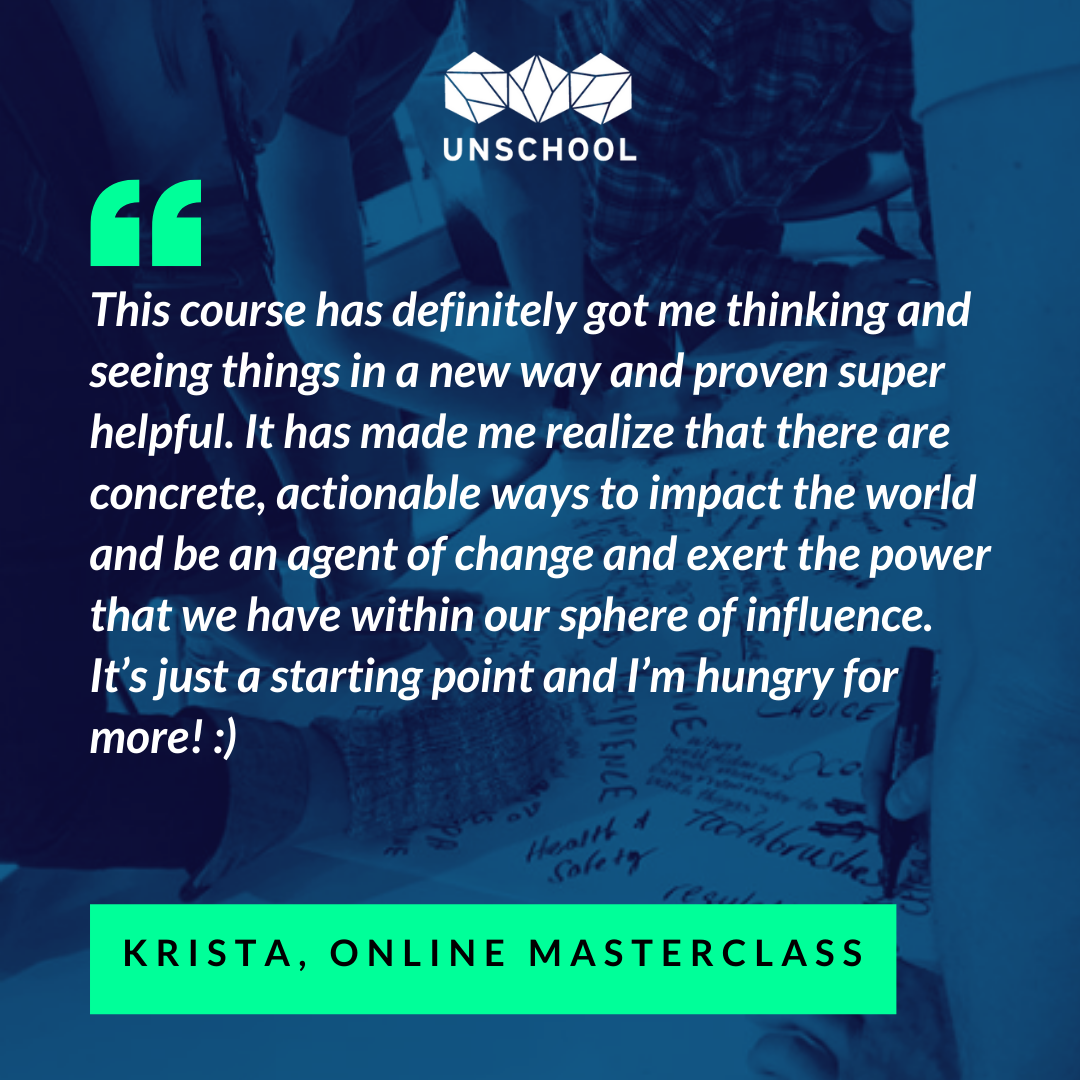




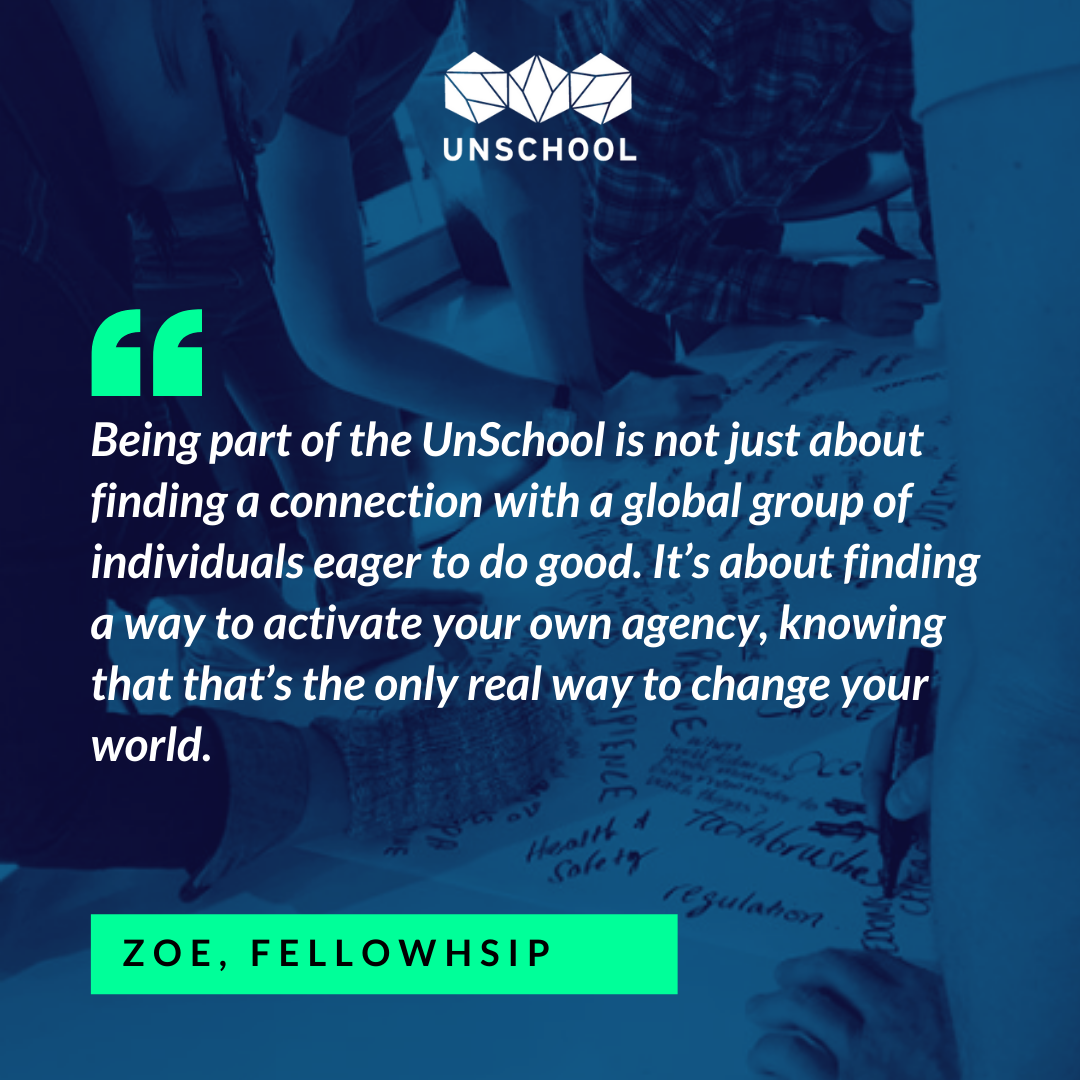
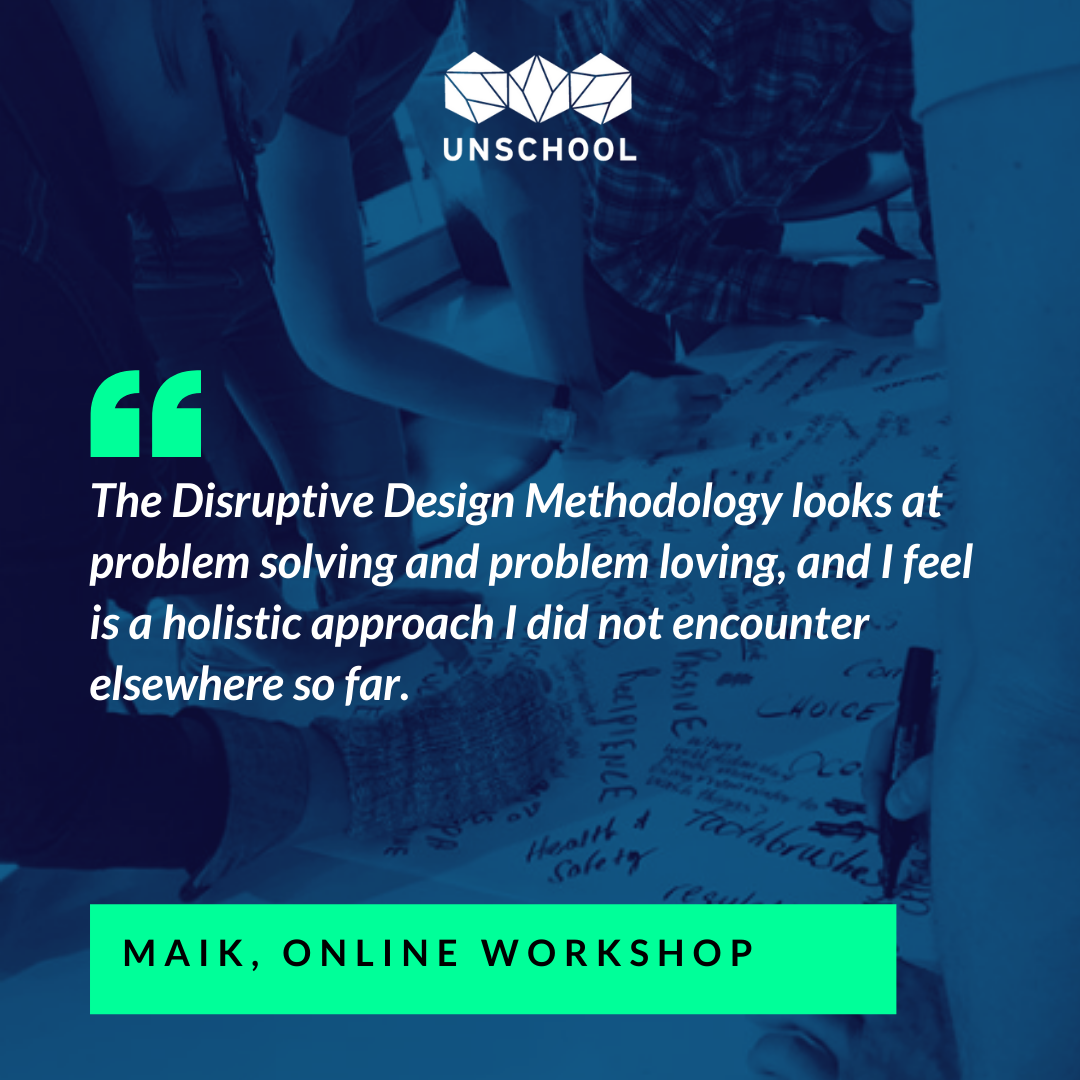

Five More Years! Five More Years!
By Leyla Acaroglu
5 years ago I started a school for adults to activate systems change and sustainability through design and creative problem solving. here is the 5 year birthday story, and what I hope happens next.
It was around five and a half years ago that I sat bolt upright in bed from a flash of an idea that had just woken me up. I grabbed a pen and scribbled on an old receipt: “UN-SCHOOL OF DISRUPTIVE DESIGN”. By the time I had gotten out of the shower and dressed, I had the full concept formulated in my head. I spent the next few weeks obsessively sketching out a pitch deck in InDesign, and the following weeks shopping it around for seed funding to places like Autodesk.
At the time, in late 2014, I was in the final stages of my PhD and the entire experience of doing it had somewhat scarred me on the reductive nature of adult education. This was combined with several years of experience in the ‘real world’ through running my first creative agency (Eco Innovators) and developing all sorts of design education tools and projects for advancing sustainability.
These experiences had taught me so much about just how broken the way we educate is, and I was also feeling pretty isolated in my personal goals of wanting to contribute to having a positive impact on the world around me. I had assumed that I was not the only one feeling this was, and perhaps that there were others out there who also wanted to activate creative ways of getting shit done in a positive way — so I set the intent to design something new that could have a global impact. That something turned into this, the UnSchool, and on September 5th we turn 5 years old.
I never did receive any seed funding, but I did channel all my energy, creativity and personal funds into building this crazy little intervention anyway. Today we celebrate many things — mainly that we have made it here to this milestone and made some creative change along the way, and plan on making much more positively distribute change!
Why start a school for adults?
For several years I had been teaching sustainability at all different age levels, going into primary schools and running programs at Universities as well. The one thing that was blindingly obvious to me was that many people were confused or overwhelmed by sustainability, and these feelings created a lot of inertia and resistance — mainly from the adults. The kids totally got it.
A few years before I started the UnSchool, I had been doing a project back home in Melbourne, where I had been invited into primary schools to teach an introduction to sustainability and life cycle thinking. I had developed interactive games for six year olds to learn about life cycle thinking by printing images of the life cycle stages of fun things like chocolate chip cookies, and stuck them to little cards so that they could work together to map the life of a product. The kids got the concept really quickly and would make insightful comments like, “The factory uses energy, which releases gasses into the sky that makes the weather change,” — all unprompted, I might add. I think it was the third or fourth school in a row when as I was leaving the class, the teacher stopped me and said, “This is so interesting! I had no idea about any of this stuff.” Another one had just told me she was so grateful I had come because she was so swamped that she just didn't have the time to do the research to be able to teach the content that was now required in the curriculum.
These experiences and many others I had been designing and running for young people became the inspiration for the creation of teacher support tools that were interactive and easy to use, like the Design Play Cards and The Secret Life of Things animations.
For years after this work, the teacher’s words still echoed in my head, and I kept thinking, If these people are teaching the young people, then who is teaching the teachers and the rest of the adults? After all, they are the ones with the power to make the changes that we need in order to bring about a sustainable and positive future. So, the idea of a school for adults, focused on experiential and immersive education that blew minds and supported rapid transformative change was born. The moment I finished the first draft of my thesis, I left Australia for the United States to start this crazy idea — which wasn’t really fully formed until that day I sat bolt upright in my bed (actually just an air mattress in a Brooklyn sublet).
A quick side note: the Secret Life of Things project won a Melbourne Design Award, helped change the high school curriculum in Australia to include life cycle thinking and sustainability, and ended up in the Leonardo Di Vinci Museum in Milan and the National Gallery of Victoria. I had such a small budget that I did all the voiceovers (yes they are terrible!) and I even enlisted my little brother for this one the final in the series!
The Pain and Joy of Starting Something New
The process of starting anything new is a combination of sheer panic, adrenaline, and massive amounts of courage. When I went to register the name The ‘UnSchool of Disruptive Design’ in New York City, the lawyer called to tell me that it was rejected by some authority unless I could get an official letter from the United Nations saying that we could use ‘Un’ in front of school, in case people thought it was a brand impeachment on the United Nations! Five years ago, I was not in a position to just call up the UN and get that kind of thing. So instead, I registered a company called Disrupt Design and a couple weeks later, threw a party in a gallery on 5th Avenue that I had managed to convince someone to lend me.
We invited anyone I had heard of from the design and social innovation community in New York (of which none I knew), and 150 people showed up (I even hired some buskers from the subway who later become friends). It was really a fantastic way to launch this project into the world. I had concepts up all over the wall and a giant interactive find-a-word poster for all the types of things the UnSchool and Disrupt Design stood for. But of course, I had no idea how I was going to do all the aspirational things I wanted to accomplish from the UnSchool, like challenge the reductive education system, support systems change within the design community, or normalize sustainability in a new generation of creatives.
All I knew was that I wanted to make change and help others to make change too.
Then mini program that we launched with in NYC in Sept 2014 (and the old website we had!)
I really was playing out the ‘fake it until you make it’ mantra of startups, accidentally as it was, but nonetheless, I had started this thing and had absolutely no idea how to make it work. Did I mention that since I had not obtained any start up funding, I only had a tiny bit of money that I had taken from my first company? The lack of funds was a pain, but also a great influence, as I had to be very creative and agile.
A couple years in, the lack of funds coupled with my strong equity access ideals meant that I really did need to find a way to sustain the UnSchool. So, I started to look again for investments via the startup channels I had in NYC, and I quickly discovered just how perverse the startup world can be. I had been approached by a couple of people who had seen my TED talk and were interested in what I was doing. After a few months of making pitch decks and being rejected for being too idealistic, or even worse, getting hit on, I decided the startup world was just another way of exploiting people and turning good ideas into things to extract all the value for individual gains. So I then decided that I would prefer to make change rather than money from the UnSchool — and if that meant making money elsewhere from giving talks and doing creative projects and then reinvesting it back into an equitable and integrity-based project, then so be it. It also inspired us to diversify the way UnSchool earned money, from just in-person programs to building the UnSchool online.
Early on the, we ran all sorts of provicational events to activate and explore the communities desire for positive change. This was for our Park Demolition Tea Party.
From day one, the most important thing that I needed was a space to host workshops and events, so I traded my time to set my school up in the Center for Social Innovation (CSI) in NYC. For the next six months, I spent two days a week as the “Innovator in Residence,” and the rest of the week I ran lunchtime classes on all sorts of topics I wanted to include in the Disruptive Design curriculum. I solicited feedback from the beautiful humans who showed up for them, and threw a bunch of random events and fun experiences to engage people with this concept of experiential, non-traditional educational and collaborative learning (not to mention sustainability, systems thinking, and design for creative interventions that make positive impacts).
To name just a few things we did in those first couple years: secret dinner parties in construction sites, drink and design nights in tech company offices, verbal fight clubs in dive bars, and park demolition tea parties... in parks that were about to be demolished. Sometimes lots of people came, and other times not so many, but each time I learned what people were interested in and found inspiration for the next thing. It was certainly very stressful, as there was never really any money after we bought the beer in a keg that could be returned to the local brewery (and transported it on the subway!), as well as purchased 100 reusable vintage glasses that I lugged around NYC to stick to my no-disposables rule. But without all of this early community exploration and building, prototyping, and discovering, I would never have created the beautiful thing that is the UnSchool of today. In the end, hundreds of people came to these early community engagement events, and we now share these tools that were refined during those times with our alumni who run similar experiential programs with their communities of changemakers.
Six months into building the UnSchool, I advertised our first Emerging Leaders Fellowship program to happen in NYC at CSI, where I was still the Innovator in Residence. I built the concept for this 7-day, adventure-based learning experience and popped it up online with very little explanation about what would actually going to happen, other than to call for all the creative rebels who wanted to activate their career in making change. Over 80 people applied from around the world! So many incredible people applied for that first program that I went from wanting 10 people to accepting 16, and that first Fellowship was magical.
Columbia University heard about it, came and interviewed me, and made a video as part of a research project on alternative education. Those 16 courageous people came to help build this thing, and every program since then, hundreds of people have come and helped build it even more, bringing their passion and curiosity and above all, their commitment to learning how to design a future that works better than today. The UnSchool is the sum of its parts — the people — which makes it a beautiful complex whole of creative humans willing to activate themselves to contribute to a more positive and sustainable future. This is the shot of optimism that I get every time I run a program or meet an alumni. Despite how messed up the world appears to be, it’s also filled to the brim with humans wanting to help change the status quo and get to a more positive future.
After that first successful fellowship in NYC, we went to Mexico City, then Melbourne, São Paulo, and then next was Berlin. During these first few Fellowships, I called on friends and previous creative colleagues to help produce these highly complicated programs. Then Christchurch, the sixth program, was produced by one of our alumni (at 7.5 months pregnant as well!), and from then on, so was San Francisco and Mumbai. Next, Cape Town, which was our ninth program, was run entirely without me! I cried when I watched the video of this magical thing being made by others.
This year in November it will be our 10th Fellowship in Kuching, Borneo, and it's our first non-major city Fellowship program, hosted by alumni from our Mumbai program. I could write a million words on the appreciation I have for all these humans that come to help make magic happen because they care about sustainability, equality, and a future that works better for all of us. But instead, I recommend that you watch a couple of the fellowship videos to get a sense of just how chaotic and wonderful they are. For me, they are pure chaos and joy with massive amounts of human-made magic.
From Fellowships to an Online Learning Lab, a Brain Spa, and More
Five years later, here we are. Hundreds of people have come to in-person programs all over the world and are out there doing cool shit (in fact, every year we partner with the Ellen MacArthur DIF festival to showcase just a few of the creative changemaking activities of our alumni). We have won awards, created incredible partnerships with the UNEP and others, and designed curriculums around our content for Finland, and now Thailand as well.
We have almost 10,000 people taking courses in our online learning lab and recently started the Brain Spa in Portugal. I am immensely proud of this crazy idea that turned into people from all over the world connecting and supporting change. The fascinating irony is that after doing all this work and building this thing that I couldn’t officially name, I ended up being named as a Champion of the Earth by UN Environment in 2016 for my work in advancing science and innovation for sustainability. And as life seems to offer you many moments of irony, now, as a result of this affiliation, many people DO get us confused with the UN! But we are excited by our collaboration between the UnSchool and UNEP to activate sustainable living, and proudly share any affiliation as we launch the creative intervention we designed called the Anatomy of Action — so you know, full circle!
But that doesn’t mean that we’ve not had our share of challenges and made our share of mistakes. I have cried at least 5,000 tears of frustration and joy at getting this thing up off the ground, with no external financial support whilst obsessively trying to maintain the integrity of the idea and diversity of people who had access to it. One of the biggest challenges is finding the resources to ensure we can offer the content to a diverse array of people, so that it’s not just those with financial means that can get further educated in these fundamental thinking tools for the future.
One of the models from the start has been to ensure that every program has scholarships and equity access, which we fund ourselves. Nowadays, many people get supported by their companies to come to our programs, so that enables us to redistribute some of these earnings into covering scholarships for others who don’t have financial support. I have almost gone bankrupt a couple times, but ensuring that the UnSchool is available to many different types of people is at its core. We have given away somewhere around $200,000 in scholarships to emerging leaders who would otherwise not be able to afford to attend a program like ours because equity is just part of our DNA. Along the way, some forward-thinking companies have helped out, supporting particular fellows from emerging economies, or sponsoring us with coffee or wine for programs (we are a school for adults after all!), but mostly we just eat into any potential profits, which means we are basically a very undesirable investment proposition!
But this project is not about making money; it’s about making change. I am really committed to supporting as many people as I can with our tiny-but-mighty team in uncovering the tools needed for making positive change. We offer value exchange internships, and anyone can apply for an equity scholarship for our online programs too. Obviously there are only so many programs we can run face-to-face, and even though I had initial resistance to online education, for the last two years, we explored, prototyped, and developed an interactive blended learning model that enables people to activate their leadership for change by equipping them with the tools they need to do so.
Another exciting development: we now have a certification system so that anyone who engages with our content can choose to validate their changemaking work and perhaps even go on to teach our method themselves!
The development process for our certification system was tough and long, as I wanted to ensure that it was not just someone sitting in their room watching videos, but instead that we had a mechanism for motivating local community action. This all resulted in our community activation points system that builds in many aspects of motivated community participation by encouraging people to do different things to gain the needed points for their certification level.
Our first approach was more of a pick-your-own adventure style system that didn’t quite work, as busy people need motivation, and many of the early adopters asked for more structure to support them moving through to a level they knew would validate them. So, I went back to some of the things that I had used to motivate me through my PhD and drew on the tactics I had developed to get me to the end goal (which was a challenge to say the least). Tools like a reflection and process journal, along with gamified tasks that I had set myself to apply new knowledge — these all helped inspire the version 2.0 of our certification system that we launched a few months ago, and now have many people tracking through!
The Practitioner, UnMasters, and Educator tracks are the outcome of these past five years and then some, teaching people how to activate themselves to make change. The format is designed to guide people through the complex content month by month, offering pauses and fast tracks. We are just about to certify our first few educators who then will be able to teach our content and run their own programs wherever they are in the world. The UnMasters is designed for career changemakers and entrepreneurs, and the Practitioner for people wanting to validate their skill set for creative change and positively disruptive design.
Future Thinking: Do I have to have a 5-Year Plan?
So what about the future? I am not into making five-year plans usually, but for the UnSchool, I do have one. In five years, when we turn 10 years old, I would love for the UnSchool to be obsolete. I hope that we have created a momentum and supported enough leadership and experiential learning provocations that others are taking the pedagogical approaches and ideas and seeding them in new and exciting ways. This is why the current certification model is so important, as I hope that with enough supported emerging leaders, we can create a continuum of change that evolves and expands exponentially until we have addressed many of our pressing problems in entirely new and unique ways.
On a personal level, I want to have disrupted the way we educate enough to ensure that the future of knowledge transfer is experiential and transformative, not reductive and linear, as it is so often the case today. I want to see that we design curriculums that are dynamic and hands-on, so that we equip people of all ages with the tools they need to agentize themselves in a world that needs creative changemakers as much as it needs bankers and engineers. I would love for a 15 year old to answer the question, “What do you want to do for your career?” with, “Be a creative changemaker and help design a future that works better than today,” and for that 15 year old to have that opportunity available to them, no matter where they are in the world.
And say in five years the UnSchool is still needed and we have not achieved these ambitious disruptive goals? Then I hope that the people who come to help build it each time will be more activated to continue to build it even more, be organized and inspired enough to take the ideas and spread them even further and deeper so that we can work toward solving some of the complex issues afflicting this beautiful planet that we all share.
What are the big challenges that we face in activating this change over the next five years? I see a bit of a battle in managing the digitalization of content, knowledge, and all the competition for attention that is going on as we move ever closer to a digitally-addicted age. I am not a Luddite; I love technology and all the life enjoyment that it brings. But there are a lot of trade-offs that we must contend with, and one such issue is the manipulation of digital social spaces by larger powers for the misdirection of people into more narrow pathways of thinking and doing. All of the platforms for social sharing seem to have converged along the same pathway of attention-seeking behaviors, and this is something I have grappled with ever since communicating ideas became about competing for attention in ever-more ludicrous ways in a saturated market.
So, our big question now is, “What does ethical and equitable communication look like?” And how do we do it when two giant companies, Google and Facebook, own most of the digital communication space and require you to ‘pay to play’, funnelling you evermore into a myopic view of the world and the ways in which you can get access to ‘your’ people? This is a big challenge for us and many more integrity-based organizations, as the system is designed to extract more of your time as a viewer and more of your capital as a producer. Understanding our digital carbon footprint and working toward sustainable and equitable digital policy is our new goal. We, like many others, just don’t understand the impact of our actions every time we upload an image to Instagram or release a new video. So we are working on that, and hope to have some way of sharing the learnings from this soon so that we can have more ethical intentions with our digital actions.
To start this transition, we developed a more long-form communication exchange through our weekly journal articles (which you are reading now!), in which we cover topics relevant to our community and highlighting the incredible inspiring activities of our alumni.
If the UnSchool has taught me anything, it is that everything worth doing requires work, and that the work you do teaches you how to do things better, or at least helps refine the way we each operate our life on this beautiful shared spaceship Earth. As I have mentioned in many interviews, one of the main reasons I ditched design school to become a sustainability-focused sociologist was because I had learned that everything was interconnected and that would mean I would have negative impacts without knowing it, which to me, seemed ridiculous. I know not all we do can be managed or controlled, and sometimes good intentions lead to not great outcomes. But we can throw our energy and creativity at the problems that persist in the world we live in, helping to etch away at them bit by bit so that we get to a place in the future, however far away that is, that is better, more equitable, sustainable, regenerative, and positive — otherwise, what’s the point?
What I have learned
Reflection is key to what we teach, so here is me giving myself a challenge to come up with the top five things I have learned from making the UnSchool:
Starting things is hard work, but everything worth doing requires work
Money does not always equal change; it helps, but change is valueless
It’s possible to get a lot of shit done in a small amount of time and still be energized by it, especially when you have good people to work with
Burnout is a real. It creeps up on you, and when it happens it hurts to have lost all the passion for what you do. But the solution is to rest and regenerate, and then get right back to it
There is no such thing as wasted time, just paths you go down that may not end up where you intended. But, the place you land will have some value to offer in getting you to where you want to be
AND a big thank you to all these INCREDIBLE humans!
The UnSchool is the outcome of the people who come to it and over the years we have had hundreds of amazing and inspiring people join us on our adventures into systems change, sustainability and social impact. Here are the cohorts from our 9 emerging leaders fellowship programs!
THANK YOU, TO EVERY SINGLE ONE OF YOU!
2015 New York Fellowship
2015 Mexico City Fellowship
2016, Melbourne Fellowship
2016 São Paulo Fellowship
2016 Berlin Fellowship
2017 Christchurch Fellowship
2017 San Francisco Fellowship
2017 Mumbai Fellowship
2018 Cape Town Fellowship
The Three Pillars of UnSchool’s Philosophy: Systems, Sustainability and Design
If you’ve been keeping up with our work at The UnSchool, then you already know that we are all about activating systems change for a sustainable future by design. We work with people of all professional and personal backgrounds to support the rapid transition to being an activated creative changemaker.
Our approach is deeply rooted in a philosophy of systems, sustainability, and design, forming three knowledge pillars that hold up all that we do. All of our programs, projects, and practices have systems thinking, sustainability sciences, and creative design solutions at the heart. These three pillars wraps up into the Disruptive Design Method, which is a scaffolding that enables people to think and do differently when it comes to understanding and working to help solve complex problems. In fact, we LOVE problems and embrace chaos and complexity at the UnSchool, helping others do the same!
In this week’s journal, we are exploring in more detail our three pillars of Systems, Sustainability, and Design.
SYSTEMS
The world is made up of complex, interconnected, and interdependent systems, starting with the most important life-sustaining systems of all, the ecological system, Planet Earth, which is made up of the billions of individual yet interconnected parts that form the magical whole that we are all a part of. Earth's natural systems provide every single living thing with the resources needed to exist, and thus, it is in our fundamental needs to create things that meet our needs within the opportunities and limitations of Earth.
We live within a set of complex social systems that subtly govern human society, from education to government and everything in between. Social systems are emergent outcomes of our collective desires for success as a species. Social systems breed the human-created industrial systems that work tirelessly to manufacture the needs of our desires, and yet so many of us are oblivious to how they work and what impacts they have. It's often at the point of these systems intersecting with nature, where we mine resources to obtain the raw materials required to make all the products we use, that we see many of our environmental and social problems evolve. The industrial system brings all the wonderful tools of modernity at the expense of the natural systems that we all need.
Understanding and working within the multi-level perspectives that systems thinking enables is fundamental not only for making change, but also for being an active participant in the world and the design of a future we all want to live in. We use systems mapping and life cycle mapping to explore these connections, and one of the key tools we use for this is the three systems at play map (see above). This particular map helps people identify the types of systems that we humans have designed, as well as how they connect to the industrial systems we have created to meet our social needs. Mapping connections here demonstrates the reliance and destruction of the ecological systems that sustain the rest of the systems.
Within the Disruptive Design Methodology knowledge set, there are several systems-based classes: Systems Thinking; Language, Influence, and Effect; and Systems Interventions.
SUSTAINABILITY
The ability to sustain life on Earth requires us to work within both the systems that nature evolved as well as the human-formed systems of society and industry. We all rely on natural systems for survival, which means that the imperative to enact sustainability is within all of us. No one can opt out of breathing, consuming nutrient-dense food, or drinking H20, so we are all implicated in figuring out how humanity can be a regenerative force on this shared planet, rather than continuing to extract and exploit the natural systems that sustain us.
The fundamental quest of our time is to figure out how to transform our global economy and society from a linear one based on value loss and waste creation to a circular economy built on regeneration, sustainability, and value-gaining systems. The knowledge and power we have acquired through the industrial and technical revolutions have formed the tension between nature and our human needs, but now we can transition to meeting our needs within the boundaries and systems of nature, if of course, we have the tools to understand, participate, and contribute back more than we take. That is the essence of the sustainability concept, doing more with less, and understanding how the planet works so that we can participate within its means and evolve from an extraction-based society to a regenerative one.
At the UnSchool, we embed sustainability into everything that we do, from post-disposable considerations in all our programs and our food philosophy through to our new farm-based rural regeneration campus. We don’t get everything right, but we are on a constant journey of figuring out how to do things in a more sustainable way; for example, we are currently exploring our digital footprint and developing a zero waste digital communication strategy as we recently discovered just how much of an impact each video watched and email sent has on our carbon emissions.
Learn more about sustainable practices in our Sustainability and Sustainable Design & Production courses.
DESIGN
Design is a powerful silent social scripture that surrounds us at all times; it influences our lives from the moment we are born until the day we die. Everything, absolutely everything that we encounter in our day-to-day interactions with the world is by design, and thus can be re-designed to meet our needs in more elegant, sustainable, and sophisticated ways. That’s why we have the Disruptive Design Method as a tool to support anyone being able to contribute to designing a future that works better than today!
To form usable goods and provide services, design takes all the materials and resources it needs from nature. Therefore, every action we take has an impact on the natural world, so designing better products, services, and systems is one of the critical tools for bringing about a circular, sustainable, and regenerative future.
Our current global condition of designing for disposability, overexploiting and undervaluing the raw materials and formed goods created in this industrial system perpetuates the unsustainability of our species, but through circular systems design, we can turn the tides on this trend. From this foundational perspective of design, we can approach the needs and reconfigure value to work within the natural systems that are required to sustain life on Earth, designing goods and services that not only meet human needs and desires in beautiful ways, but also add value back to the system that gives us all life, and support environmental regeneration.
The Three Pillars, Combined
The combination of these three pillars make up the foundational tools for thinking and doing differently, for understanding complexity, and for developing the propositions for a better future by design. With systems, sustainability, and design at our core, we design systems of learning and positive impact that maximize social, economic, and environmental sustainability through the understanding of the complex interconnected systems at play in the world around us. This enables us to design experiences that maximize positive change.
We translate these into all sorts of different things, reconfiguring our content and unique tools into learning systems like the Circular Classroom, our Fellowship Programs, and even our Living Learning Lab in Portugal. The beauty of having integrity-based models like this is that they hold regardless of the difficulties that you face, and for us at the UnSchool, our goal is to activate and equip people with the tools they need to agentize themselves to make more positive change in the world.
Agency is the outcome of learning applicable tools that you can activate in your world, and the one thing we need more of is people willing to take action to solve the complex problems we all face. If you are keen to make change, you don’t need to come to the UnSchool to do so, all you need to do is get started! But if you want to get the tools to make change, understand how to design positive interventions an be a force for good, then we have you covered at the UnSchool!
Systems Thinking 101
By Leyla Acaroglu
At the UnSchool, we have three core pillars that make up the foundation of all that we do: systems, sustainability, and design. The systems component is the ability to see the world for its dynamic, interconnected, interdependent, and constantly changing set of relationships that make up the complex whole. I recently shared just why systems thinking is such a powerful tool for effecting change, but a concept stuck in theory does little for the greater good. Understanding that everything is interconnected and being able to apply this knowledge as a tool for effecting change are two different things, and what’s most important is the practical experience plus the applied tools to turn theories into action. To move from ideas in the brain to practice in the real world, it helps to be equipped with the distilled and applicable knowledge about which tools can be used and how to apply these in ways that achieve the desired outcome — in our case, this is always positive social and environmental change. We have developed many simple applied systems tools, such as the systems mapping approaches, and to get you started on thinking in systems, let’s dive into the foundations of systems thinking!
How we See the World
The status quo of how we are all taught is to think in linear and often reductionist ways. We learn to break the world down into manageable chunks and see issues in isolation of their systemic roots. This dominant way of approaching the world is a product of industrialized educational norms – in one way or another, we have learned, through our 15 to 20+ years of mainstream education, and/or through socialization, that the most effective way to solve a problem is to treat the symptoms, not the causes.
Yet, when we look at the world through a systems lens, we see that everything is interconnected, and problems are connected to many other elements within dynamic systems. If we just treat one symptom, the flow-on effects lead to burden shifting and often unintended consequences. Not only does systems thinking oppose the mainstream reductionist view, but it also replaces it with expansionism, or the view that everything is part of a larger whole and that the connections between all elements are critical. Being able to identify relationships over obvious parts, seeking to decipher the dynamics of these relationships, and then being able to interpret the underlying models that created the relationships is the foundation of thinking in systems.
The Iceberg Model
Learning to Name and Define Systems
If you had to, what words would you use to define a system? Funnily enough, many important systems are easily identified by the word ‘system’ after them, such as respiratory, education, legal or mechanical systems. Systems are absolutely everywhere, of all manners, shapes, and sizes; from the intricate workings of your body (nervous, neurological, digestive, cardiovascular etc) to the infinite possibilities of space, our world is made up of interconnected and interdependent systems. We interact with many of these which helps us understand them intuitively, but so often is the case that we are unable to identify a system that is not obvious to us — like many of the indirect natural systems that keep us alive. This can explain a lot about how we have created so many of the environmental issues we face today!
A simple way to define a system is it will: be dynamic (constantly changing), be evolving (having emergent properties), and have a boundary (a definable limit to its internal components and processes). Systems are essentially networks made up of nodes or agents that are linked in varied and diverse ways. By using systems thinking, we identify and understand these relationships as part of the exploration of the larger systems at play. Everything is interconnected, every system is made up of many subsystems (of which even smaller systems make these up too), and then these are also all part of much larger systems. Just as we are made up of atoms with molecules and quantum particles, problems are made up of problems within problems! Every system is like a Matryoshka doll, made up of smaller and smaller parts within a larger whole. Seeing things in this way helps to create a more flexible view of the world and the way it works, and it illuminates opportunities for addressing some of its existing and evolving problem arenas. When teaching systems thinking, I like to explain this as the ability to look through a microscope at the tiny world that makes up all matter, as well as being able to shift to the telescope and see the infinite possibilities of space and the universe. In between these two opposite perspectives, you get a more three-dimensional perspective of how the world works.
Three Key Systems at Play
Although the world is made up of endless large and small interconnected systems, I define three key systems that make up the fundamental relationships between humans, the things we create, and our reliance on nature. These are the social systems, which are the intangible human-created relationships and culturally governing aspects such as education, government, and legal systems; the industrial systems, which include the physical infrastructure of roads, buildings, manufacturing systems, and products that allow us to function as a society and meet our human needs, and the natural systems that are the ecosystem services which allow for the other two systems to sustain themselves, providing all the resources for humans to survive and all the raw materials for our industrial needs. These three major systems keep the economy churning along, the world functioning for us humans, and our society operating in order (sort of, anyway!). This is, of course, a very anthropocentric point of view, one I define in order to enable people to see the deep reliance and misalignment we have with the natural systems at play. Whenever I run a workshop and we create a map of these, people often get stuck on naming all the ecosystems, but have no problem identifying social and industrial systems that they interact and rely on.
The fascinating thing is that the social systems are the rules and structures that make up our societies — the things that we humans have created to manage ourselves — and thus, can be reconfigured within generations. They are the often unspoken rules that maintain societal norms, rituals, and behaviors, all of which reinforce the unsustainability that we have created for ourselves. The same applies to the industrial systems — they are the outcome of our collective desires for speed, access, convenience, connectivity, success, status, cleanliness, and all manners of human desires and needs. The manufactured world is just that: created, and intentionally designed to facilitate the ever-expanding suite of human needs. However, the biggest and most important system of all, the ecosystem, cannot be redesigned or restricted without it impacting all the rest, yet we treat all natural services as though they are infinite and degradable. But clean air, food, fresh water, minerals, and natural resources need to be respected and shared with all species for the collective success of the planet.
6 Key Tools for Systems Thinking
Words have power, and in systems thinking, we use some very specific words that intentionally define a different set of actions to mainstream thinking. Words like ‘synthesis,’ ‘emergence,’ ‘interconnectedness,’ and ‘feedback loops’ can be overwhelming for some people. Since they have very specific meanings in relation to systems, allow me to start off with the exploration of six* key themes.
*There are way more than six, but I picked the most important ones that you definitely need to know. To dive deeper, check out my 'Tools for Systems Thinkers’ series on Medium.
1. Interconnectedness
Systems thinking requires a shift in mindset, away from linear to circular. The fundamental principle of this shift is that everything is interconnected. We talk about interconnectedness not in a spiritual way, but in a biological sciences way.
Essentially, everything is reliant upon something else for survival. Humans need food, air, and water to sustain our bodies, and trees need carbon dioxide and sunlight to thrive. Everything needs something else, often a complex array of other things, to survive. Inanimate objects are also reliant on other things: a chair needs a tree to grow to provide its wood, and a cell phone needs electricity distribution to power it. So, when we say ‘everything is interconnected’ from a systems thinking perspective, we are defining a fundamental principle of life. From this, we can shift the way we see the world, from a linear, structured “mechanical worldview’ to a dynamic, chaotic, interconnected array of relationships and feedback loops. A systems thinker uses this mindset to untangle and work within the complexity of life on Earth.
2. Synthesis
In general, synthesis refers to the combining of two or more things to create something new. When it comes to systems thinking, the goal is synthesis, as opposed to analysis, which is the dissection of complexity into manageable components. Analysis fits into the mechanical and reductionist worldview, where the world is broken down into parts.
But all systems are dynamic and often complex; thus, we need a more holistic approach to understanding phenomena. Synthesis is about understanding the whole and the parts at the same time, along with the relationships and the connections that make up the dynamics of the whole.
Essentially, synthesis is the ability to see interconnectedness.
3. Emergence
From a systems perspective, we know that larger things emerge from smaller parts: emergence is the natural outcome of things coming together. In the most abstract sense, emergence describes the universal concept of how life emerges from individual biological elements in diverse and unique ways. Emergence is the outcome of the synergies of the parts; it is about non-linearity and self-organization and we often use the term ‘emergence’ to describe the outcome of things interacting together.
A simple example of emergence is a snowflake. It forms out of environmental factors and biological elements. When the temperature is right, freezing water particles form in beautiful fractal patterns around a single molecule of matter, such as a speck of pollution, a spore, or even dead skin cells. Conceptually, people often find emergence a bit tricky to get their head around, but when you get it, your brain starts to form emergent outcomes from the disparate and often odd things you encounter in the world.
There is nothing in a caterpillar that tells you it will be a butterfly — R. Buckminster Fuller
4. Feedback Loops
Since everything is interconnected, there are constant feedback loops and flows between elements of a system. We can observe, understand, and intervene in feedback loops once we understand their type and dynamics.
The two main types of feedback loops are reinforcing and balancing. What can be confusing is a reinforcing feedback loop is not usually a good thing. This happens when elements in a system reinforce more of the same, such as population growth or algae growing exponentially in a pond. In reinforcing loops, an abundance of one element can continually refine itself, which often leads to it taking over.
A balancing feedback loop, however, is where elements within the system balance things out. Nature basically got this down to a tee with the predator/prey situation — but if you take out too much of one animal from an ecosystem, the next thing you know, you have a population explosion of another, which is the other type of feedback — reinforcing.
5. Causality
Understanding feedback loops is about gaining perspective of causality: how one thing results in another thing in a dynamic and constantly evolving system (all systems are dynamic and constantly changing in some way; that is the essence of life).
Cause and effect are pretty common concepts in many professions and life in general — parents try to teach this type of critical life lesson to their young ones, and I’m sure you can remember a recent time you were at the mercy of an impact from an unintentional action. Causality as a concept in systems thinking is really about being able to decipher the way things influence each other in a system. Understanding causality leads to a deeper perspective on agency, feedback loops, connections, and relationships, which are all fundamental parts of systems mapping.
6. Systems Mapping
Systems mapping is one of the key tools of the systems thinker. There are many ways to map, from analog cluster mapping to complex digital feedback analysis. However, the fundamental principles and practices of systems mapping are universal. Identify and map the elements of ‘things’ within a system to understand how they interconnect, relate, and act in a complex system, and from here, unique insights and discoveries can be used to develop interventions, shifts, or policy decisions that will dramatically change the system in the most effective way.
Although this is just the tip of the iceberg when it comes to systems thinking, the key takeaway is that ultimately, approaching life from a systems perspective is about tackling big, messy, real world problems rather than isolating cause and effect down to a single point. In the latter case, “solutions” are often just band-aids that may cause unintended consequences, as opposed to real and holistic systemic solutions. Looking for the links and relationships within the bigger picture helps identify the systemic causes and lends itself to innovative, more holistic ideas and solutions, for a more sustainable future that works better for us all.
——————————————————
If you are ready to dive deeper into the world of systems thinking, then you should take our Systems Thinking course online, or if you are a bit more advanced, then continue to leverage that knowledge in learning to design systems interventions in this course.
You can also explore the Circular Classroom, which is a free, multilingual educational resource accessible to anyone but designed specifically for students and teachers alike to integrate circular thinking into high school and upper secondary classrooms, all packaged up in a fun, beautiful format. It offers the opportunity to think differently about how we design products, how the economy works, how we meet our needs as humans, and how to support the development of more creative professional roles that help to design a future that is about social, economic, and environmental benefits — and of course, this all begins with a systems mindset.
I explain in detail how to do many applied systems thinking practices in my Circular Systems Design handbook, and we run in-person programs at the UnSchool that equip people to become applied systems thinkers for enacting positive change in the world.
Are we exploiting empathy?
By Leyla Acaroglu
Empathy, a term that was first brought into the English language in 1908, has become somewhat of a hot topic in design and business circles of late. A key part of the process of design thinking and human-centered design, it seems that “more empathy” has become the go-to solution for a myriad of problems, becoming a key part of the mainstream conversation around improving relationships and making better products and services. From better leadership, improved bedside manner for doctors, more progressive politics, and a fix for social crises like refugee relocation and homelessness, the call for more empathy is everywhere. Some schools, like this one in Denmark, are even teaching empathy in their curriculum in hopes of creating happier, kinder adults. But with considerable ethical and social implications, empathy as a tool for engaging with humans is a bit of a complex space, one that offers up many ethical issues that need some deeper exploration of this all-too-human experience.
What is empathy, and how does it affect the human experience?
By now, you may have already seen Dr. Brene Brown’s work on empathy, especially since she has a new Netflix talk out at the moment that also dives into shame and compassion. If you have never heard of her, then you should at least check out the short video below, which illustrates the difference between empathy and sympathy and highlights the pitfalls in getting these valuable human experiences mixed up.
Empathy is defined as the ability to feel, see, and understand the feelings of others. But empathy has a very clear physiological and neurological side to the experience (which, by the way, is a fascinating scientific process). We connect with the feelings of others because we are social beings that benefit from empathizing with those around us. In fact, our brains have mirror neurons, whereby our minds mimic the actions and facial expressions of those people we see and interact with so that we are more connected.
Evolution has served us well when it comes to ensuring that we connect with our fellow humans. You may be one of those people that feels like vomiting when you see someone else doing it, or perhaps tears well when you hear of a friend’s pain. These are all triggered by the vagus nerve, which supports the biophysical reaction that makes up the empathetic responses we have. The vagus nerve runs down the spinal column and connects the emotional center of your brain to all the primary organs in your body, which then interprets things you see into feelings that trigger physical reactions — like vomiting or crying, or even that pang your get in your guts when you hear of a tragedy that doesn't affect you, but you can feel the loss and grief of others.
Empathy is a cornerstone of the mammalian experience (humans are not the only ones who show prosocial behavior connected to empathy!), as it supports social bonding and builds connections by helping to identify with another’s pain or pleasure so that we can find common spaces and provide support when needed. However, there is a rising trend in misusing this powerful human connection tool to sell more products.
Exploiting Empathy
Google search ‘empathy map’ and you will find a simple canvas used by design and marketing teams that doesn't really involve engaging with real humans most of the time. Instead, it is used to imagine a potential customer’s emotional space in relation to your product or service. Stage one of the design thinking process is to empathize with your ‘user’ by way of basic interviews and ‘putting yourself in the shoes of others’ by observing and gaining insights into how they feel or think of whatever problem you are attempting to solve. You can read more about the process in over at IDEO or d.School.
This approach to empathy has it diluted down to the sum of its parts — not as a complex holistic experience that considers the emotional, physiological, and deeply critical interpersonal experiences which have effects on people's emotional states and worldviews. Instead, it’s being leveraged to exploit people’s needs in order to sell them more stuff — stuff they may not actually need, nor perhaps can afford, because when we feel like someone understands us and we feel connected to them, we are more likely to connect with what they are trying to get us to buy. Not all empathy building is sinister by any means; much of it is done with good intentions to understand the human experience so that better services can be designed. But there certainly is a host of ethical conundrums that are evoked when empathy is used more so for extraction than for amplification of compassion and intercommunity understanding. There are many different opinions and critiques on design thinking that are worth the read (see here, here, here and here). Touted as the future of sales, with the ability to ‘empathize’ in the design thinking way, empathy can be used to find hidden desires and manipulate these into purchases, which unfortunately plays right into the systems failure of the hyper-consumption loop that has led to so many negative impacts in the first place and continues to create unintended consequences.
Does Empathy Promote Human Connection?
I did a project a few years ago exploring leadership and specifically looking at why there are so few female leaders in the design sectors, despite the high rate of female graduates from design programs. I use the Disruptive Design Method for all my work, and in the mining phase, I conducted 30 face-to-face, semi-structured interviews with men and women from within the design industry. I asked them all the same starter question and then allowed the 20 minute conversations to flow based on their reactions. I collected data by touch typing their responses instead of recording them so that they felt more comfortable sharing their stories. As a sociologist, I am hyper aware of the power of asking questions, since questions triggers all sorts of emotional reactions in the interviewee and can open up old wounds or trigger entirely new avenues of thought. As such, respect and consideration need to be held by the questioner. In my case, I felt so many connections with the stories and experiences of the people in front of me that, as a researcher trying to understand the experiences of others so that I could interpret a potential place to intervene to support changes, I ended up identifying a lack of empathetic understanding as a tool for shifting the status quo on this problem arena.
But for me, this was the critical thing: this was not just about a lack of empathy toward women — it was a two-way street. People just didn't understand the conditions and experiences of the other gender; thus it reinforced this inability to provide equitable access to resources such as mentoring, emotional support, time off for childcare, etc. Men told me of being seen as being lazy for wanting to leave early to hang out with their kids, and women found it hard to break into a Friday evening drinking circle because it just wasn’t their type of good time. Either way, everyone was stuck a little bit in their own understanding of the world, so in the context of allowing people to flourish in the workplace, building connections between genders, different age groups, and cultural diversity was a point of intervention that I felt could be leveraged to increase leadership opportunities in creative industries.
So, I developed this Gender Equity Tookit… however, I may have been wrong. I tested the activities with hundreds of people and found, in the moment, increased levels of understanding, empathy, and connection — but I have no idea if this will affect anyone's lives when it comes to work opportunities. I believe the ability to understand others in whatever ways we can is a powerful approach to effecting positive change, but I also worry about the risks associated with one-dimensional empathy building, which leads me to the wider questions around the limits to empathy as a tool for affecting change.
Limits to Empathy
A decades long study by Sara Konrath on the empathy levels of young people in America has shown that since the 2000’s, empathy has started to decline by around 40%, with many people saying it is not their responsibility to help other people in trouble. For some people, being empathetic is a problem; being able to feel other people’s pain can be debilitating, as it’s exhausting and can lead to a surge in the stress hormone, cortisol, and can even result in bad decision making.
In our current media landscape, where many agents are competing to milk your emotions through the algorithmic cycle of serving your own interests (like most social media platforms now do), we see just how easy it is to be drained by the pull on our empathetic responses to others’ pain and suffering. Click on a story about a child cancer survivor, for example, and the next time you are online, you are served more heartbreaking stories of children's illnesses. This uptick in feeling empathy-induced stress has led to the coining of the terms “empathy burnout” and “compassion fatigue.”
There are counterarguments against empathy, such as the those put forth by psychologist Paul Bloom, who argues that because empathy creates a hyper focus on one individual that we identify with, it distracts us from feeling connected to bigger issues. There was this story that emerged after the disastrous earthquake that hit Mexico City in 2017 — the story of a small girl being trapped under the rubble of a school that had collapsed. The entire country was gripped with hope and anxiety when authorities announced that Frida Sofia was rescued from the rubble, only to find out days later that the entire story was made up. The backlash to this hyper-focused collective empathy was profound, especially since this same false story line had played out in the 1985 earthquake.
Adam Waytz provides other areas of concern regarding empathy. Writing in the Harvard Business Review, he says, “Failing to recognize the limits of empathy can impair performance,” arguing that it is a zero-sum gain, where the more empathy you expel in one area, the less empathy you have left for others, and critically that in itself can erode ethics.
Ethics can be misguided by empathetic responses, especially when paired with the cognitive biases we all have that support our brains categorizing and preferencing people akin to ourselves. Empathy can absolutely be exploited — and in some cases, weaponized — in order to dehumanize others. We’ve seen this play out in the political theater of the last five or so years, for example, as right-wing populist candidates have come to rise around the world. One of the common denominators among these politicians is their use of “othering” techniques that utilize empathy for some victims and not others. They evoke a sense of hate toward some victims (such as the parents of school shootings) and portray them as liars, thus othering them. This results in what’s been called selective empathy, which not only creates division, but it also creates a major distraction around important issues that the world so desperately needs to focus on, like climate change, poverty, clean energy — basically all of the UN’s Sustainable Development Goals.
The Ethics of Empathy
So is empathy a useful tool for effecting change? Yes. Is it a tool that can be misused or exploited? Yes. Can empathy create more problems than it set out to solve? Yes, yes, and yes. When used as a core part of decision making, consciously or not, empathy can lead to positive, negative, and even immoral outcomes.
So what should we do with empathy? Use it well. Like any knowledge, knowing how something works should inform us on how to ensure we use it well, with respect and integrity, which is critical in the case of empathy. This means empathy should always be served with a good helping of ethics. Considering the ethical implications of triggering an empathetic response, or extracting responses based on empathy triggers in people, should, like all other aspects of our social conduct, be used in ways that don't manipulate, exploit, or create suffering in those around us. Of course, this Utopian view of ethical empathy use is far from the reality, but the case for ditching the fake one-dimensional version of empathy used by marketing and business development people is the first step in getting over the tragic empathy milking that occurs in the name of sales and profits. And for our day-to-day interactions with other humans, perhaps we should leverage compassion instead.
-----
At UnSchool Online we offer a host of deep dive classes into topics like ethics and empathy, cognitive bias, and systems thinking. You can also to level up your leadership and creative change making skills.
Unlocking the Power of Systems Thinking
By Leyla Acaroglu
I have long been a fan of showing how problem solving desperately needs systems thinking. If you are familiar with my work, you may have already seen the series I wrote on Systems Thinking, but let me share the personal experience in how I came to uncover the power of thinking in systems, the insights that I gleaned from seeing the world through a series of interconnected systems at play, and some reflections on how this has helped me make more positive change through my creative work.
I first encountered systems thinking as a practice around 8 years ago just as I started my PhD, and it completely blew my mind. I was going a bit mad at the time, as researching a PhD tends to result in some strange deep dives into all sorts of tangential aspects of your professional practice. At that time, I was exploring many of the adjacent fields to my actual area of study — sustainable design. This could otherwise be called procrastination, but I like to call it productive distraction. Days would start with looking into some more sustainable material processes and then I would end up looking into fractals, Newtonian physics, reductionisum, Lakoff’s work on metaphors... and then somehow in one of these Internet binges, I ended up in the world of systems and the fascinating transition from the mechanical worldview (thanks in part to Newton) through to the evolution of biology as a field of science which helped to form the foundations of understanding the interconnected systems that make life possible, which in turn helped to form the field of systems dynamics.
I then realized just how mechanistic my own thinking was, and in turn how this dominate worldview, that the world operates like a well-oiled machine, was supporting many of the reductive and damaging practices that sustainability was trying to resolve. So doing something about that became a new priority, and still is to this day.
Everything is interconnected
I remember spending one particular weekend locked in my apartment, watching every single documentary I could find about fractals, self-similarity, and the science of interconnectedness and basically nerding out on the relationships between everything. I found this beautiful introduction by Kauffman, and it was like a Disney movie in my mind where all the pieces of a puzzle magically came together in a Gestalt-esque moment of interconnectedness. I had been existentially grappling with how to rationalize the randomness of so many of the problems/issues that I was wanting to be apart of changing, and then it all just slotted into a place as I started to see that everything as part of interconnected, interdependent systems, and that we are all affected by, and in turn, influencing them.
To say my brain fell in love is an understatement.
Hungry for more, I went on a knowledge scavenger hunt finding Russell Ackoff’s videos on YouTube (I consider him the best speaker on systems thinking. Ever.) and reading Peter Senge, Donella Meadows, and anyone else who had written on the topic in the last 25 years (quick side note, biologist von Bertalanffy, is credited as coming up with general systems theory, however did not uncover his work much later on).
All this cemented the realization that everything was interconnected and that in order to leverage creativity while working in sustainability — actually, in order to do just about anything — one needs to know how to see, identify, and think in systems. It also made me acutely aware of the diversity of explanations and approaches to systems thinking. Some are super obtuse and hard to penetrate, leaning more towards the engineering side of things, whereas other theorists are more lenient on their readers, prioritizing clarity rather than complexity (even though complexity is a critical part of systems thinking!). Take Meadows, for example — a fantastic systems thinker, but the entire first chapter of her book focuses on bathtubs as an analogy for systems dynamics. It might just be me, but it really did take some time for my brain to get what she was saying! And now? Well I can’t get in a tub without thinking about stocks and flows!
So started my love affair with this practice and my desire to figure out how to bring it into the design world. I developed a class for the university I was teaching at called ‘Systems Thinking for Designers’, and my students and I looked at how systems thinking could positively impact the design process.
Then, through my PhD, I began exploring nodal transfers as a theory of change and overlaying this new holistic worldview with my training as a sociologist. Years earlier, I had started to work in the extrapolated version of life cycle assessment, life cycle thinking, so adding the systems element to the understanding of how things impact each other in the linear supply chain was really empowering. Suddenly, the everyday impacts of how material flows were intersecting with the cultural layers of social interactions, the power plays, and the systems dynamics all become more accessible as the transition to focusing on relationships and non-obvious elements in a system become more prominent for me. I really could see how the multi-layers of social, industrial, and ecological activities intersect, impact, and, ultimately, change one another.
Fast forward a few years, I had finished my PhD (thank gosh) and founded the UnSchool of Disruptive Design in NYC. I now had the big challenge of distilling all these years of research, into engaging, shareable, and practical tools that would support others in picking up the systems mindset. I started to develop all sorts of systems mapping activities for workshops and refined the ones we now share — cluster mapping and the adapted interconnected circles maps. I advanced my life cycle thinking activities, as well as added X-maps into the mix, and now we have a suite of tools at UnSchool Online that thousands of people around the world use to help them learn to love a problem, see the relationships before trying to solve said problem, and identify the areas where they can intervene within their agency and resources.
For me though, the most powerful thing is the moment when your brain just starts to see systems rather than the obvious things that we are trained to see. Sounds cheesy but it is really a superpower that anyone can access with a bit of training and overcoming the reductive mindsets that we were all taught in our linear education systems.
In order to overcome the global issues we are challenged with, we need to change the linear, reductionist, status quo abiding thinking that reinforces breaking the world down into manageable chunks that can be controlled, where issues are attempted to be dealt with in isolation. What we need is to shift from a linear and reductionist dominant mindset to dynamic circular systems thinking.
Why Systems Thinking is So Powerful?
Right now, there is no shortage of big complex messy social, political, and environmental problems that need to be addressed, from climate change to the rise in racism, homelessness, child exploitation, global politics and climate change. Taking a systems approach allows for a dynamic and intimate understanding of the elements and agents at play within the problem arena, enabling anyone to identify opportunities for intervention.
These tools are critical to overcoming the reductive mindset we were all taught in school — a mindset that teaches us to break the world down into individual and manageable parts, rather than see the complex, interconnected whole. But here’s the thing: problems never exist in isolation, they are always surrounded by other problems. The more you can comprehend the granulation and context of a problem, the greater your chances are of finding a truly effective solution that is within your capacity to enact. Problems are just unaddressed opportunities waiting for a creative mind/s to tackle them.
The good news is that undoing linear and rigid thinking is pretty easy because, thankfully, humans naturally have a curious and intuitive understanding of complex, dynamic, and interconnected systems that make up the world around us. So, it’s really not that hard to rewire the thinking codes from linear to expanded, from 1-dimensional to 3-dimensional thinking. It’s one of the reasons I developed the Disruptive Design Method, which is a three-part approach to learning to love problems and dive under the obvious to explore the dynamics of an issue before attempting to build a solution to address it.
The three stages of the DDM are Mining, Landscaping and Building
Leadership and Systems Thinking
Without a doubt, the best leaders and problem solvers are systems thinkers, as they are naturally seeking out how parts fit within a complex whole and looking for the interconnectedness of issues and elements within a system. Understanding that the health of a system is defined by its diversity means that we avoid designing homogeneous systems, and instead we see flourishing complex robust systems. Furthermore, leaders who possess a systems mindset are more flexible and divergent in their solutionizing around issues that they face; they embrace curiosity and ask questions before trying to provide answers. As a result, outcomes are less likely to lead to unintended consequences or transference the issue to somewhere else in the system (shifting the burden). When solutions are systemic in nature they address the root cause instead of the obvious symptoms of a problem set. Critically, they know that the smallest part of the system has the power to make the most change, the challenge is finding that sweet intervention spot.
In short, systems thinking helps unlock creativity and provide a fertile breeding ground for completely flipping your mind upside down and inside out, in the best possible way. Embracing this systems approach will help you evolve problems into effective, sustainable solutions and empower your agency to affect positive change.
Future Thinking
I truly believe that thinking in systems is the one core skill needed for being a leader in this next century. There is a strong relationship between the reductive linear economy that is causing so much of the ecological and social exploitation and the reductive thinking that currently dominate our companies and governments. I see the failures of GDP and the non-inclusion of environmental services in our economic system. I can see how recycling validates waste, and that laying blame outside of our jurisdictions helps us all avoid making change.
No matter how big the problem, the complex problem-loving mindset that systems thinking has given me is like a secret weapon of hope and possibility against all the negativity and merchants of doom that increasingly dominate the media landscape. When there is no blame, there is so much space for exploration, curiosity, and creativity. Personally, I think one of our biggest challenges of our time is the collective hope deficit, and embracing systems thinking helps to overcome that.
The tools included in the Disruptive Design Method help me rise above the despair (right after I have had a good cathartic complaint session first), but the possibility for change is just as real as the catastrophic predictions, because everything is interconnected, the future is undefined, and the possibilities for creative change are endless — if you just know how to see, value, and work within the systems that sustain us all.
My hope for the future is that we, as societies, start to embrace more complex understanding of the world we have the pleasure of living in, that we see systems instead of silos, and adopt changes to education universally that teach the tools for the future, not the past and that we find ways of being a regenerative force on this beautiful magical planet we all share.
I’ll leave you with 6 insights that I have gleaned from embracing a systems mindset that hopefully will pique your curiosity and help you to fall in love with systems thinking like I did:
Everything is interconnected. There is no blame because everything is connected to everything else
Today’s problems are often a result of yesterday’s solutions
You can’t solve a problem with the same thinking that caused it
Easy solutions can lead to negative impacts elsewhere
The easy way out often leads back in
Systems are dynamic and constantly changing, and therefore we can all change them too!
---——
Where to get started? I have written a short 11 Key Principles of Systems Thinking. You can also take our Systems Thinking course online and then continue to leverage that knowledge in learning to design systems interventions in this course.
You can also explore the Circular Classroom, which is a free, multilingual educational resource accessible to anyone but designed specifically for students and teachers alike to integrate circular thinking into high school and upper secondary classrooms, all packaged up in a fun, beautiful format. It offers the opportunity to think differently about how we design products, how the economy works, how we meet our needs as humans, and how to support the development of more creative professional roles that help to design a future that is about social, economic, and environmental benefits — and of course, this all begins with a systems mindset.
Apply to join our 7-day adventure into systems thinking, sustainability and design as tools for activating positive change with our fellowship program happening this November in Kuching, Malaysia.





